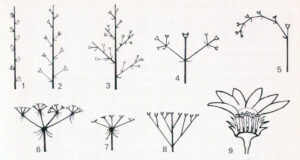Kaj Halberg - writer & photographer
Travels ‐ Landscapes ‐ Wildlife ‐ People
Flora of the Alps and the Pyrenees
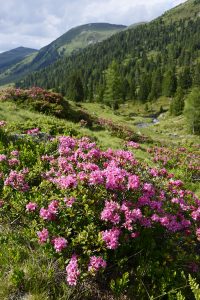
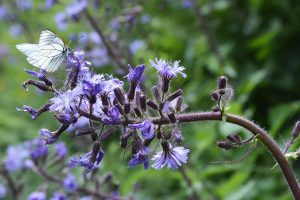
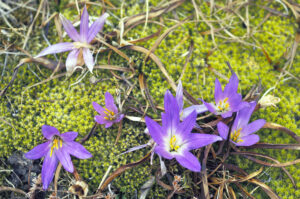
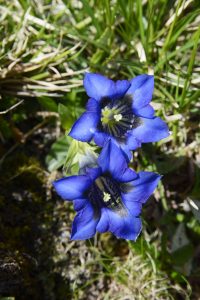
The Pyrenees is a mountain range in southern France and northern Spain, extending nearly 500 km from near the Atlantic Ocean eastwards to just north of Cap de Creus on the Mediterranean coast. The highest peak is Aneto (3404 m), in the central part. Most of the way, the main crest of the range constitutes the border between Spain and France, with the small independent state Andorra situated between the two countries.
Both mountain ranges are home to an astounding number of seed plants. No less than c. 4,500 species have been encountered in the Alps, of which c. 360 are endemic, whereas the Pyrenees is home to about 3,500 species, of which c. 200 are endemic. These numbers, however, include all species growing in the lower valleys, many of which are widespread in Europe.
Paula Kohlhaupt’s way of taking pictures of plants in their natural surroundings was very inspiring. In many of the pictures, the background was dramatic rock faces or mountain slopes, and if the plant was depicted close-up, she saw to it that the background or other elements would not disturb the motive.
During my first botanical travels to the Alps, in 1968 and 1970, I tried to take pictures in a similar way. As a rule, however, the result was poor, mainly because I would often fail to notice disturbing elements in the pictures. Later, my attempts improved, and the pictures on this page show a selection of my photos from later trips to the Alps, and a single late-summer visit to the Pyrenees.
Below, the plants are presented alfabetically according to family name, genus name, and specific name. At the bottom of the page, some botanical terms are explained.


The inflorescence of these plants is very distinctive, consisting of a compact globular umbel on an unbranched stem. Initially, the umbel is enclosed in a papery spathe, which splits into lobes, when the stalked flowers unfold.
The generic name is the classical Latin name of garlic (A. sativum), described on the page Plants: Plants in folklore and poetry.
In the Alps, it grows up to elevations around 2,800 m.
This plant is rich in vitamins and was formerly also widely used as a medicinal herb, mentioned as early as in 1543 by German physician and botanist Leonhart Fuchs (see below).
It also has its role in folklore. In Strasbourg, in 1669, an herbal witch mentions that if a cow had been bewitched and did not give milk, you must stroke it three times with a chive bulb, while saying: “Oh, dear cow, give me my milk, which is so good for me, and which our dear Lord Jesus Christ has given me.”
The specific name is derived from Ancient Greek skhoinos (‘rush’, genus Juncus), and prason ‘leek’, thus ‘rush-like leek’, naturally referring to the shape of the leaves.
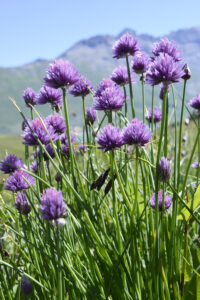
For 2 years, he practiced as a doctor in Munich, until he was offered the chair of medicine at the University of Ingolstadt. This university was firmly Roman Catholic, which created problems for Fuchs who had Lutheran views. Therefore, in 1528, he accepted a position as personal physician to Georg der Fromme (George the Pious, 1484-1543), Margrave of Brandenburg-Ansbach, who was a Protestant.
In 1533, Fuchs was called to Tübingen by Ulrich (1487-1550), Duke of Württemberg, to help in reforming the University of Tübingen in the spirit of humanism. Here, he served as professor of medicine for the rest of his life, and he also created the first German garden with medicinal plants.
He published a large number of books on medicinal issues, and also two major botanical works. De historia stirpium commentarii insignes (‘Notable Commentaries on the History of Plants’) was published in Basel in 1542. This work includes about 500 medicinal plants, of which more than a hundred had not been described before. The concomitant illustrations are detailed and lifelike. In 1543, it was translated into German, titled New Kreüterbuch.
The other book is Codex Fuchs (Codex Vindobonensis Palatinus), published in 9 volumes in Tübingen 1536-1566. This work contains 1,529 coloured plates, depicting medicinal plants.
The major part of the information above is from the website en.wikipedia.org/wiki/Leonhart_Fuchs.

The specific name stems from a Medieval German name of the species, Siegwurz (‘root of victory’). Another old German name was Allemannsharnish (’all people’s armour’), referring to the onion, which is wrapped in a thick layer of bracts. In the Middle Ages, this layer was likened to an armour. Alpine leek was carried by soldiers as an amulet, as it was believed that it would protect the bearer from being wounded.
In his illustrated herbal Neuwe Kreuterbuch (from 1588), German physician and botanist Jakob Dietrich (1525-1590), also called Jacobus Theodorus, but better known under the name Tabernaemontanus, remarks that Alpine leek protects from “all kinds of ghosts and bad spirits.” He continues: “Farmers and herdsmen praises it highly as a protection against all kinds of bad air and vapours.”
The plant was also utilized by Bohemian mine workers as a charm against ‘unclean spirits’.
When building a stable in Vorarlberg, western Austria, a cavity was drilled in the lowest beam, and a bulb of alpine leek was placed in it, which would protect the cattle against being bewitched.
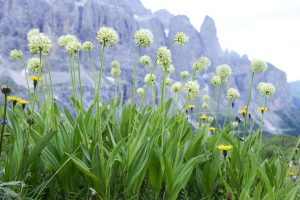
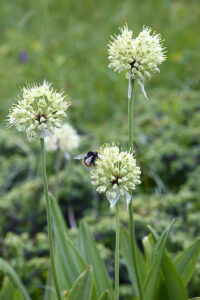
The inflorescence of this family is unique. In almost all species, the flowers are arranged in terminal umbels, which may be simple, usually with bracts at the base, and each of the stalks, the so-called primary rays, ending in a flower. More commonly, the umbel is compound, consisting of a number of primary rays, each ending in a secondary umbel. Each of these umbels usually has small bracts, bracteoles, at the base, and a number of secondary rays, each ending in a flower. Usually, the secondary umbels together form a flat-topped inflorescence, mostly with white, yellow, pink, or purple flowers, rarely blue or bright red. The flowers have five petals and stamens. This also accounts for the sepals, if they are present. They are usually missing, however.
The family name is derived from the name of honey bees, genus Apis, referring to the fact that many plants of the family are much visited by bees and other nectar-sucking insects, in particular hovering flies.
The generic name is derived from the Latin angelicus (‘angelic’), originally from Ancient Greek angelos (‘messenger’), alluding to the healing power of garden angelica (Angelica archangelica). One Middle Age legend has it that an angel had a dream that this herb would cure the plague. According to another legend, angels – or even Archangel Gabriel himself – brought the knowledge of this herb to humans. The medicinal usage of garden angelica is described on the page Plants: Plants in folklore and poetry.
The specific name is Latin, meaning ‘of woods’. However, it is more commonly growing in open areas, including hedgerows, marshes, and edges of woods and fields.
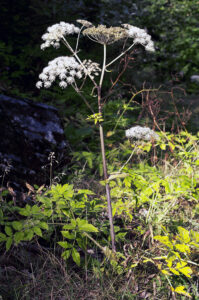
The generic name is derived from the Latin aster (‘star’), alluding to the open, star-shaped bracts of the inflorescence. The common name is derived from the Latin magister (‘chief, teacher, leader’), alluding to the medicinal usage of the genus. This name also refers to another umbellifer, Peucedanum ostruthium (below), which was once likewise much utilized in traditional medicine.
This species is native to the eastern half of the Alps, where it grows in woodlands, shrubberies, clearings, and along streams, usually on calcareous soils. It is found up to elevations around 2,300 m.
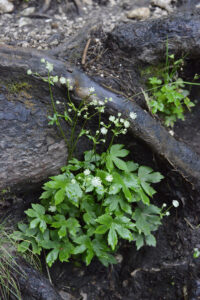
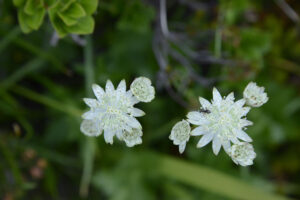
This species is native from the Pyrenees eastwards across the Alps, the Carpathians, and the Balkans to Turkey and the Caucasus. It was introduced to the British Isles in the 16th Century and has become naturalized in several areas. Its natural habitat include montane meadows and other grasslands, forest clearings, and streamsides, usually on calcareous soils. It has a wide altitudinal distribution, found from the lower valleys up to about 2,300 m.
The specific name is Latin, meaning ‘greater’, alluding to this plant being larger than the lesser masterwort (below).
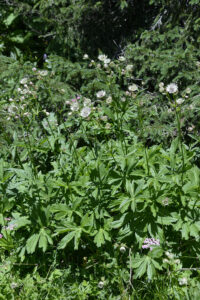
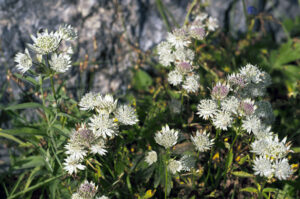
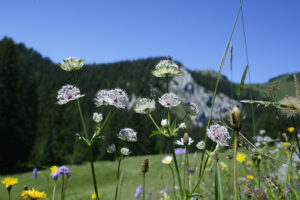
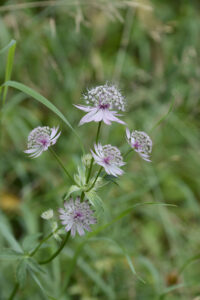
It is distributed in the south-western Alps, the northern Apennines, the Pyrenees, and in the northern Iberian provinces of Catalunya and Huesca.
The specific name is Latin, meaning ‘smaller’, indicating its smaller size compared to the previous species.
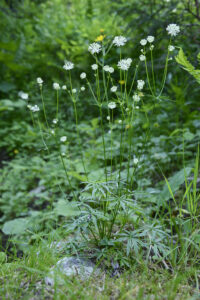
The generic name is derived from Ancient Greek bous (‘ox’) and pleuron (‘rib’), alluding to the shape of the roots. The name hare’s-ear refers to B. rotundifolium, whose leaves resemble a hare’s ears, whereas thoroughwax is a corruption of a German name of these plants, Durchwachs (‘growing through’), alluding to the stem of some species, which appears to grow through the leaves.
The roots of several species of hare’s-ear are an important ingredient in the traditional Chinese medicine chai hu, utilized for a huge number of ailments, including respiratory problems, dizziness, menstrual irregularity, cough, fever, and influenza. The name literally means ‘kindling of the barbarians’. Presumably, some Chinese observed the ‘barbarians’ using dried hare’s-ear stems as kindling.
This species is widespread in montane areas, from the Pyrenees eastwards to Poland, the Czech Republic, and the northern parts of the Balkans. In the Alps, it may be encountered up to elevations of at least 2,100 m.
The specific name is Latin, meaning ‘resembling Ranunculus’ (buttercup). It may refer to the flower colour, but many other species of hare’s-ear also have buttercup-yellow flowers.
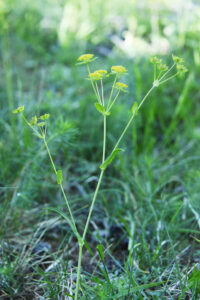
The generic name is derived from Ancient Greek khairephyllon, from khairo (‘to be glad’) and phyllon (‘leaf’), the classical name of garden chervil (Anthriscus cerefolium), a culinary herb, which is much used in Mediterrenean kitchens. Botanically speaking, however, the word chervil also applies to members of the genus Chaerophyllum.
This plant is partial to humid areas, including wet meadows and along streams, but it may also grow in drier grasslands, especially at higher altitudes. It is distributed in central European mountains, including the Harz, Thuringia, Saxony, the Alps, the Pyrenees, the Apennines, and the Carpathians, and also in montane areas of the Balkans. It occurs eastwards to Ukraine. It grows up to altitudes around 2,000 m.
The specific name is Latin, meaning ‘hairy’.
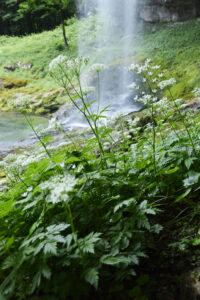
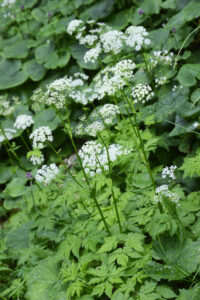
The generic name is derived from Ancient Greek eryngion, diminutive of eryngos, the classical name of the sea holly (E. maritimum).
In German, these plants are called Mannstreu (‘faithful to the man’), first mentioned by German surgeon and herbalist Hieronymus Brunschwyg (c. 1450-1512) in his book Liber de arte distillandi de simplicibus (1500), also known as Kleines Destillierbuch (‘small distillation book’).
The origin of this strange name can be traced back to Roman naturalist Pliny the Elder (23-79 A.D.), who mentions a sort of eryngion, which he also calls centum capitum (‘the one with a hundred heads’). He says that, according to local belief, this plant had male and female roots, and that men who possessed a ‘male’ root, would be attractive to women.
In Greek mythology, it was told that the youth Phaon was in possession of such ‘male’ roots, which causedthe female poet Sappho to fall in love with him.
However, Pliny adds that he regards all this as vanitas – pure superstition.
Despite his knowledge of Pliny’s scepticism, German theologist and botanist Otto Brunfels (c. 1488-1534) states the following in an herbal book from 1532: “Welcher mann solich wurtzel bey ym tregt, die ein männlein ist, machet yn holdselig gegen den frawen” (‘The man, who carries such roots on him, which are male, will be attractive to women’).

It was named in honour of a French physician named Bourgat who collected plants in the Pyrenees in the company of botanist Antoine Gouan (1733-1821), who described the species in 1766. A native of Montpellier, Gouan was a pioneer of the Linnaean binominal taxonomy in France. In 1762, he published a plant catalog of the botanical garden at Montpellier, titled Hortus regius monspeliensis.

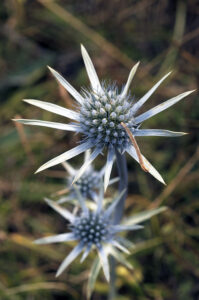
During the Middle Ages, it was regarded as an aphrodisiac.
The specific name is Latin, meaning ‘growing on plains’ or ‘growing in fields’.
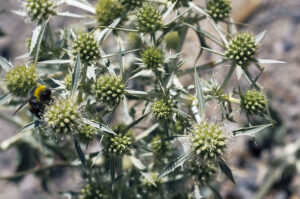
Stem smooth, leaves bluish-green, 3 or 4 times pinnate, ultimate segments lanceolate or ovate, almost rhombic, toothed, upper leaves much smaller. Bracts few, thread-like, bracteoles numerous, likewise thread-like. Flowers white.
The generic name honours Slovenian pharmacist, chemist, and botanist Žiga Graf (1801-1838), who worked as a pharmacist in Ljubljana. Despite his short life, he wrote a large number of articles on botanical issues.
Some authorities include this species in the genus Pleurospermum (below).
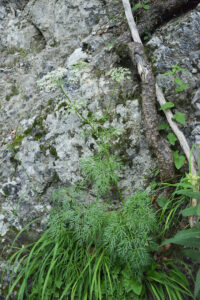
The fruit of these plants is characteristic, strongly compressed and ribbed, the lateral ribs with a broad wing. Inside the fruit are club-shaped resin canals, clearly visible against the light.
The generic name is a Latinized version of the classical Greek name of a southern European plant, which was utilized in traditional Greek medicine. It was called panakes herakleion, meaning something like ‘the universal healing herb of Herakles’. It was thought that the immensely strong mythological hero Herakles (in Latin Hercules) discovered the medicinal properties of this plant. The generic name was applied in 1753 by Swedish botanist Carl Linnaeus (1707-1778), undoubtedly referring to the profuse growth of many of these plants, likened to the strength of Herakles.
The common name hogweed is variously interpreted, either referring to pigs being fond of eating common hogweed (below), or as a derogatory term, a plant only fit for pigs. Cow-parsnip, used from about 1548, presumably alludes to the plant being eaten by cattle.
This plant, divided into about 16 subspecies, is distributed throughout Europe, eastwards to western Siberia, and also in Morocco, Turkey, and the Caucasus. In the Alps, it may be encountered up to elevations around 2,700 m.
The specific name is derived from Ancient Greek spondylos (‘vertebrate’), alluding to the segmented stem.
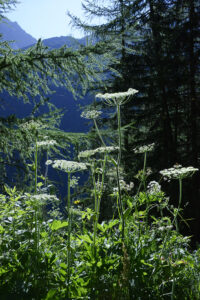
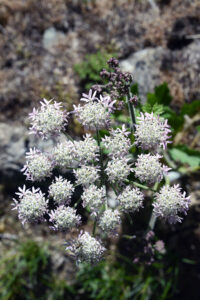
Why the names Laserpitium and laserwort have been applied to this genus is not clear. They are derived from the Latin lacarpicium, the name of a resinous gum with culinary and medical uses, which, in Ancient Rome, was extracted from various genera of Apiaceae, including giant fennel (Ferula) and Silphium, derived from silphion, the classical Greek word for laserwort. One of the usages was as a contraceptive.
This plant is restricted to the southern part of the Alps, from France eastwards to Austria, growing on warm, dry, calciferous slopes.
The specific name honours Swiss physiologist, naturalist and poet Victor Albrecht von Haller Sr. (1708-1777), professor of botany in Göttingen and often referred to as ‘the father of modern physiology’. He was among the first botanists to realize the importance of herbaria to study variation in plants, and, consequently, he included material from different localities and habitats, and in various phases of development.
The genus Halleria, comprising attractive shrubs from southern Africa, was named in his honour by Swedish naturalist Carl Linnaeus (1707-1778).
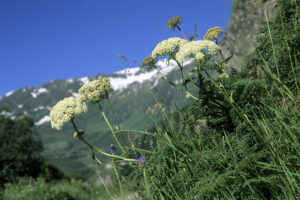
It is widespread in Europe, only absent from Iceland, the British Isles, the Netherlands, and Greece.
The specific name is Latin, meaning ‘broad-leaved’.
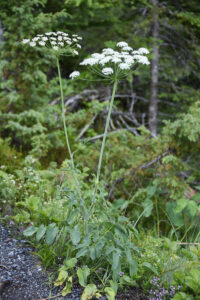
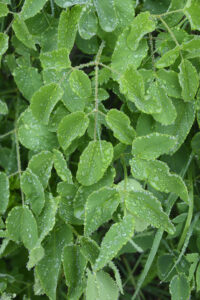
The generic name is derived from Ancient Greek peukedanos (‘bitter’), alluding to the bitter substances in masterwort (below).
It is native to mountains of central and southern Europe, including the Alps, the northern Apennines, the Carpathians, the French Massif Central, and mountains in the Iberian Peninsula. However, due to its medicinal properties it has been widely introduced elsewhere. In the Alps, it may be found up to elevations around 2,200 m. Its habitats include meadows, grazing grounds, steep slopes, and avalanche gullies.
The common name alludes the multiple usage of this plant. In former days, the root was believed to possess wonderful properties, called remedium divinum (‘divine remedy’) and sold in pharmacies under the names Radix ostruthii or Rhizoma imperatoriae. It was utilized for treatment of disorders of intestines, stomach, kidneys, skin, respiratory tract, and cardiovascular system, and to fight infections, fever, flu, and colds. The plant was also used as a flavouring agent in various liqueurs and bitters.
The name masterwort also applies to members of the genus Astrantia (above).
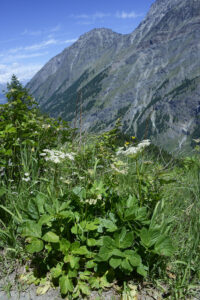
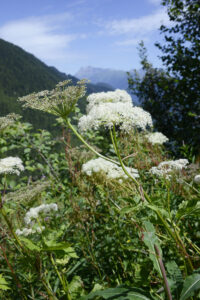
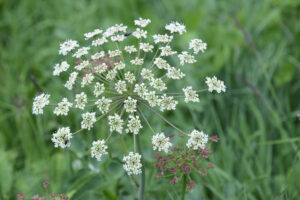
In Germany, during plague epidemics, burnet-saxifrage was eaten, as it was said to be an effective remedy against the feared disease, and it would also protect you against all kinds of poisons.
The generic name is of unknown origin.
The burnet part of the common name alludes to the similarity of the leaves of some species of the genus to those of burnet (Sanguisorba minor), whereas the saxifrage part refers to the diuretic properties of some species, similar to certain species of saxifrage (Saxifraga).
This species grows in forest clearings, shrubberies, meadows and pastures, and along roads, preferably on nutritious and calcareous soils, from the lower valleys up to altitudes around 2,300 m. It is widespread, from Europe eastwards to the Caucasus.
Formerly, it was used in traditional Austrian medicine for treatment of respiratory problems, fever, infections, colds, and flu.
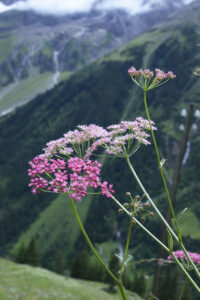
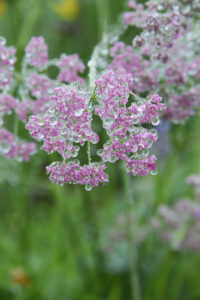
The generic name is derived from Ancient Greek pleuron (‘ribbed’) and sperma (‘seed’), alluding to the winged fruits of the genus.
Several species are described on the page Plants: Himalayan flora 1.
This species, which grows in open forests, grasslands, and grazing grounds, is partial to calcareous soils. It is distributed in the Alps and the Carpathians, and on the Balkan Peninsula, with isolated populations in the Swabian Jura, Franconia, and Thuringia, and also in Sweden. In the Alps, it may be encountered up to elevations around 1,850 m.
The specific name refers to Austria. Presumably, the type specimen was collected there.
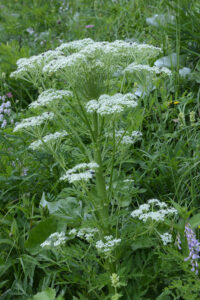
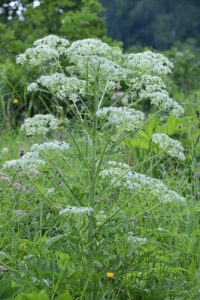
In Latin, the generic name applies either to the spindle tree (Euonymus), or to a kind of willow (Salix). The connection to these plants is hard to see.
It is distributed in the Alps, the Pyrenees, the Apennines, and in mountains on the Balkan Peninsula, growing on slopes at elevations between 800 and 2,300 m.
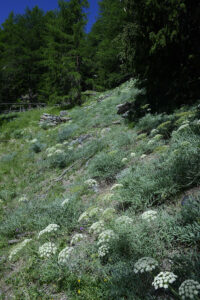
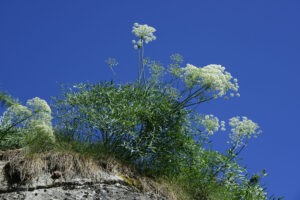
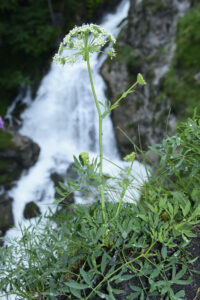
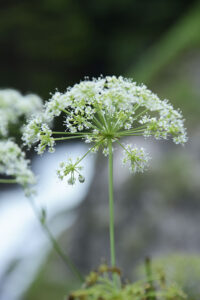
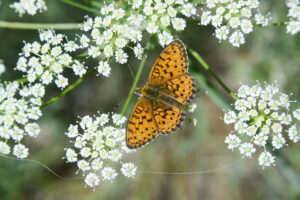
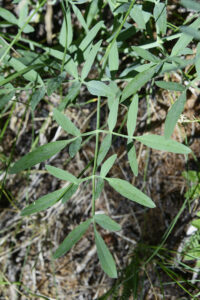
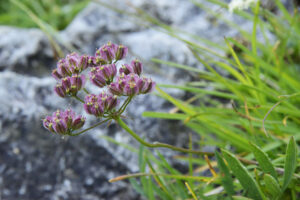
The generic name is derived from Ancient Greek antherikos (‘straw’), alluding to the narrow leaves.
Previously, these plants were placed in the lily family (Liliaceae), but were then moved to a separate family, Anthericaceae, which is today regarded as a part of Agavoideae, a subfamily of the asparagus family.
The specific name is Latin, meaning ‘lily-like’, naturally alluding to the flowers.
The common name alludes to Saint Bernard of Clairvaux (1090-1153), a mystic, an abbot, and a major leader in the reform of the Benedictines through the Cistercian Order. He was a co-founder of the Knights Templar, also known as The Poor Fellow-Soldiers of Christ and of the Temple of Solomon, a Catholic military order, founded around 1119 to defend pilgrims on their way to Jerusalem. Their headquarters were located on the Temple Mount in Jerusalem.
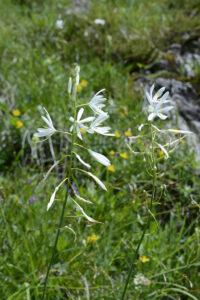
This species is distributed in the major part of Europe, southwards to the Mediterranean, eastwards to European Russia and Turkey. It mainly grows in sunny areas and on calcareous soils, in grasslands and forest edges, and on drier slopes. In the Alps, it may be found up to altitudes around 1,900 m.
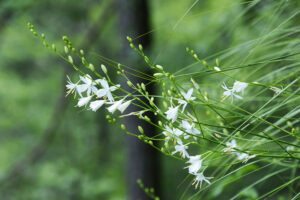
This genus was established in 1811 by Italian botanist Giovanni Mazzucato (1787-1814), in honour of his patron, Count Giovanni Paradisi (1760-1826), mathematician, politician, and poet.
It grows to about 90 cm tall, with grass-like leaves and pure white, trumpet-shaped flowers, to 6 cm long, with prominent yellow anthers.
Greek physician, pharmacologist, and botanist Pedanius Dioscorides (died 90 A.D.), who was the author of De Materia Medica (5 volumes dealing with herbal medicine), included this species among his medicinal plants.
The specific name is derived from the Latin lilium (‘lily’), and the suffix aster (‘resembling’).
The common name refers to St. Bruno, founder of the Carthusian order of monks in the 11th Century, in the French Alps.
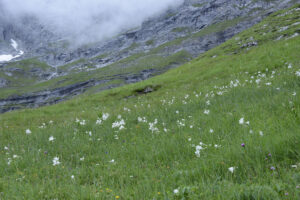
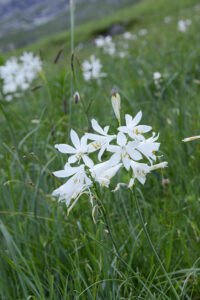
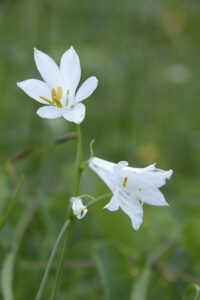
The generic name is derived from Ancient Greek asplenon, the classical name of spleenworts, ultimately from splen (‘spleen’), alluding to its usage to cure anthrax in livestock.
It is a very widespread plant, found in all of Europe, eastwards across most of Siberia, in North Africa, the Middle East, Central Asia, the Himalaya, and China. In Central Asia, it grows up to elevations around 3,300 m.
The specific and common names refer to the fact that it often grows on walls, and to the likeness of its leaves to those of common rue (Ruta graveolens).
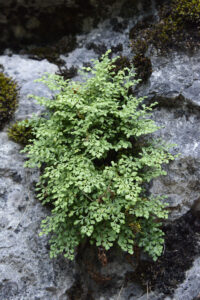
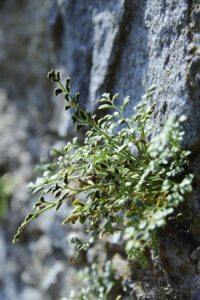
It is very widely distributed, found in scattered locations in most parts of the world, growing in rocky habitats and on walls, from sea-level up to about 3,000 m. It is fairly common in the Pyrenees and the Alps.
This species and its near relatives were much utilized in traditional herbal medicine. Greek physician, pharmacologist, and botanist Pedanius Dioscorides (died 90 A.D.) and Roman naturalist Pliny the Elder (23-79 A.D.) both distinguished between a pale and a black adianton. They were supposed to possess general anti-toxic properties, used as a diuretic, to expel kidney stones, to cure pulmonary problems, jaundice, spleen diseases, and skin ailments, and to promote hair growth.
The specific name refers to one of the names that the Ancients used for these plants, which were randomly called trichomanes (‘fine hair’), polytrichon (‘many hairs’), kallitrichon (‘fair hair’), and capillus veneris (‘venus hair’).
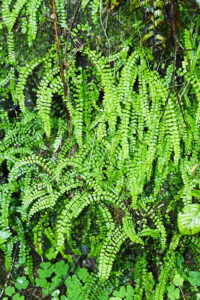
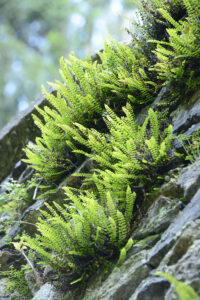
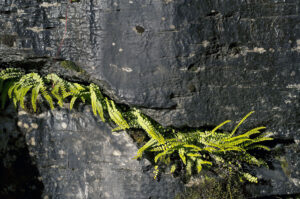
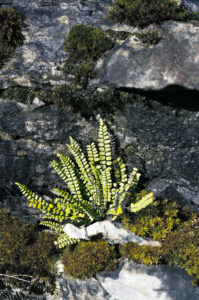
The inflorescence consists of many individual flowers, called florets, which are grouped densely together to form a flower-like structure, the flowerhead, technically called the capitulum. The flowerhead is surrounded by an involucre, consisting of densely packed green bracts, often erroneously called a calyx. The central disk florets are symmetric, and the corolla is fused into a tube. The outer ray florets are asymmetric, the corolla having one large lobe, which is often erroneously called a petal. In some species, ray florets, or sometimes disk florets, are absent.
In his Herball, or Generall Historie of Plantes (1597), English herbalist John Gerard (c. 1545-1612) informs us that during the Trojan War the Greek hero Achilles used yarrow to stop bleeding on wounded soldiers. Hence, the name Achillea was applied to the genus by Swedish naturalist Carl Linnaeus (1707-1778). It was already mentioned as a medical herb in De simplicium medicamentorum facultatibus, written by Greek-Roman physician, surgeon, and philosopher Aelius Galenus (c. 129-210 A.D.), also known as Claudius Galenus or Galen of Pergamon.
Various plants, including yarrow, were found in a 50-60,000-year-old Neanderthal grave in Iraq, perhaps indicating that these plants were used medicinally. (Source: G.P. Shipley & K. Kindscher 2016. Evidence for the Paleoethnobotany of the Neanderthal: A Review of the Literature. hindawi.com/journals/scientifica/2016/8927654)
The name yarrow is a corruption of gearwe, an ancient Anglo-Saxon name for common yarrow (below). The name sneezewort refers to Achillea ptarmica, often called sneezeweed, which, if stuck up the nose, causes sneezing. The name milfoil is explained below, at A. millefolium.
The specific name is derived from the Latin ater (‘dark’ or ‘black’), alluding to the dark stems.
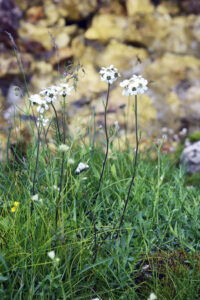
It was named by Swedish botanist Carl Linnaeus (1707-1778) in honour of Italian pharmacist Nikolaus Clavena (dead 1617), who described the species in 1610. He was the author of Historia Alsinthii Umbelliferi (1610).
In the 1500s, the plant was known as Absinthium album or Absinthium alpinum, and was used medicinally due to its contents of essential oils and bitter substances.
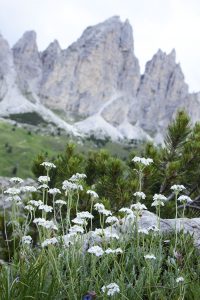
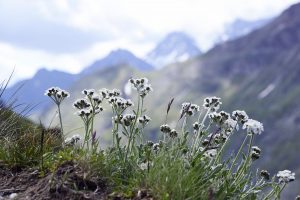
According to one source, the specific name is derived from the Latin herba (‘herb’) and rota (‘wheel’), alluding to the circular inflorescence. This seems dubious, as almost all composites have circular inflorescences. An alternative interpretation may be that rotta is Italian, meaning ‘broken’ (i.e. finely divided?), perhaps referring to the foliage.
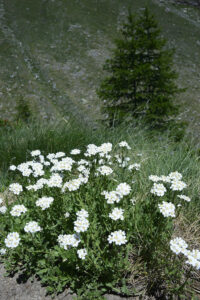
The specific name is derived from Ancient Greek makros (‘large’) and phyllon (‘leaf’).
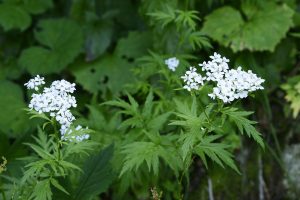
The greyish-green leaves are very finely dissected, aromatic, to 10 cm long. Flowerheads are numerous, sometimes up to 50, borne in a flat or slightly domed cluster to 30 cm across. Ray florets are white, much larger than the tiny yellowish or cream-coloured disc florets. The entire flowerhead is only to 8 mm across.
The specific name is derived from the Latin mille (‘a thousand’) and folium (‘leaf’), alluding to the many fine segments of the leaves, in English corrupted to milfoil. Another common name is thousand-weed. In parts of south-western United States, it is called plumajillo (Spanish for ‘little feather’), likewise alluding to the leaves.
The role of this species in folklore and traditional medicine is described on the page Plants: Plants in folklore and poetry.
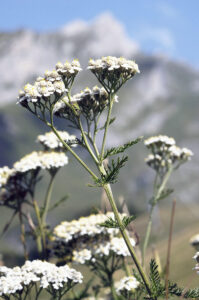
The specific name is derived from Ancient Greek oxys (‘sharp’) and lobos (‘lobe’), alluding to the sharply pointed lobes on the leaves.
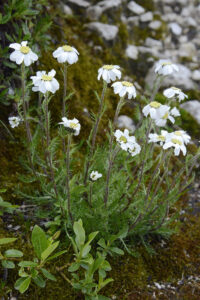
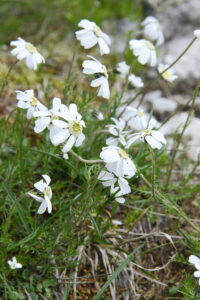
The generic name, applied by French botanist Alexandre Henri Gabriel de Cassini (1781-1832), is derived from Ancient Greek aden (‘gland’) and stylos (‘style’), referring to the glandular styles of the genus.
It may readily be identified by the large, kidney- or heart-shaped, toothed basal leaves, measuring up to 14 cm across and 9 cm in length. Stem leaves are much smaller, eared, gradually getting smaller up the stem. The flowerheads are numerous, densely clustered towards the apex of the stem. They contain only disc florets, to 8 mm long, purplish-blue or pinkish.
The specific name refers to the basal leaves of this plant resembling those of the garlic mustard (Alliaria petiolata).
You often come across a growth of common adenostyle, whose leaves have been almost completely eaten by larvae of Oreina cacaliae, a metallic, bluish or greenish beetle, which belongs to the family broad-shouldered leaf beetles (Chrysomelidae). This species is partial to common adenostyle, as well as alpine butterbur (Petasites paradoxus, see below).
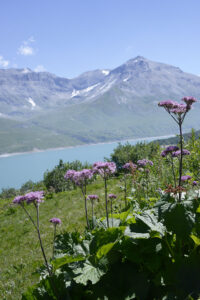
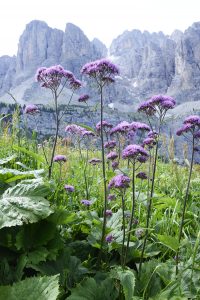
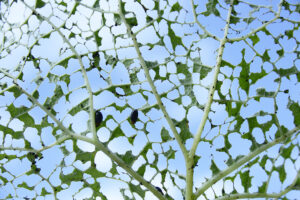
It grows in shady montane forests, up to altitudes around 2,200 m, from Spain eastwards across the Alps to the Balkan Peninsula, the Carpathians, and Ukraine, and thence northwards to Poland and Belarus.
The generic name is derived from Ancient Greek apo (‘away from’, i.e. ‘different’) and seris (‘chicory’), referring to the leaves, which slightly resemble the basal leaves of chicory (below).
The specific name, meaning ‘smelly’, alludes to an unpleasant smell from its white, milky sap.
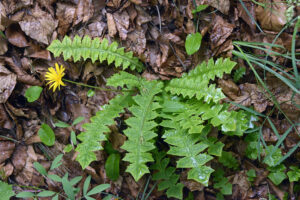
The generic name may be derived from Ancient Greek arni (‘lamb’), alluding to the soft, hairy leaves of these plants. Arnica leaves were formerly utilized as a substitute for tobacco, hence the popular name mountain tobacco.
Arnica has been utilized medicinally for hundreds of years. This subject is discussed in depth on the page Plants: Plants in folklore and poetry.
The specific name is not very appropriate, as the plant also grows in lowlands. Common names include wolf’s bane and leopard’s bane, referring to its great toxicity.
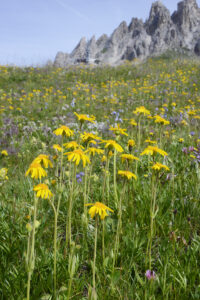
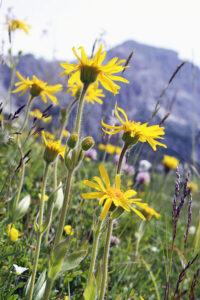
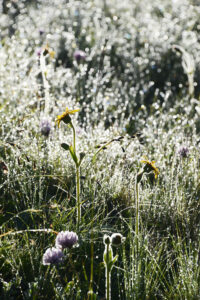
The role of Artemisia species in folklore and traditional medicine is described on the page Plants: Plants in folklore and poetry. Mugwort (A. vulgaris) is described on the page Plants: Urban plant life.
It is a shrubby herb, to 45 cm tall, with silvery-white leaves, to 4 cm long, divided into linear segments. Flowerheads are small, yellowish, in arching spikes.
Its distinctive fragrance is due to an essential oil, containing camphor, camphene, eucalyptol, and borneol. In Switzerland and Italy, it has been utilized as an ingredient in vermouth for hundreds of years. Today, it is quite rare due to overcollection.

The generic name is Ancient Greek, meaning ‘star’, alluding to the spreading ray florets.
A number of species are described on the page Plants: Himalayan flora 1.
In former days, a large number of North American composites were included in this genus. However, following comprehensive research, the New World species have been transferred to the genera Almutaster, Canadanthus, Doellingeria, Eucephalus, Eurybia, Ionactis, Oligoneuron, Oreostemma, Sericocarpus, and Symphyotrichum.
It is partial to dry, calcareous soils. In the Alps, it is found from the lowlands up to altitudes around 3,200 m.
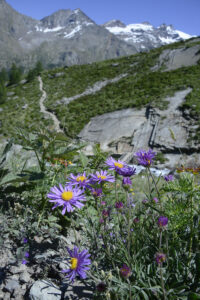
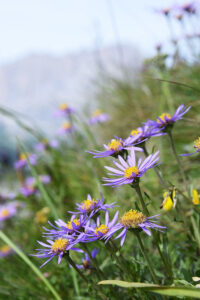
It occurs in montane areas of central and southern Europe, mainly in open places or forest clearings, up to elevations around 2,800 m.
The specific name is derived from Bellis, the generic name of the common daisy, and the Latin suffix aster (‘resembling’), referring to the likeness of the flowers to those of the common daisy.
The obsolete specific name michelii was given in honour of Italian botanist Pier Antonio Micheli (1679-1737), professor of botany in Pisa, curator of the Orto Botanico di Firenze, author of Nova plantarum genera iuxta Tournefortii methodum disposita. He was a leading authority on cryptogams (plants reproducing by spores), and discovered the spores of mushrooms.
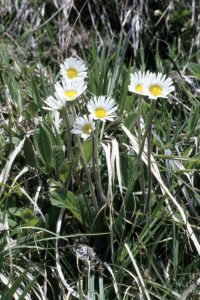
The generic name is derived from Ancient Greek bous (‘ox’) and ophthalmos (‘eye’), presumably referring to the raised disc florets, which, with a bit of imagination, resemble the bulging eyes of bovines.
It is partial to limestone grasslands and dry forests at medium elevations, up to altitudes of at least 2,000 m. It is widely distributed in montane areas of Central Europe and the Balkan Peninsula.
The specific name is derived from the Latin Salix (‘willow’) and folium (‘leaf’), referring to the leaves, which resemble those of certain willow species.
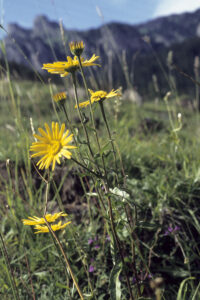
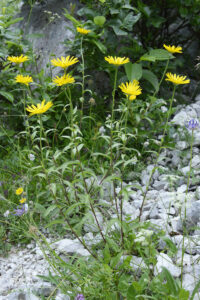
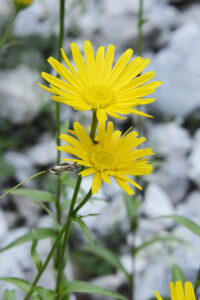
The generic name is the classical Latin word for thistle, probably derived from the Sanskrit kasati (‘to scratch’), alluding to the spines.
Many species in this genus are described on the page Plants: Thistles.
The stem is usually to 50 cm tall, sometimes up to 90 cm, slightly arching, branched, smooth or sometimes winged with thorns, upper part mostly without leaves, thorns, and wings. Leaves are very variable, hairless, sessile, blade entire or pinnate, sometimes toothed.
This species differs from other members of the genus in having only a single purplish-red flowerhead, to 3 cm across, at the end of each branch. Initially, it is erect, later often nodding. Involucral bracts are spreading, unlike the rather similar Cirsium tuberosum.
It is partial to rocky limestone areas, from the lower valleys up to altitudes around 3,000 m, distributed from the Pyrenees via the Alps to the northern Balkan Peninsula and the Carpathians.
The specific name is Latin, meaning ‘with removed flowers’, perhaps alluding to each branch having only a single flowerhead.
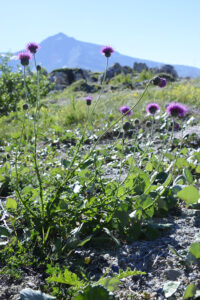
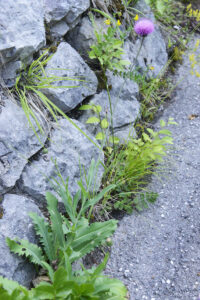
In the early 19th Century, it was introduced to North America, where it quickly became a nuisance in agricultural areas. It is declared a noxious weed in the U.S., Canada, Australia, New Zealand, and South Africa.
In colder regions, this plant is a biennial, requiring 2 years to complete a reproductive cycle, overwintering as a rosette. It may grow to about 1.5 m tall, often with branched stems. The leaves are large, often growing to 60 cm long, bipinnately lobed, with a smooth, waxy surface and sharp, yellow-brown or whitish spines at the tips of the lobes. The flowerheads are large, terminal, to 7 cm across, with hundreds of purplish-red disc florets. The flowerhead is surrounded by very large and sharp bracts.
The specific name is Latin, meaning ‘nodding’, referring to the often nodding flowerheads.
Several pictures, depicting this plant, are shown on the page Plants: Flora in Turkey.

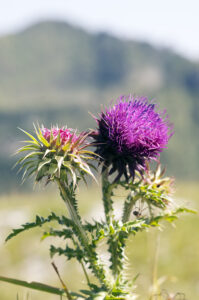
The spines of this plant are rather soft. It has a sturdy stem, varying in height between 40 cm and 1.6 m, widely branched towards the apex, winged, with fine spines along the edge of the ribs. The leaves are all stem leaves, ovate or lanceolate, soft and curly, with fine spines along the margin, the lower ones to 35 cm long and 20 cm wide, gradually getting smaller up the stem.
The flowerheads are densely clustered at the apex of stem and branches, 2-5 together, to 2.5 cm across, disc florets violet-purple, ray florets absent.
The specific name is derived from the Latin personatus (‘masked’), presumably alluding to the very dark bracts.
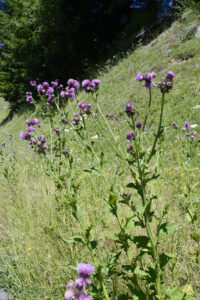
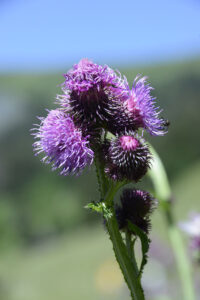
The flowerhead has several rows of bracts, of which the outer ones are leaf-like with spine-like tips, whereas the inner rows have ray-like, whitish or yellowish bracts, which are hygroscopic. In dry weather they are spread out fan-like, announcing to bees and hover flies that food is available here, whereas in damp weather they fold up to protect the true florets in the centre of the flowerhead. In folklore, this was seen as a sign of forthcoming rain.
The generic name was given in honour of Holy Roman Emperor, Archduke of Austria, King of Spain, and Lord of the Netherlands, Karl V (1500-1558), called Charlemagne or Charles the Great. As legend has it, during a plague epidemic, an angel came to him in his dream and told him to use Carlina acaulis (below) to control the feared disease. It was also told that he used the root of the plant to cure disease among his soldiers.
Other members of this genus are described on the page Plants: Thistles.
Divided into 4 subspecies, it is distributed from the Pyrenees eastwards to the Balkans, and thence northwards to Poland and Ukraine. The nominate subspecies is quite common in the Pyrenees.
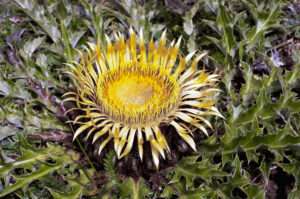
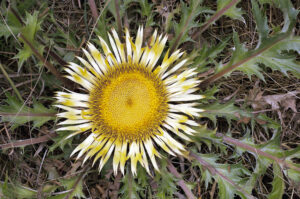
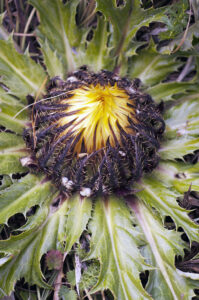
It is distributed in the major part of central and southern Europe, eastwards to Belarus and Ukraine, with an isolated population in the Caucasus. It grows in dry grasslands, preferably on calcareous soil, from the valleys up to elevations around 2,800 m.
The rhizome contains a number of essential oils and was formerly used as a diuretic and to treat colds. Young buds of the flowerheads can be cooked and eaten, similar to artichokes (Cynara cardunculus), which earned it the nickname hunter’s bread.
The specific name is Latin, meaning ‘stemless’, composed of a (‘without’) and caulis (‘stem’).
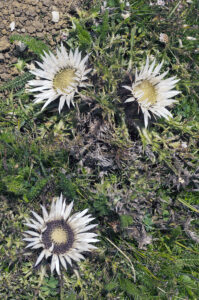
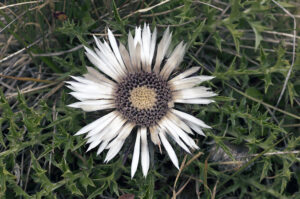
These plants do not have ray florets, but are characterized by most species possessing two types of disc florets, the outer ones much larger, fringed, sterile, acting as attractors to pollinators.
The generic name is derived from Ancient Greek kentauros (‘centaur’), referring to Chiron the Centaur. According to Greek mythology, Chiron once had a festering wound on his foot, made by an arrow dipped in blood of Hydra, a many-headed serpentine monster with a poisonous breath and blood so virulent that even its scent was deadly. Chiron cured himself by dressing the wound with a member of this genus.
These plants have many common names, including centaury, knapweed, starthistle, and cornflower, the latter usually referring to two blue-flowered species, C. montana (below) and C. cyanus, described on the page Plants in folklore and poetry.
This plant, which grows in grasslands and other open areas, is native to highlands of central and southern Europe, from Belgium, France, and Spain eastwards to Poland, the Czech Republic, and Austria, and thence southwards to the Balkan Peninsula, growing at altitudes between 500 and 2,200 m. It is common in the Alps. It is widely cultivated elsewhere and has escaped in many countries, including Denmark, Sweden, Russia, and the United States.
The specific name is not very appropriate, as the plant also grows in lowlands.
The rather similar cornflower (C. cyanus) may be distinguished by having many flowerheads on each branch.
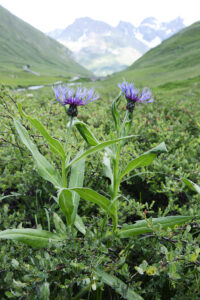
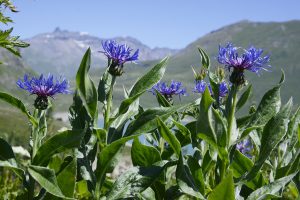
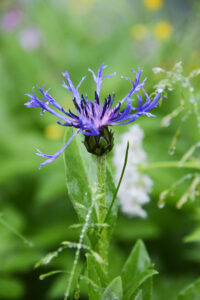
The stem is erect, unbranched, bristly-hairy, to 50 cm tall, leaves many, to 11 cm long and 5 cm wide, lanceolate-triangular, sparsely toothed or entire, hairy, clasping the stem. Flowerheads large, solitary, to 6 cm across, the dark involucre covered in pale, featherlike, stiff hairs. Florets are pink.
The specific name was given in reference to the protruding nerves on the leaves, whereas the prefix plumed refers to the much-divided ray florets.
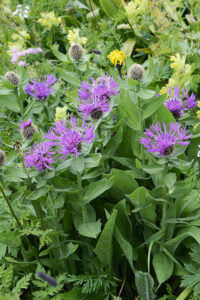
This plant thrives in drier grasslands, along roads, and in fallow fields, preferably on calcareous soils. It is distributed in almost all of Europe and thence eastwards across the major part of Siberia to Central Asia. In the Alps, it may be found up to elevations around 2,200 m.
The specific name refers to an old belief that the leaves of this plant could treat scabies.
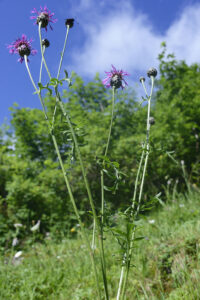
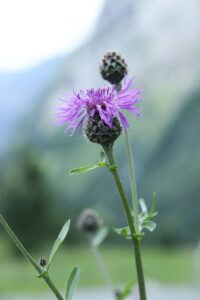
In its first year, this biennial, or sometimes perennial, grows a basal leaf rosette, the following year producing a much-branched, slender stem, erect or ascending, hairy, to 1 m tall. Stem leaves are alternate, to 5 cm long, pinnately divided into very fine segments. Leaves get gradually smaller and less lobed up the stem. Flowerheads are egg-shaped, solitary at the end of stem and branches, to 2.5 cm long and 1.5 cm across, florets pink or purplish-pink, involucral bracts ovate, with a dark tip and fuzzy bristles along the margin. The dark tips lends a spotted appearance to the involucre, which gave rise to one of the English names of the plant.
This species grows in a variety of habitats, including grasslands, fallow fields, pastures, along roads and railroads, and in other disturbed areas. It is native to eastern Europe and south-western Asia, but has become naturalized in numerous other areas, especially in drier areas of North America, where it is considered a serious pest, covering huge areas.
In classical Greek, stoibe was the name of the thorny burnet (Sarcopterium spinosum), a very spiny plant of the rose family (Rosaceae), described on the page Plants: Flora in Turkey. Why it was applied to the spotted knapweed is not clear.
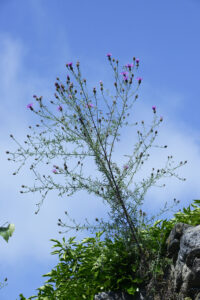
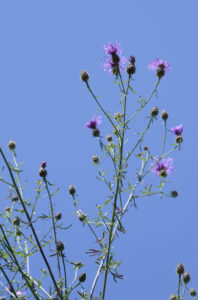
The generic name is Italian, meaning ‘chicory-like’, referring to the likeness of the flowerheads to those of chicory (below).
In Finland, a popular name of this species is ‘bear-hay’, as bears (Ursus arctos) are often observed eating the juicy plant. Moose (Alces alces) and reindeer (Rangifer tarandus) also relish it. The Sami have been known to eat it raw, or boiled in reindeer milk. (Source: luontoportti.com/suomi/en/kukkakasvit/alpine-sowthistle)
In Italy, alpine sow-thistle is also eaten as a vegetable. The young shoots are boiled and served in olive oil or tomato sauce, and the former is sold under the name insalata dell’orso (‘bear salad’). (Source: F. Scartezzini et al. 2012. Domestication of alpine blue-sow-thistle (Cicerbita alpina (L.) Wallr.): six year trial results. Genetic Resources and Crop Evolution, 59(3): 465-471)
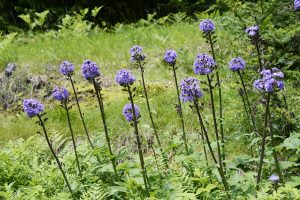

The generic name is possibly derived from keksher, a word of Egyptian origin. It is said that chicory was cultivated in Egypt thousands of years ago.
The specific name is a corruption of the word hendibeh, the Arabic name of a near relative, endive (C. endivia).
The role of chicory in folklore is described on the page Plants: Plants in folklore and poetry.
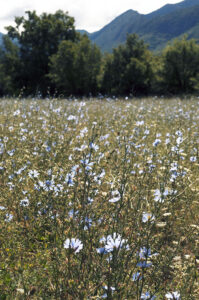
The generic name is derived from Ancient Greek kirsion. According to Greek physician, pharmacologist, and botanist Pedanius Dioscorides (died 90 A.D.), who was the author of De Materia Medica (5 volumes dealing with herbal medicine), this term was used for a kind of thistle, derived from kirsos (‘swollen vein’), alluding to its usage against swollen veins.
These plants were already regarded as being different from the present-day members of the genus Carduus (above) by Swiss botanist Gaspard Bauhin (see below). He may have noticed that their pappus (seed hairs) form a plume, as opposed to members of Carduus, which have simple, unbranched seed hairs.
Many species in this genus are described on the page Plants: Thistles.
In his outstanding work Pinax theatri botanici (‘Illustrated exposition of plants’), from 1623, this brilliant scientist described about 6,000 plant species, classifying them in a form, which almost equals the binominal nomenclature, introduced by Swedish botanist Carl Linnaeus (1707-1778) in 1753.
The major part of the information above is from the website en.wikipedia.org/wiki/Gaspard_Bauhin.

It is widespread in the major part of Europe, eastwards to the Baltic states and Romania, growing in grasslands with short vegetation, mainly on calcareous soil. In the Alps, it occurs up to elevations around 2,300 m.
The specific name is Latin, meaning ‘stemless’, composed of a (‘without’) and caulis (‘stem’).
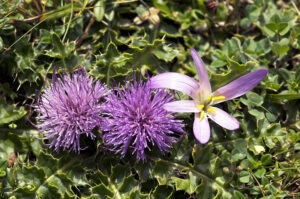
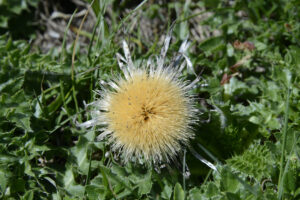
This plant is widespread in Europe, found from the British Isles, Germany, and Poland southwards to the Mediterranean and Turkey, growing in open habitats, including grasslands, shrubberies, woodlands, and disturbed areas.
The young leaves may be eaten raw, and young stems are also edible after being soaked in water to remove their bitterness. The flower buds can be cooked, similar to artichokes (Cynara cardunculus), and an edible oil is extracted from the seeds.
The specific name is derived from Ancient Greek erion (‘wool’) and phoros (‘bearing’), alluding to the woolly stem.
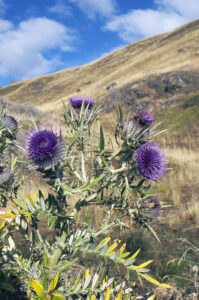
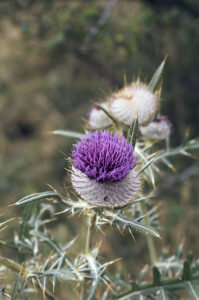
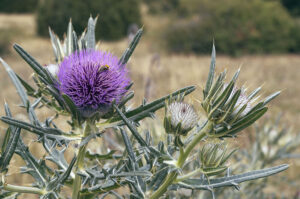
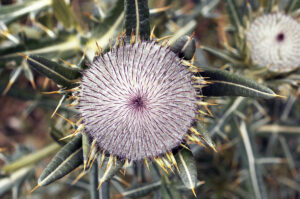
It is widespread in southern and eastern Europe, found from the French Massif Central across the Alps eastwards to the Tatra Mountains, the Dinaric Alps, Greece, Ukraine, and European Russia. In the Alps, it is found at altitudes between 400 and 2,000 m.
The specific name, in the form erysithales, was the classical Latin name of an unspecified plant with yellow flowers. The epithet melancholy alludes to the nodding flowerheads, which, apart from the colour, resemble those of the melancholy thistle (below).
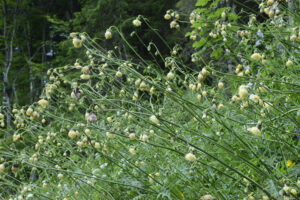
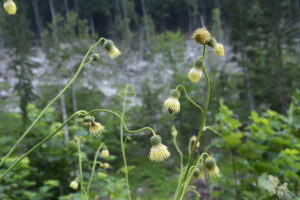
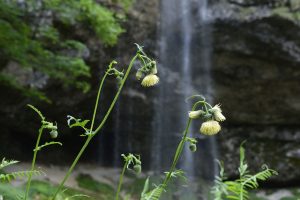
It grows in grasslands, shrubberies, open woodland, and along roads and streams. It is native from northern Europe, including Scotland, eastwards across the major part of Siberia to Kazakhstan, Xinjiang, and Mongolia. It also occurs in montane areas of central and southern Europe, and in the Caucasus, and also a few places in Iceland and southern Greenland. In the Alps, it has been encountered up to elevations around 2,400 m.
It was first described by Swiss botanist Gaspard Bauhin (see genus Cirsium above), as Cirsium maximum, Asphodeli radice (‘the largest thistle with roots like asphodels’), and also as Cirsium montanum, incano folio (‘mountain thistle with grey leaves’).
A Swedish folk name, elgtunga (‘moose tongue’), probably refers to the leaf shape.
Formerly, this species was considered a possible cure for sadness. English herbalist Nicholas Culpeper (1616-1654) says that it, being drank in wine “expels superfluous melancholy out of the body and makes a man as merry as a cricket,” adding “Dioscorides [see genus above] saith, the root borne about one doth the like, and removes all diseases of melancholy: Modern writers laugh at him: Let them laugh that win: my opinion is, that it is the best remedy against all melancholy diseases that grows.”
The specific name is Latin, meaning ‘like Helenium‘, alluding to the likeness of some leaf forms to those of the basal leaves of elecampane (Inula helenium), which is described on the page Plants: Plants in folklore and poetry.
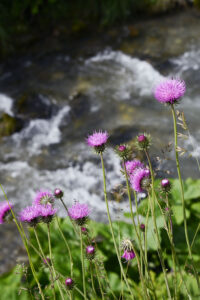
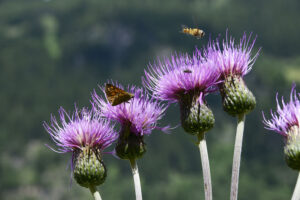
Flowerheads are terminal, to 4 cm across, 2-6 densely clustered, surrounded or even sometimes covered by large yellowish bracts. Florets pale yellow, sometimes tinged pink.
The cabbage thistle thrives in wet meadows, along streams, and in humid forests, often forming large stands with the help of underground stems. It is native from western Europe eastwards to western Siberia. In montane areas it is restricted to the lower areas, occasionally found up to altitudes around 2,000 m.
The specific name is derived from the Latin holus, genitive holeris (‘vegetable’), alluding to the young stems and leaves being edible. The common name also refers to this usage. In Japan, it is still being cultivated as a vegetable.
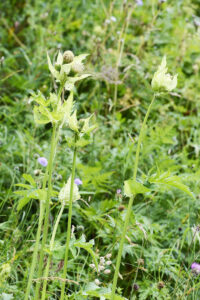
It is found in the entire Alps and the northern part of the Balkans, growing in dry, rocky areas at altitudes between 1,100 and 3,100 m.
Previously, young shoots were cooked as spinach or used in soup, and they were also used as pig feed.
A quite similar species, Bertoloni’s thistle (C. bertolonii), is found in the Apennines. It was previously regarded as a subspecies of spiniest thistle.
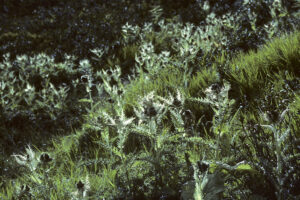
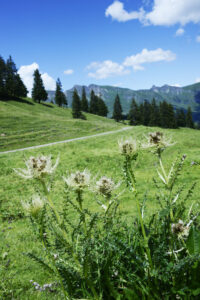
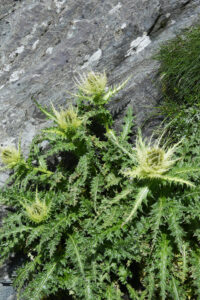
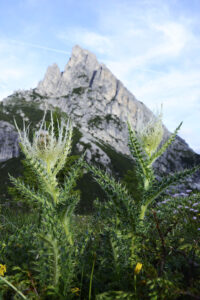
According to one source, the generic name is derived from Ancient Greek cotyle (‘cavity’, ‘bowl’, or ‘cup’), alluding to the sessile leaves of some members of the genus forming a cavity at the base.
Stem to 90 cm tall, branched above, longitudinally ribbed, sparsely or densely downy-hairy, leaves sessile, ovate or elliptic in outline, to 14 cm long, almost pinnately divided into pointed lobes. Flowerheads are up to 4 cm across, disc florets yellow, ray florets white, to 2 cm long.
The plant was named in honour of Italian botanist Giovanni Battista Trionfetti (1656-1708), also known as Joannes Baptista Triumfetti, curator of the botanical garden of the Sapienza University in Rome. In 1685, he published a paper, Observationes de ortu et vegetatione plantarum cum novarum stirpium historia, in which he attacked a theory, formed by the Italian physician Marcello Malpighi (1628-1694), claiming that a living being was preformed in the seed or egg.
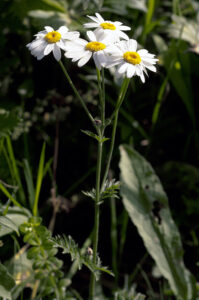
The generic name is derived from Ancient Greek krepis (‘slipper’ or ‘sandal’), according to some authorities referring to the shape of the fruit.
It is widely distributed in the Jura, the Alps, the Apennines, the Abruzzos, and the Balkans, and is also found in Asia Minor. In the Alps, it grows in meadows and pastures, preferably on acid soil, at altitudes between 1,000 and 2,900 m.
In the Alps, it is regarded as a valuable fodder plant for cattle, hence the Swiss folk names Rombluem (‘cream flower’) and Ankenblüemli (‘small butter flower’).
The specific name is Latin, meaning ‘golden’, of course alluding to the flowerheads.
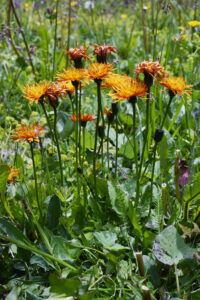
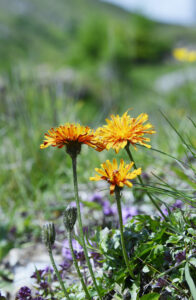
The generic name was used as early as in the 1500s by Swiss physician and naturalist Conrad Gessner (see below) in his work Historia plantarum et vires (1541). It is derived from the Arabic name of these plants, darawnaj or darawnij.
The common name stems from the specific name of D. pardalianches, derived from Ancient Greek pardalis (‘leopard’) and ankhein (‘to strangle’). According to Roman naturalist Pliny the Elder (23-79 A.D.), juice from a Doronicum species was rubbed on meat in the belief that it would cause leopards, which ate it, to die from asphyxiation.
With help from his uncle and his teachers, Conrad was able to attend schools in Zürich, where he studied classical languages. When he was 17 years old, they arranged for him to study theology at universities in France, but due to religious persecution he had to return to Zürich. It was arranged for him to study Hebrew in Strasbourg, and in 1536 he obtained a paid leave of absence to study medicine at the University of Basel.
In 1537, at the age of 21, he published his first book, titled Lexicon Graeco-Latinum, which earned him the professorship of Greek at the newly founded academy of Lausanne. Besides teaching, he devoted himself to scientific studies, especially botany. In 1541, he obtained his doctoral degree, and then returned to Zürich to practice medicine, and to give lectures at the Carolinum (later the University of Zürich). He spent much of his leisure time going on botanical collection trips in the mountains of Switzerland.
His first major work was Bibliotheca (1545), relating the history of bibliography, a catalogue of all the writers who had ever lived, and their works. Historiae animalium, published 1551-58, was a monumental work on animal life, but he only published two botanical works, Historia plantarum et vires (1541) and Catalogus plantarum (1542). While working on a major botanical work, Historia plantarum, he died from the plague, only 49 years old.

The specific name refers to Austria. Presumably, the type specimen was collected there.
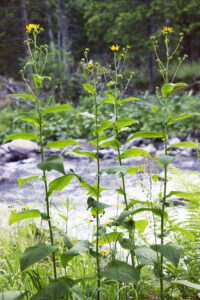
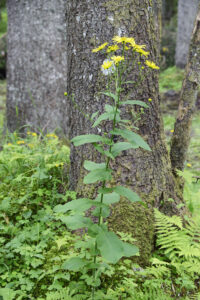
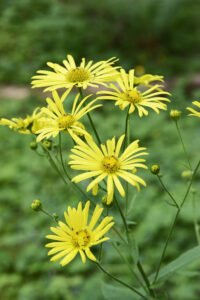
This species grows in humid and often shady areas among limestone rocks, at altitudes from 500 m up to 2,100 m. It is distributed in the eastern Alps and the Carpathians, on the Balkan Peninsula, and in Italy.
The specific name is derived from the Latin columna (‘pillar’), perhaps alluding to the dense, ‘columnar’ growth of the plant.
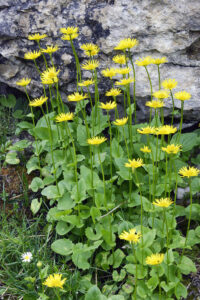
It is mainly found on eroded mountain slopes in areas of limestone, growing among rubble and gravel. It is native to the Alps, the Pyrenees, and mountains on the Balkan Peninsula and in Corsica, growing at altitudes between 1,400 and 3,400 m.
The specific name is Latin, meaning ‘with large flowers’, referring to the flowerheads, not the individual flowers. The obsolete specific name is Latin, meaning ‘scorpion-like’, which alludes to the thick, curved rootstock of the plant.
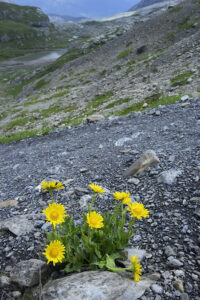
These plants are characterized by their thistle-like appearance, but are easily identified by the spherical flowerhead, which resembles a spiny ball. This inflorescence gave rise to the generic name, derived from Ancient Greek ekhinos (‘hedgehog’) and ops (‘head’).
It is native from central Europe eastwards to central Siberia, Xinjiang, and Mongolia, southwards to Spain, Turkey, and Turkmenistan, growing in gravelly places up to altitudes around 2,400 m.
The specific name is unexplained.
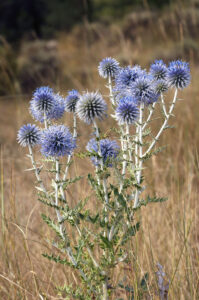
The generic name is derived from Ancient Greek hierakion, a diminutive of hierax (‘hawk’). According to an ancient legend, hawks were able to hone their eye sight with the milky juice of these plants. Alternatively, the name may refer to the tip of the ray florets, which resemble hawk wings.
It is distributed in mountains of central and southern Europe, from France eastwards to Ukraine, and from Germany and Poland southwards to Italy and the Balkans, growing at altitudes from 1,100 to 2,700 m.
The specific name is Latin, meaning ‘hairy’.
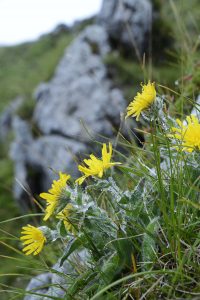
The generic name, previously written Hypochoeris, is probably derived from Ancient Greek hypo (‘under’) and choeris (‘young pig’), alluding to the fact that pigs enjoy eating the root of common cat’s-ear (H. radicata). The English name refers to the leaves of this species, which are covered in rough hairs.
This species is partial to meadows and pastures, mainly on siliceous soil, found at altitudes between 1,300 and 2,600 m. It is distributed from the western Alps eastwards to the Balkans, the Carpathians, the Tatra Mountains, and Ukraine.
The specific name is Latin, meaning ‘one-flowered’, referring to the solitary flowerhead.
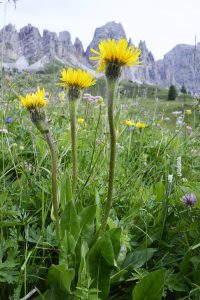
The generic name refers to Jacobus, in English called James the Great, one of the twelve apostles of Jesus. He is the patron saint of Spain and, according to tradition, his remains are housed in the city of Santiago de Compostela, Galicia, known as the culmination of the Camino de Santiago pilgrimage route.
The name ragwort was given in allusion to the ragged foliage of many members of the genus.
The stem is erect, green or reddish, usually smooth, much branched, sometimes reaching a height of 2 m, but usually lower. The leaves, to 20 cm long and 6 cm wide, are pinnately lobed, the lobes toothed along the margin. The very numerous flowerheads, to 2.5 cm across, have 10-15 yellow, strap-shaped ray florets and many orange disc florets. The flowers are much visited by bees, hover flies, and butterflies.
The specific name is Latin, meaning ‘common’.
Popular names of this species include stinking willie and mare’s fart, alluding to the unpleasant smell of the leaves.
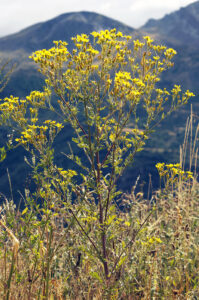
The generic name was the classical Latin name of the garden lettuce (L. sativa), derived from lactis (‘milk’), alluding to the milky sap of this plant.
The stem is to 60 cm tall, erect, branched above, smooth, leaves mostly basal, bluish-green, stalked, pinnate, segments linear to lanceolate, lobed or toothed. Stem leaves gradually get smaller up the stem, less divided and clasping. Flowerheads, to 4 cm across, contain only ray florets, blue or purple, rarely white.
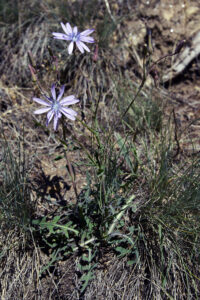
The generic name was applied by Scottish botanist Robert Brown (see below), derived from Ancient Greek leon (‘lion’) and podion (‘small foot’), presumably in allusion to the fuzzy involucral bracts, which somewhat resemble a lion’s paw.
By 1800, Brown was one of the foremost botanists in Ireland, corresponding with a number of established botanists. In 1801, he became a member of an expedition to Madeira, South Africa, and Australia, on board the Investigator, whose captain was British navigator and cartographer Matthew Flinders (1774-1814). For three and a half years, Brown studied Australian plants, collecting about 3,400 species, of which about 2,000 were previously unknown to science.
In 1810, he published his results from the expedition in Prodromus Florae Novae Hollandiae et Insulae Van Diemen (‘Preliminary Flora of New Holland [today Australia] and van Diemens Island’ [today Tasmania]), the first systematic account of the Australian flora.
The same year, he was appointed librarian of the famous botanist Joseph Banks (1743-1820), and when Banks died in 1820, Brown inherited his library and herbarium, which were transferred to the British Museum in 1827.
In 1830, Brown was one of the founding members of the Royal Geographical Society, and he served as president of the Linnean Society 1849-1853.

It is easily identified by the densely woolly bracts, forming a two-layered star around the flowerhead, which has only 5-6 yellow florets. The stems are very short, usually below 10 cm, occasionally to 20 cm. The spatulate leaves, to 3 cm long and 5 mm wide, are silvery-green, woolly, but much less so than the bracts.
Despite being rather non-descript, this species is one of the most beloved flowers of the Alps and the Balkans, being a national symbol of several countries: Switzerland, Austria, Slovenia, Romania, and Bulgaria.
In German, edelweiss means ‘noble white one’, and in the 19th Century it became a symbol of purity. Some even claimed that collecting this plant demanded great courage, which, of course, is pure nonsense, as it grows in alpine meadows and on slopes, and is thus very easy to collect. In his novel Edelweiss, from 1861, German novelist Berthold Auerbach (1812-1882) ridiculously exaggerates this difficulty by claiming that “the possession of one is a proof of unusual daring.”
As time went by, so many plants had been collected that it became rare in many areas. As late as in 1946 and 1947, rangers in the northern part of Tyrol confiscated about 6,400 plants, and in 1959, 288 plants were confiscated in the Ötztal Valley.
Edelweiss was formerly used as a traditional remedy against abdominal and respiratory diseases. In Tyrol, it was boiled in milk and eaten with butter and honey against stomach ache, and it was added to tea to treat tuberculosis, diarrhoea, and dysentery. An ointment of the plant was used against rheumatism and diphtheria.
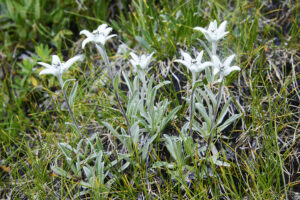
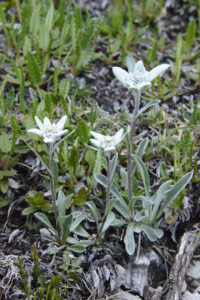
The generic name is derived from Ancient Greek leukos (‘white’) and anthemon (‘flower’), alluding to the white ray florets of the genus. The disc florets are yellow. Previously, these plants were placed in the genus Chrysanthemum.
This plant, which mostly grows in rocky areas, is distributed in montane areas of central and southern Europe.
The specific name is Latin, meaning ‘burnt’, presumably referring to the blackish-brown margin of the involucral bracts.
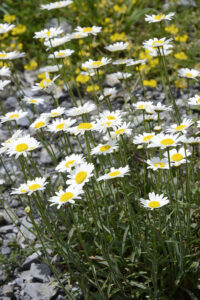
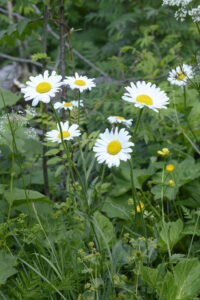
The stem grows to about 1 m tall, basal leaves stalked, up to 25 cm long and 7 cm wide, spatulate to obovate, toothed along the margin, stem leaves sessile, much smaller, to 7.5 cm long, also toothed, base usually deeply lobed or fringed with slender segments. Flowerhead to 7.5 cm across, usually solitary on long terminal stalks. The white ray florets are 15-30 in number, strap-shaped, to 2.4 cm long, apex usually with 3 small teeth. Disc florets yellow, very numerous, sometimes up to 500, forming a slightly domed centre.
Before the introduction of chemical herbicides, it was a troublesome weed in meadows. In his delightful book All about Weeds, American botanist Edwin Spencer (1881-1964) writes: “The ox-eye daisy is a beautiful, bad weed. It can and does adorn many a flower garden, but when it climbs over the fence and ambitiously tries to adorn a whole meadow, that is just too much adornment. For after all, a meadow is not a flower garden, and beauty is as beauty does, even among plants. A cow is not sentimental, and daisies in the hay are just that much less hay to her; to her keeper they are just that much less milk.”
The specific name is Latin, meaning ‘common’.
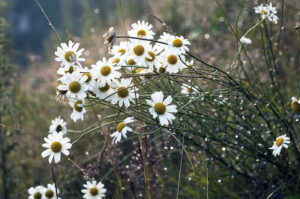
The generic name is derived from Ancient Greek petasos, meaning ’a broad-brimmed hat’, which, like the common name umbrella plant, refers to the large leaves of many species, sometimes growing to 1 m across.
The common name supposedly stems from the habit of using the large leaves to wrap around butter in hot weather, while another popular name, lagwort, refers to the late appearance of the leaves, which do not usually unfold, until the flowers have faded.
The role of these plants in folklore and traditional medicine is described on the page Plants: Plants in folklore and poetry.
It prefers to grow in damp soil in deciduous forests, often at springs or along streams, on mountain pastures, and along roads. It occurs in the major part of Europe, in Turkey, and in the Caucasus. In the Alps, it may be found from the lowlands up to elevations around 2,700 m.
The specific name is Latin, meaning ‘white’, alluding to the white disc florets.
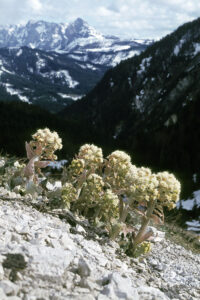
At flowering, between April and June, stems of this plant reach a height of about 30 cm, and when fruiting, they may be up to 60 cm tall. Inflorescences are dense racemes of flowerheads with reddish-white disc florets, ray florets absent. Stem leaves are often reduced to scales. The large basal leaves, which appear after flowering, are triangular or heart-shaped, toothed along the margin, to 30 cm wide, densely covered in snow-white felt beneath.
It is not clear what the specific name refers to.
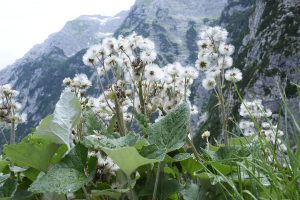
The generic name is derived from Ancient Greek prenes (‘drooping’) and anthos (‘flower’), alluding to the pendent flowerheads.
It is partial to shade, growing in forests, in particular on nutritious soil. It is widespread, occurring from western and central Europe and the Balkans, eastwards to Ukraine, the Caucasus, and Turkey. In the Alps, it may be found up to elevations around 2,100 m.
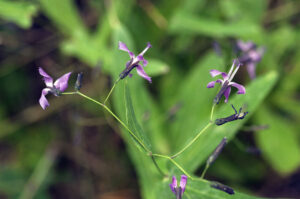
The generic name is derived from the Latin senex (‘old man’), alluding to the white seed hairs of the genus.
This plant is found in rocky areas on calcareous soils in central and southern Europe, growing at elevations between 1,500 and 3,100 m.
The specific name refers to the flowerheads, which resemble those of the genus Doronicum (above).
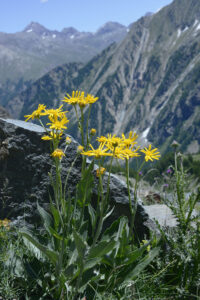
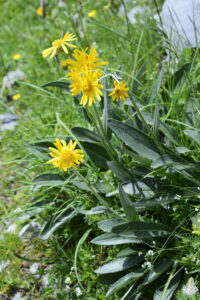
The stem is erect, to 60 cm tall, hairless or slightly hairy, leaves lanceolate, with numerous small teeth along the margin. Flowerheads are in small, stalked clusters at the apex, each to 3.5 cm across, with 10-16 yellow, strap-shaped ray florets and numerous orange disc florets.
The obsolete specific name was given in honour of French physician and botanist Joseph Pitton de Tournefort (1656-1708) who undertook an expedition to the Middle East 1700-1702, accompanied by German physician and botanist Andreas von Gundelsheimer (c. 1668-1715) and French artist Claude Aubriet (c. 1665-1742).
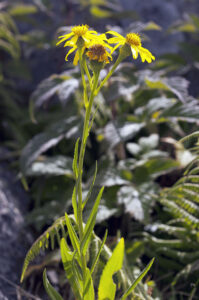
The generic name is a diminutive of the Latin serratum (‘sawn’), alluding to the serrated leaves of the species below.
This plant may reach a height of 1 m, but is usually lower. The stem is erect, pale-yellowish green, often tinted purplish, smooth, grooved, branched above, lower leaves stalked, to 25 cm long, ovate to lanceolate, varying from entire to almost pinnate, with narrow, pointed lateral lobes and a long elliptic terminal lobe. Upper leaves smaller, short-stalked or sessile. The leaf margin is sharply serrated. Flowerheads are in terminal, branched clusters, each head to 2 cm across, ray florets absent, disc florets numerous, purplish-red or lilac, rarely white or pink.
In former days, it was used medicinally for treatment of ruptures and wounds.
The specific name is Latin, meaning ‘used for dyeing’, referring to a yellow dye, which was previously extracted from the leaves of this plant. The popular name alludes to the serrated leaves.
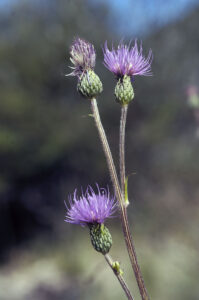
The generic name is unexplained. It may be derived from Russian tolpisja (‘a cluster’).
It may grow to 50 cm tall, stem erect, branched above, leaves almost all basal, linear or linear-lanceolate, entire or with a few teeth, narrowed towards the base. The few stem leaves are linear, entire. Flowerheads are solitary at the end of stem and branches, involucre egg-shaped, to 1.1 cm long, bracts brownish-black, mealy, pressed against the involucre. Florets sulfur-yellow. It reproduces vegetatively through underground stems.
The main area of distribution is the Alps, but it also occurs in the French Jura, in Hungary, and on the Balkan Peninsula. It thrives on calcareous soils, often growing in sand or gravel, and among rocks. In the Alps, it may be encountered up to elevations around 2,500 m.
The specific name is derived from the Latin staticum (‘remaining’) and folium (‘leaf’). Maybe the leaves remain on the plant for at long time.
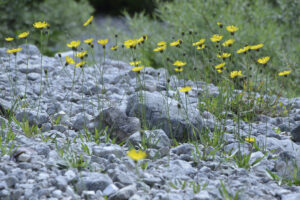
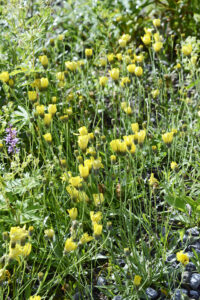
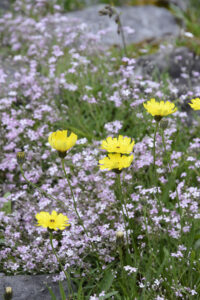
Most members of the family are native to temperate areas of the Northern Hemisphere, with some species in tropical mountains and in the Andes.
Male and female flowers are borne in separate inflorescences, males in pendulous catkins and females mostly in upright spikes. The seed is a nut or, in Betula and Alnus, a winged nutlet.
The generic name is the classical Latin name of alders. Some authorities connect the name with High German elo (’greyish-yellow’), and with Sanskrit aruna (’reddish-yellow’), referring to the fact that the wood of common alder (A. glutinosa), when cut, assumes a bright reddish-brown colour.
The common name evolved from the Old English word for these trees, alor, which is derived from Proto-Germanic aliso.
This deciduous shrub, growing to 6 m tall, has smooth, grey bark, turning blackish with age. The ovate leaves, to 8 cm long and 6 cm wide, are shiny-green on the upperside, pale green beneath, with double-serrated margin. Male catkins are pendulous, to 8 cm long, female catkins mostly erect, ovoid, to 1 cm long and 7 mm wide, in clusters of 3-10 on terminal branchlets. Initially, they are green, turning brown when mature late in the autumn.
The green alder may also reproduce vegetatively by rooting branches that touch the ground.
The specific name is quite odd, meaning ‘alder-birch’.
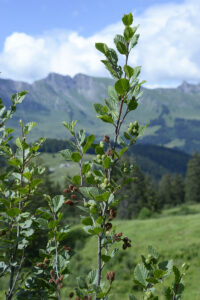
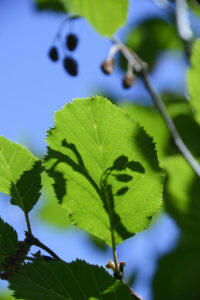
The origin of the names Myosotis and forget-me-not, and the role of these plants in folklore, is described on the page Plants: Plants in folklore and poetry.
The erect stems may grow to 45 cm tall, but are often much lower, sometimes tufted, covered in soft hairs. Basal and lower stem leaves stalked, narrowly oblanceolate or linear, to 8 cm long and 1.2 cm wide, hairy, upper stem leaves sessile, smaller. Inflorescences are scorpoid cymes, to 15 cm long, corolla blue, to 8 mm across, with white throat, encircled by 5 white or yellow scales.
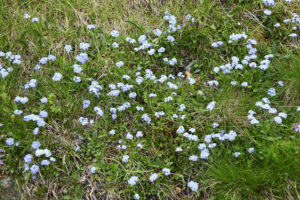
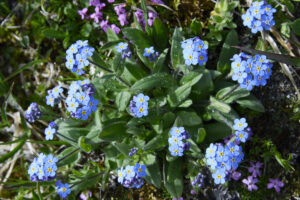
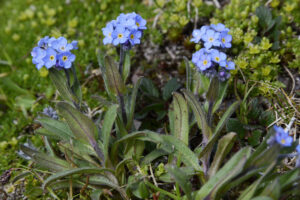
The generic and English names both allude to the former usage of the common lungwort (P. officinalis) to treat lung problems.
This plant is restricted to western Europe, found from the Pyrenees and the western Alps northwards to Belgium, Luxembourg, and the Rhine Province of Germany. It grows in deciduous forests and forest meadows, and along forest edges.
The specific name is not very appropriate, as the plant also grows in lowlands.
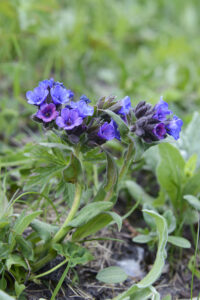
Petals are always 4 in number, arranged cross-wise, which has given rise to the alternative family name Cruciferae, derived from the Latin crux (‘cross’) and ferae (‘bearing’). The fruit is a carpel, which, at maturity, splits into two valves, either less than 3 times as long as broad (a silicula), or more than 3 times as long as broad (a siliqua).
Many members of this family are very similar, and ripe fruits are often necessary for identification.
The fruit of these yellow-flowered plants is highly distinctive, being divided into two circular parts, resembling a pair of spectacles.
The generic name is derived from the Latin bi (‘two’) and scutellum, diminutive of scutum (’shield’), referring to the shape of the fruit. In the old days, shields were often circular.
The common name also refers to the fruit, a buckler being a small, round shield, in the past held by a soldier with a handle or strapped to his forearm. The word is derived from Old French (escu) bocler, literally ‘(shield) with a buckle’.
The stem, branched above, grows to about 40 cm tall, leaves lanceolate, coarsely hairy, to 12 cm long and 1.5 cm wide, either entire with a few teeth along the margin, or pinnate. The leaves are gradually smaller up the stem. The yellow flowers are numerous, in loosely branched, terminal racemes, petals narrowly egg-shaped, to 8 mm long. The fruit, divided into two circular parts, is to 5 mm long and 12 mm wide, each part containing a single seed.
The plant sometimes propagates through root shoots.
The specific name is Latin, meaning ‘smooth’, alluding to the smooth fruits.
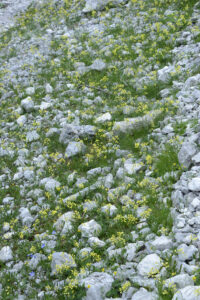
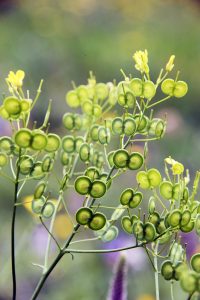
The generic name is derived from Ancient Greek kardamon, the name of a kind of cress. The common name bittercress probably refers to the taste of C. amara (below).
It is partial to springs and other damp places, preferably with running water, on nutrient-rich soils. It is native to all of Europe, except Iceland, eastwards to western Siberia, southwards to Turkey and the Caucasus. In the Alps, it may be encountered up to elevations of at least 2,000 m.
The plant is rich in vitamin C, and in former times it was used as a remedy to prevent scurvy.
The specific name is Latin, meaning ‘bitter’.
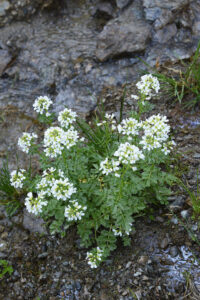
This species, previously known as Dentaria enneaphyllos, grows in deciduous forests and shrubberies on calcareous soils. It is distributed from southern Scotland and Germany southwards to the Mediterranean, and from central France eastwards to Ukraine and the Crimean Peninsula. In the Alps, it mainly occurs in the valleys.
The specific name is derived from Ancient Greek ennea (‘nine’) and phyllon (‘leaf’), referring to the 3 leaves each being divided into 3 leaflets, giving the impression that the plant has 9 leaves (see picture below).
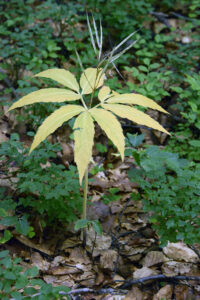
The generic name is derived from Ancient Greek drabe, a kind of cress. The popular name whitlow-grass stems from an old belief that members of this genus were able to cure whitlow, i.e. inflammation at the end of a finger or toe.
It grows in gravel and among rocks in calcareous areas, distributed in mountains of southern and central Europe, from the Pyrenees across the Alps to the Carpathians, in the Vosges, the Jura, the Cévennes, the Belgian Ardennes, and on the Gower Peninsula, Wales. In the Alps, it mainly occurs at altitudes between 1,400 and 3,400 m, occasionally encountered down to 400 m.
The specific name is derived from Ancient Greek aei (‘forever’) and zoion (‘something alive’), thus ‘living forever’, referring to the evergreen foliage.
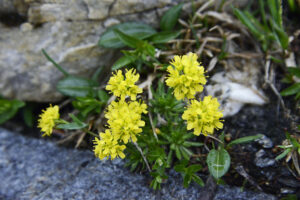
The generic name is derived from the name Eruca (another genus in Brassicaceae), and the Latin suffix aster (‘resembling’).
The stem grows to 60 cm tall, erect, branched, hairy at the base, leaves pinnate, with 4-8 lobes on each side. Inflorescences many-flowered, terminal, petals yellow, to 9 mm long, the stalked siliquas to 5 cm long.
In classical Latin, Gallicum referred to the lands of the Gauls, who were various tribes, primarily inhabiting what is now France and Belgium. In New Latin, it merely indicated France. The type specimen may have been collected in France.
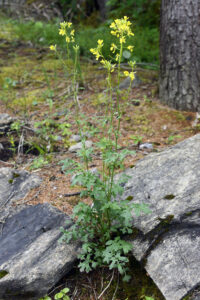
The natural range of this plant is from the Pyrenees, the Alps, and the northern Balkan Peninsula northwards to northern France and Germany, northwards to central Baden-Württemberg, Franconian Alb, and the Rhine area. It is also found in eastern Europe, eastwards to Ukraine and the European part of Russia, but may be introduced here. In the Alps, it mainly occurs in the foothills, but may be encountered up to elevations around 2,000 m. It is partial to moist, nutrient-rich soils, often colonizing sandy or gravelly banks of lakes and rivers.
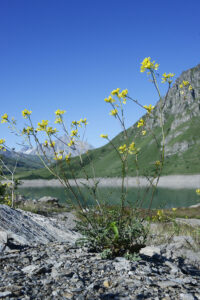
It is native to mountains of the Iberian Peninsula, the Pyrenees, and the south-western Alps, growing on arid and rocky slopes at elevations between 1,500 and 2,500 m.
The generic name honours French botanist and teacher Auguste Huguenin (1780-1860), who lived in Savoie. The specific name means ‘with leaves like Tanacetum‘ (tansy, T. vulgare).
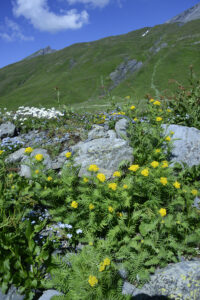
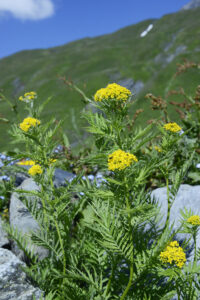
The generic name is a Latinized form of thlaspis, the classical Greek term for a kind of cress, possibly derived from thlaein (‘flattened’). The popular name was given in allusion to the flat, circular fruits, shaped like coins.
This species is distributed from eastern France across the Alps to the northern part of the Balkans. It grows on limestone, usually at elevations between 1,600 and 2,800 m, but has been encountered near the peak of the mountain Theodulhorn (3469 m) in southern Switzerland.
The specific name is Latin, meaning ‘with round leaves’.
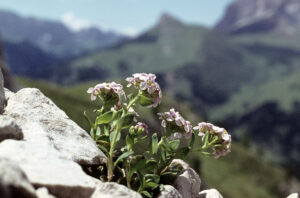
The family includes lobelias and allies, comprising about 1,200 species previously placed in a separate family, Lobeliaceae, which is now regarded as a subfamily, Lobelioideae, of Campanulaceae.
The generic name is derived from Ancient Greek aden (‘gland’) and phorea (‘to bear’), referring to the nectar glands.
This plant is distributed from central Europe eastwards to central Siberia and the Altai Mountains of Xinjiang and western Mongolia. In central and south-eastern Europe, it occurs in scattered locations, growing in sunny areas along forest margins, in shrubberies, and in grassy areas.
The specific name is Latin, meaning ‘with leaves like lilies’.
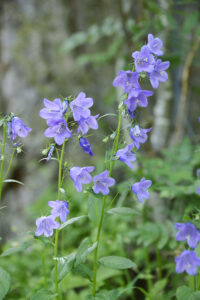
The generic name and the popular name, as well as the name of the entire family, were applied in allusion to the bell-shaped flowers of this genus, from the Latin campanula (’little bell’), the ‘bell’ consisting of five fused petals with free tips. This name was first used in 1542 by German physician and botanist Leonhart Fuchs (see Allium schoenoprasum above).
This species is common throughout the Alps, and also occurs in the Sudetes and the Tatra Mountains, growing in pastures, meadows, and light forest, at altitudes between 600 and 3,000 m. A few small and vulnerable populations are found in southern Norway, possibly relict populations from the latest Ice Age.
In Kärnten, southern Austria, especially skilful reapers and mowers would attach the white-flowered form to their hat as a sign of outstanding efficiency.
The specific name is Latin, meaning ‘bearded’, like the common name alluding to the long hairs along the edge of the petals. In the Italian part of Tyrol, two folknames were braghie del cucu (‘cuckoo’s sock’) and barete de moneghe (‘nun’s cape’), both alluding to the flower shape.
The similarity of its basal leaves to those of the common viper’s bugloss (Echium vulgare) caused Swiss botanist Gaspard Bauhin (see genus Cirsium above) to name it Campanula foliis Echii, floribus villosis (‘small bell with leaves like viper’s bugloss, and with hairy flowers’).
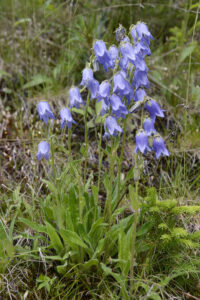
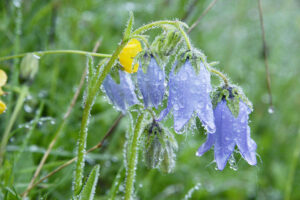
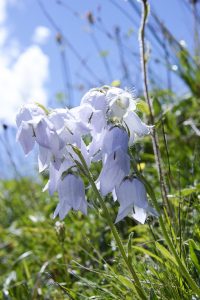
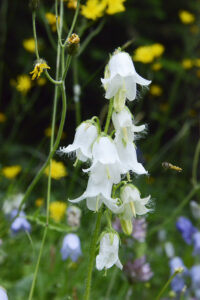
It is restricted to the south-eastern Alps, from the Dolomites to Slovenia, often growing on rocks.
The specific name refers to Carnia, a historical region in the border area between Italy and Slovenia. Presumably, the type specimen was collected there.
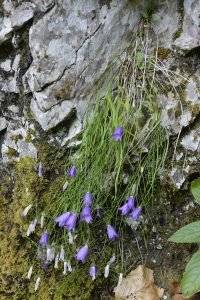
It is mainly found in limestone regions, growing in grassy areas and among gravel. It is distributed from the Pyrenees eastwards across the Alps to the Carpathians and the Balkan Peninsula. It is also found in the French Massif Central and in the Black Forest and the Swabian Alb, southern Germany. In the Alps, it may be encountered up to altitudes around 3,000 m.
Leaves and flowers are edible, raw or cooked, with a pleasant mild flavour.
The specific name is Latin, meaning ‘with leaves like Cochlearia‘ (scurvy-grass). The popular name fairy’s thimble alludes to the small size of the flowers and to their shape.
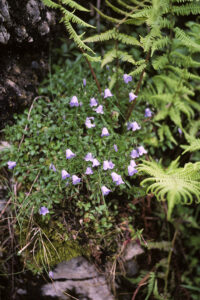
It grows on calcareous soils in open forests, shrubberies, dry grasslands, and sometimes along roads and trails. It is native to northern temperate areas of Eurasia, from almost all of Europe eastwards to the Pacific, southwards to the Mediterranean, Iran, the Himalaya, northern China, and Japan. It has also become naturalized in North America. In the Alps and the Pyrenees, it usually grows at elevations below 1,500 m, but may occasionally be encountered up to 2,000 m.
The specific name is Latin, meaning ‘gathered in a group’, referring to the dense inflorescence. An old folk name is Dane’s blood, alluding to the fancy belief that this plant sprouted in places, where Danish Vikings had been slain in battle.
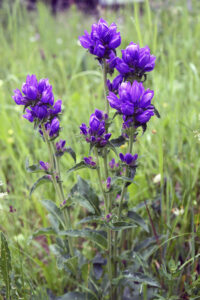
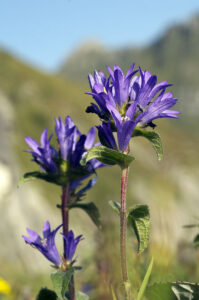
This species grows in forests and shrubberies, found in almost all of Europe and western Asia, eastwards to western Siberia, Kazakhstan, and the western Himalaya. In the Alps, it may be found up to elevations around 1,500 m.
The specific name is Latin, meaning ‘with broad leaves’.
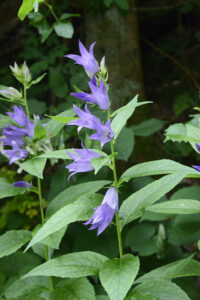
This species grows in open forests, shrubberies, fields, gardens, and along roads, railways, and hedgerows, preferably in partial shade. It spreads by underground rhizomes, often forming dense stands. Even a small piece of rhizome can spout into a new plant, making it very hard to eradicate, once it has entered a garden.
It is found in all of Europe, except Iceland and the British Isles, southwards to the Mediterranean, Turkey, and Iran, eastwards to central Siberia and Central Asia. It has also been introduced to North America, where it has become an extremely invasive weed. In the Alps, it may be found up to elevations around 2,000 m.
The specific name refers to the similarity of this plant to C. rapunculus, whose specific name is a diminutive of the Latin rapa (‘turnip’), thus ‘little turnip’, referring to the shape of the root. C. rapunculus is described on the page Plants: Plants in folklore and poetry.

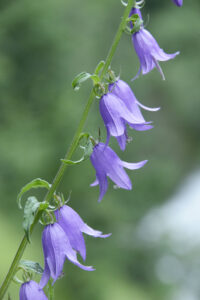
It is widely distributed in subarctic and temperate areas of Eurasia, from Iceland eastwards to eastern Siberia, southwards to the Mediterranean, the Caucasus, and north-eastern China. It is very common in most parts of Europe, growing mainly on dry, acidic soils. In the Alps, it may be found up to elevations around 1,500 m.
Previously, it was thought that almost similar North American plants were subspecies of the harebell, but they have since been upgraded to separate species, named C. petiolata and C. alaskana.
The specific name is Latin, meaning ‘with round leaves’, alluding to the basal leaves.
English poet William Shakespeare (1564-1616) mentions harebell in his play Cymbeline, in which the main character is the early Celtic king Cunobeline, who ruled in Britain about 9-40 A.D.
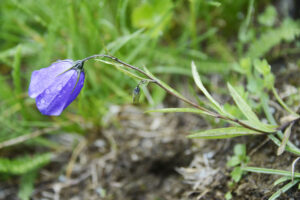
It is widely distributed in montane areas of Europe, from northern Spain across the Pyrenees, the Jura, the Black Forest, the Alps, and the Apennines to the Carpathians and the Balkans. In the Alps, it grows at elevations between 1,400 and 3,250 m, whereas in the Black Forest it may be encountered down to 1,000 m.
It was named in honour of Swiss botanist and plant collector Johannes Gaspar Scheuchzer (1684-1738), who specialized in studying grasses.
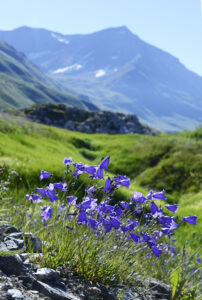
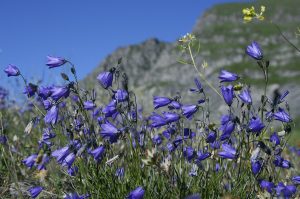
It grows in montane grasslands and stony areas in the central and southern Alps, the Apennines, the Abruzzo Mountains, and on the Balkan Peninsula, found at altitudes between 400 and 2,500 m.
The specific name is Latin, meaning ‘with a spike’.
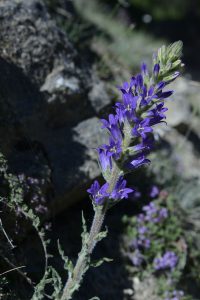
It is native to the Alps, the souther Juras, the Dinaric Alps, and mountains in the northern part of the Balkan Peninsula, growing at altitudes between 1,000 and 2,900 m.
The specific name is Latin, meaning ‘resembling a thyrsus’ – a staff associated with the wine god Dionysus, made from a stem of giant fennel (Ferula communis), entwined with foliage of ivy (Hedera helix). The name refers to the erect, staff-like inflorescence.
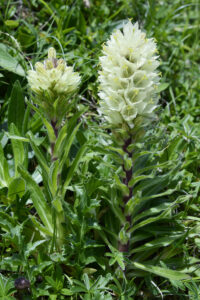
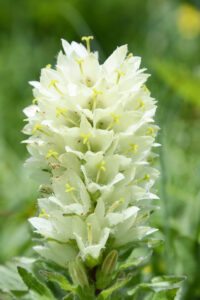
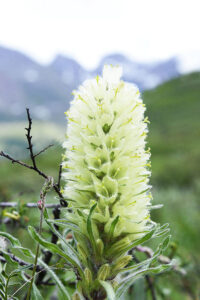
In Latin, the term iasione refers to a bindweed (Convolvulus), or a similar plant with a white flower. Why the name was applied to this genus is not clear.
The branched stem is ascending or erect, to 60 cm long, rarely up to 80 cm. The stem leaves are oblong or lanceolate, margin wavy. The upper part of the stem is without leaves. The numerous flowers are gathered in a dense, hemispherical, terminal head, to 2.5 cm across. The inflorescence resembles that of members of the scabious subfamily (Dipsacoideae), of the honeysuckle family (Caprifoliaceae), but differs in the five pale blue petals being fused into a tube at the base. Anthers are white, protruding.
The specific name is Latin, meaning ‘of mountains’. However, this plant is mainly found in lowlands, restricted to the lower part of mountains.
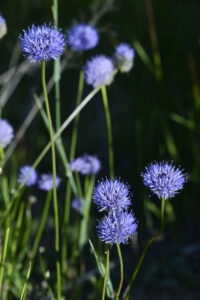
The flowers of this genus are very characteristic, arranged in dense erect panicles, each flower with a narrow, deeply five-lobed corolla, 2 cm or longer, mostly purplish-blue, sometimes pale blue, white, or pink. Initially, the corolla lobes are connected in the upper third, later separated.
The generic name is derived from Ancient Greek phyteuo (‘to plant’), but it was also the name of the rampion mignonette (Reseda phyteuma), whose leaves were cooked as a vegetable.
Stem erect, simple, smooth, to 70 cm tall. Basal leaves long-stalked, blade much longer than broad, pointed, blunt-toothed, basis heart-shaped or rounded. Upper leaves small, linear or narrowly lanceolate, sessile. The inflorescence is a dense, ovate-cylindrical spike of pale blue to violet-blue flowers, to 1.2 cm long, with a long style, which usually ends in three stigmas.
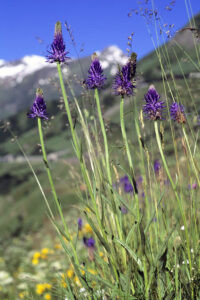

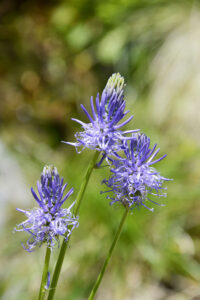
It is a small plant, to 15, sometimes 25 cm tall, branching at the base, often forming dense growths. Stems erect, often dark brown, basal leaves grass-like, linear or spatulate, entire, often bristly, to 2 mm wide. Stem leaves sessile, linear, much shorter than the basal leaves. The hemispherical flowerheads are to 2 cm across, flowers pale to dark blue, back-curved. The hairy style is protruding.
This species is distributed in montane areas of central and southern Europe, found in northern Spain, the Pyrenees, Auvergne, the French Massif Central, the Jura Mountains, the Alps, and the Apennines. It is partial to acid soils, growing at altitudes between 1,500 and 3,600 m, in some areas encountered down to 600 m.
In Austria, a local name of the plant is Zwangkräutel, relating to its former usage against rectal tenesmus, i.e. a feeling of difficulty to empty the bowel at defecation, in German called Stuhlzwang.
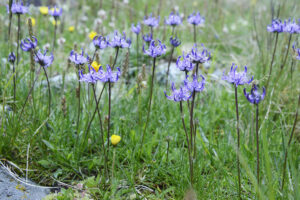
The specific name was given in honour of Italian botanist Pier Antonio Micheli (1679-1737), professor of botany in Pisa, curator of the Orto Botanico di Firenze, author of Nova plantarum genera iuxta Tournefortii methodum disposita. He was a leading authority on cryptogams (plants reproducing by spores), and discovered the spores of mushrooms.
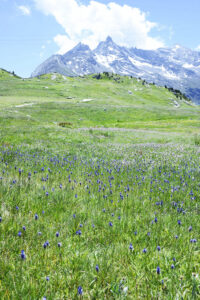
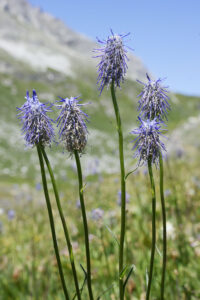
The stem is erect, simple, smooth, striated, to 50 cm high. The basal leaves are arranged in a rosette, stalked, ovate to lanceolate, upper stem leaves smaller, lanceolate to linear. The inflorescence is a dense erect panicle, to 3 cm in diameter, with up to 30 flowers, petals sky blue or violet-blue.
This plant was named already in the 1600s. Swiss botanist Gaspard Bauhin (see genus Cirsium above) called it Rapunculus folio oblongo, spica orbiculari (‘rampion with long leaves and a ball-shaped head’), whereas English herbalist John Parkinson (1567-1650) named it Alopecuroides orbiculatus (‘ball-shaped foxtail-like’).
It was told that you shouldn’t pick the plant, as it would attract lightening.
In England, it is also known by the name The Pride of Sussex, as it is most common in that area.
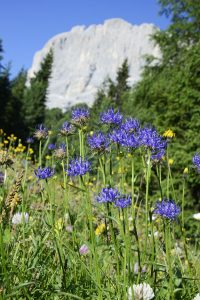
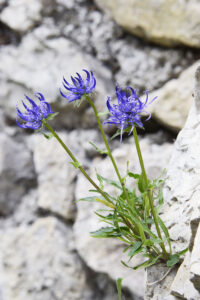
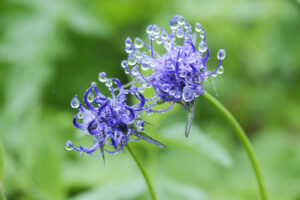
This species is found in nutrient-rich meadows, shrubberies, and forests at altitudes between 1,000 and 2,400 m. It is distributed from the Pyrenees eastwards via the French Massif Central and the Alps to the Dinaric Alps in Slovenia.
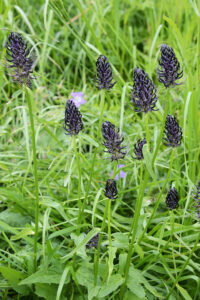
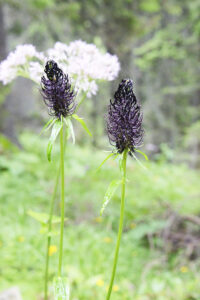
This species is widely distributed in western Europe, from southern Norway southwards to Spain, and from the British Isles eastwards to the Carpathians. In the northern part of this area, it is mainly restricted to broad-leaved forests, especially beech (Fagus sylvatica), but further south it also grows in mountain meadows up to altitudes around 2,100 m.
Young leaves and root are edible.
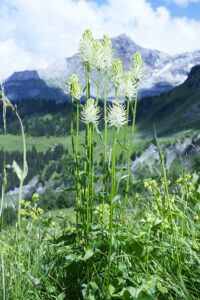
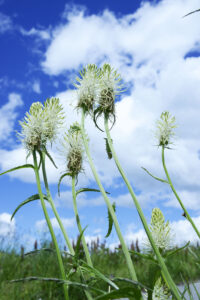
The family name is derived from Caprifolium, an older synonym for the genus Lonicera, derived from Proto-Indo-European kapros (‘goat’) and the Latin folium (‘leaf’).
The flowers are densely clustered in a terminal hemispherical head, resembling composites, family Asteraceae. This gave rise to the generic name, derived from Ancient Greek kephale (‘head’), and the Latin suffix aria, thus ‘with a head’.
It is distributed around the Mediterranean, growing in open areas, such as fallow fields, along roads etc. It is found from sea level up to elevations around 1,400 m.
The specific name is derived from Ancient Greek leukos (‘white’) and anthos (‘flower’),
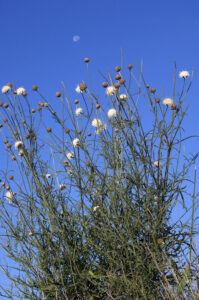
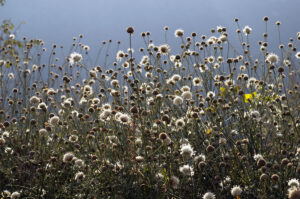
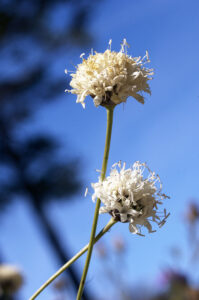
These plants are usually called scabious, although, strictly speaking, that name is reserved for a related genus, Scabiosa. The generic name was applied by Swedish botanist Carl Linnaeus (1707-1778) in honour of two German brothers, Christoph Knaut (1638-1694) and Christian Knaut (1656-1716), both botanists and physicians. The latter published Compendium Botanicum sive Methodus Plantarum Genuina, in which he provided a classification system for flowering plants, based on petal number and arrangement.
Previously, these plants were placed in the scabious family (Dipsacaceae), but this family has been reduced to a subfamily, Dipsacoideae, within the honeysuckle family. The flowers are densely clustered in a terminal head, resembling composites, family Asteraceae.
The main distribution area of this species is the Alps and the Pyrenees, at elevations between 400 and 2,100 m. It also occurs in Hungary and the Balkans, and further north in scattered locations in Germany, Belgium, and the Netherlands. Its habitat includes grassy areas, forest margins, and open forests.
The specific name is Latin, meaning ‘with leaves like Dipsacus‘ (teasel).
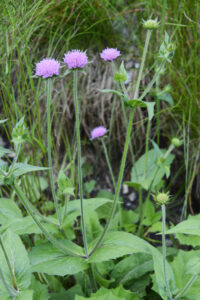
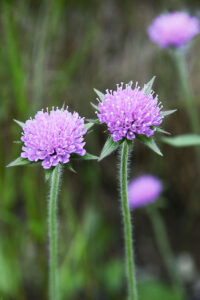
It grows in grasslands, shrubberies, and forest clearings, preferably on calcareous soils. It is distributed in the southern and eastern Alps, the Carpathians, and the Balkan Peninsula.
The specific name is Latin, meaning ‘with long leaves’.
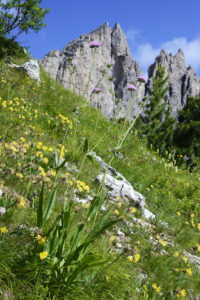
Previously, these plants were placed in the family Valerianaceae, which has now been reduced to a subfamily, Valerianoideae, of the honeysuckle family.
The generic name is derived from the Latin valere (‘to be strong, healthy’), alluding to the medicinal properties of many valerian species.
It is found in montane areas of southern Europe, in Portugal, Spain, the Pyrenees, the Alps, Sardinia, Corsica, the Italian mainland, the Czech Republic, Poland, all the Balkan countries, and Turkey. It grows exclusively on calcareous soils. In the Alps, it occurs at elevations between 600 and 2,600 m.
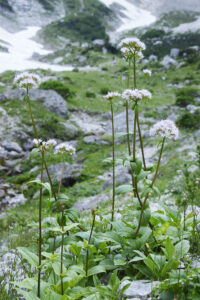
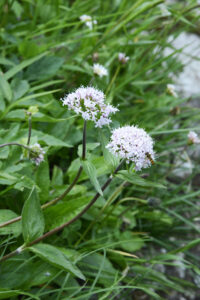
Some authorities refer to the subspecies as V. excelsa ssp. versifolia. It is restricted to the Alps, growing in grasslands and shrubberies up to elevations of at least 2,150 m.
The specific name is derived from the Latin officina (‘workshop’ or ‘office’), and the suffix alis, thus ‘made in a workshop’. However, in a botanical context, the word denotes plants species that were sold in pharmacies due to their medicinal properties.
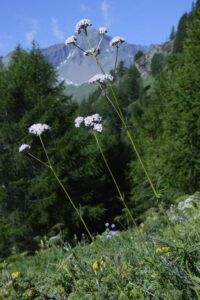
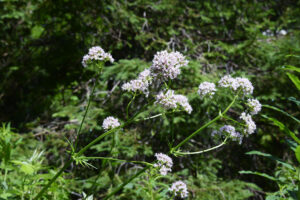
The family name refers to the clove pink (Dianthus caryophyllus), which has a clove-like fragrance. The Ancient Greek name of the clove-tree was karyophyllon, derived from karyon (‘nut’) and phyllon (‘leaf’), which was adopted by early botanists in the form Caryophyllus aromatica (today Syzygium aromaticum). The family name was linked to the clove pink by French botanist Antoine Laurent de Jussieu (1748-1836), known as the first person to publish a natural classification of flowering plants. The clove pink is presented on the page Plants: Urban plant life.
It is limited to Europe, occurring in mountains of central and southern Europe, in the Cantabrian Mountains and the Sierra Nevada of Spain, the Pyrenees, the French Massif Central, the Vosges, the Black Forest, the Alps, the northern Apennines, Corsica, the Balkans, and the Carpathians. In Norway, Sweden, Finland, and the north-western part of Russia, it is found northwards almost to the Arctic coast.
In the Alps, it thrives at altitudes between 800 and 2,900 m, preferably on silicate soils.
The specific name is Latin, meaning ‘growing among rocks’.

The generic name is derived from Ancient Greek keras (‘horn’), alluding to the horn-shaped capsules, which protrude from the calyx.
The plant is often prostrate, forming dense clumps, but may also grow erect or ascending stems, to 45 cm high. It is usually hairy, often glandular-hairy above. Leaves are linear, lanceolate or oblong, to 3.5 cm long. The inflorescence is sometimes single-flowered, but usually with 3 or more flowers, to 2 cm across, with 5 green, hairy sepals, to 7 mm long, and 5 white, deeply cut petals, to 1.5 cm long. The capsule is to 1.5 cm long. In rainy or cold weather, the flowers remain closed.
The specific name is derived from the Latin arvus (‘cultivated’), thus meaning ‘growing in fields’.
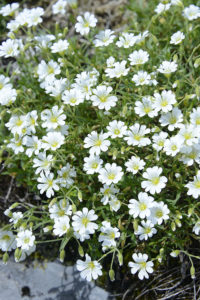
This species thrives best on acid, stony soils and among rubble, occurring at altitudes between 1,900 and 3,400 m.
The specific name is Latin, meaning ‘one-flowered’.

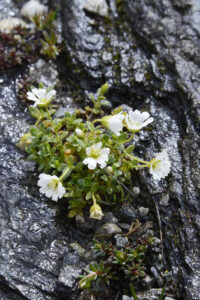
The generic name is a Latinized form of Ancient Greek Dianthos, a term first applied by Greek scholar and botanist Theophrastos (c. 371-287 B.C.), derived from Dios (Zeus) and anthos (‘flower’).
As for the common names, the verb ‘to pink’ dates from the 14th Century, meaning to decorate with a perforated or zigzag pattern. The flowers of many members of this genus have numerous fringes on the petals, so they were named pinks. This means that the colour pink derives its name from the colour of the petals of many of these flowers, not the other way around. The term carnation is believed to have been derived from the Latin corona-ae (‘wreath’, ‘garland’, or ‘crown’), as these flowers were often used in Greek and Roman ceremonial wreaths.
This species is native to Europe, from Spain and France eastwards to the northern Balkans and Ukraine, northwards to Belgium and Poland, occurring in dry, grassy, sunny habitats. In the Alps, it occurs from the lowland up to elevations around 2,500 m.
The specific name alludes to the landscape of Chartreuse in France, more specifically to the monastery Grande Chartreuse of the Carthusian Order. Apparently, this flower was much cultivated in the monastery gardens there.
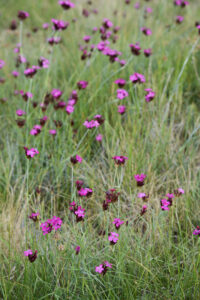
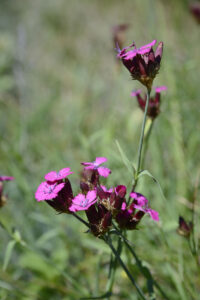
The stem is erect, branched above, smooth, to 60 cm long. Leaves opposite, simple, linear and sessile, more or less erect, to 10 cm long and 3 mm wide, at the base fused to a sheath. The calyx is a green cylindrical tube, to 2 cm long, with green or reddish teeth. The flowers are usually gathered in clusters of 3–5, petals pink, pale pink, or whitish, to 1,5 cm long, darker near the centre, margins heavily fringed.
The specific name is Latin, referring to the city Montpellier in southern France. Presumably, the type specimen was collected there.
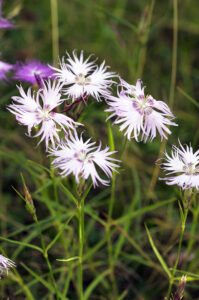
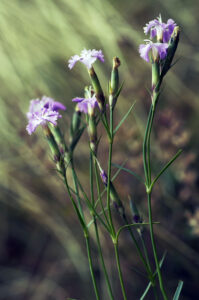
This species is partial to limestone, found from the Dolomites in north-eastern Italy eastwards to southern-most Austria, Slovenia, and Croatia.
It was named in honour of Bohemian theologian, politician, mineralogist, and botanist Kaspar Maria von Sternberg (1761-1838), who is regarded as the founder of modern paleobotany.
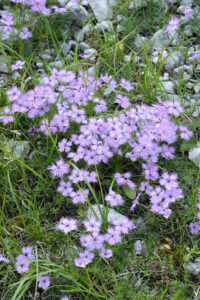
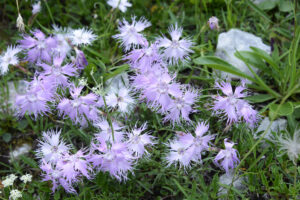
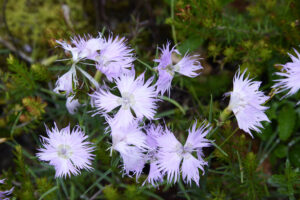
It is widespread in the Alps, growing on sunny slopes and among rocks, at elevations between 1,600 and 2,800 m. It also occurs in the Balkans, Spain, Morocco, and Algeria.
The specific name means ‘growing in woods’, derived from the Latin silva (‘forest’).
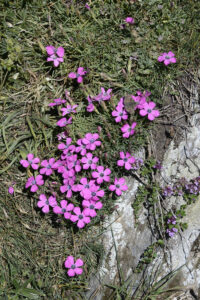
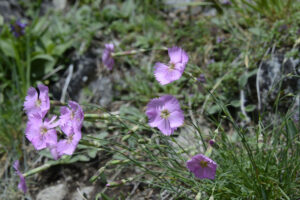
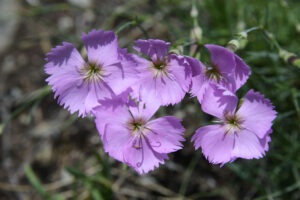
The generic name is derived from Ancient Greek gypsos (‘gypsum’) and philios (‘to love’), alluding to the preference of some of these plants to grow on gypsum-rich soils. A popular name of the genus is baby’s-breath, which, according to some sources, refers to the abundance of small and delicate flowers of a cultivated species, G. paniculata. However, the name may simply refer to the fragrance of some species.
This plant is common in the Alps and the Pyrenees, growing in grassy areas or among rocks on calcareous or gypsum-containing soils, at altitudes between 1,300 and 3,000 m. It is less common in other montane areas of Europe, including the Apennines, the Tatra Mountains, and the Harz.
The specific name is Latin, meaning ‘creeping’.
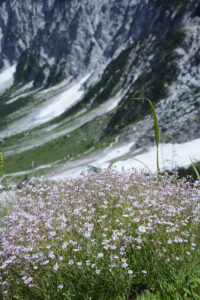
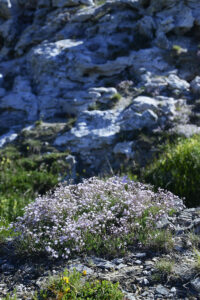
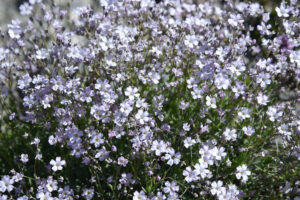
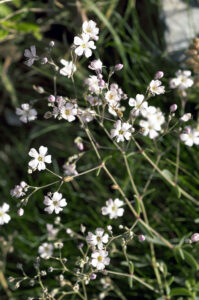
The generic name is derived from Ancient Greek helios (‘sun’) and sperma (‘seed’), referring to the crest of long papillae on the seeds of this genus.
Most leaves are basal in a rosette, dark green, linear or lanceolate, to 5 cm long and 5 mm wide, stem leaves similar, but shorter. Stems erect or ascending, green or brownish, branched, smooth or downy, to 30 cm tall. Flowers terminal, to about 2 cm across, petals snow-white, with a jagged, 4-lobed tip, sometimes hairy.
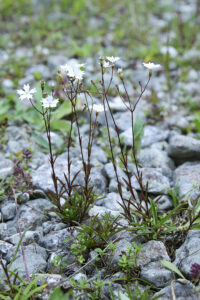
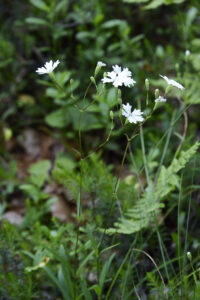
The generic name is derived from the Latin sapo (‘soap’), referring to the usage of common soapwort (S. officinalis) as lather. The role of this plant in folklore and traditional medicine is described on the page Plants: Plants in folklore and poetry.
This plant is mostly prostrate and much-branched, forming dense growths, but the reddish, woody, and hairy stems may occasionally reach a height of 40 cm. Leaves are ovate to lanceolate, sessile, hairy, to 3 cm long. Inflorescences are terminal clusters of few to many flowers, petals red or pink (rarely white). The brown, very hairy sepals are fused in a tube, to 1 cm long.
The specific name is Latin, meaning ‘resembling Ocimum‘ (basil), alluding to the shape of the leaves. An English folk name of the plant is tumbling Ted, which refers to its dense, low growth.
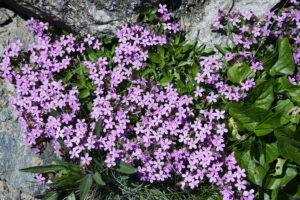
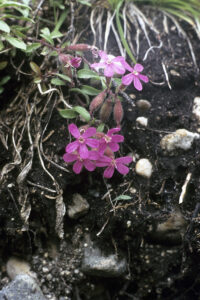
The generic name refers to the Greek woodland god Silenus, a satyr with ears and tail like a horse. He was the tutor of Dionysos, the god of wine. Silenus is often depicted drunk, covered in sticky foam from the wine. His name is derived from Ancient Greek sialon (‘saliva’). The connection to the plant genus is that the female flowers of some species, including red campion (S. dioica), secrete a frothy foam, which aids in capturing pollen from visiting insects.
The popular name catchfly refers to the strongly glandular-hairy stem and leaves in many species, where small insects often get stuck. The name campion presumably stems from the word champioun, which had many meanings, including a winning sports-person. In Ancient Greece and Rome, the rose campion (Silene coronaria) was used in garlands to crown victors.
The leathery leaves are stalkless, opposite, bright green, linear, pointed, entire, hairy along the margin, to 1.2 cm long. Flowers are terminal, solitary, short-stalked, to 2.5 cm across, petals pink or purplish-red, scaly in the throat. Sepals dark brown, fused into a tube.
This species, comprising a number of subspecies, is common and widespread in the Northern Hemisphere. It is circumpolar, further south restricted to mountains, including the Cantabrian Mountains, the Pyrenees, the Alps, the Apennines, the Carpathians, the Urals, coastal mountains of western North America, the Rocky Mountains, and Mt. Washington in New Hampshire.
In the Arctic, it occurs down to sea level, in the Alps at elevations between 1,550 and 3,700 m. In North America, it has been encountered up to altitudes around 4,200 m. It grows in windswept, rocky and gravelly places, in montane areas usually above the treeline.
The specific name is Latin, meaning ‘stemless’. However, the flowers do have a short stem. A popular name is compass plant, alluding to the flowers, which appear first on the southern side of the cushion.
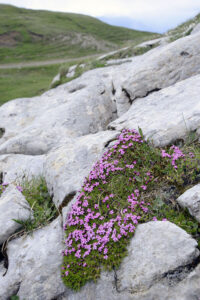
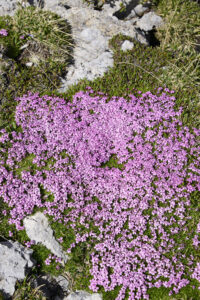
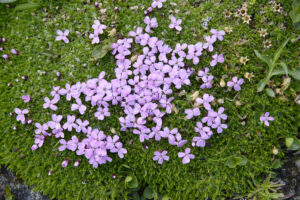
The fragrant flowers are closed during the day, opening in the evening to attract moths. The flowering is unique. Each flower blooms for 3 nights, revealing one whorl of stamens on the first night, a second whorl of stamens on the second night, and three styles on the third night, intended as a means to prevent self-fertilisation.
This plant is found in almost all of Europe, eastwards to central Siberia, Kazakhstan, and Mongolia. In the Alps, it may be encountered up to altitudes around 2,500 m.
The specific name is Latin, meaning ‘nodding’, referring to the flowers. The name Nottingham catchfly alludes to the fact that this species was once common on the walls of Nottingham Castle. Unfortunately, it no longer grows here.
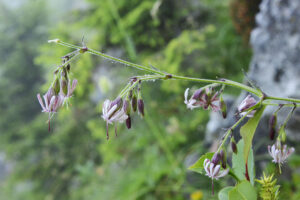
A very widespread plant, growing in grasslands and rocky areas, and on stone fences. It is distributed in almost all of Europe and North Africa, and thence across temperate areas of Asia eastwards to Mongolia and northern China. In the Alps, it grows up to elevations of at least 2,000 m, whereas in Central Asia it may be encountered up to about 4,000 m.
The specific name is Latin, meaning ‘common’.

The generic name is Latin, meaning ‘sticky’, derived from viscum, the classical Latin name of a birdlime, produced from the common mistletoe (Viscum album). This species is described on the page Plants: Plants in folklore and poetry.
The name refers to the sticky stem of the sticky catchfly, on which small insects are often caught – a fact reflected in the common name. Pictures, depicting this plant, are shown on the page In praise of the colours violet, purple and lilac.
It grows among rocks, along gravelly streamsides, on sand banks and grassy slopes, and on sea cliffs. It is tolerant to high concentrations of copper and other heavy metals. In the Alps, it occurs at elevations between 1,900 and 3,000 m.
The stem is erect, unbranched, smooth or sparsely downy, to 40 cm tall, often reddish-purple. As opposed to the sticky catchfly, the stem of this plant is not sticky.
The lower leaves are stalked, forming a rosette, stem leaves opposite, sessile, blade narrowly lanceolate or oblanceolate, pointed, to 5 cm long and 5 mm wide, with entire margins. Inflorescences are dense terminal clusters, 6-30-flowered, bracts greenish-purple, lanceolate, to 2 cm long. Flowers sessile or short-stalked, to 1 cm across, corolla dark pink with spreading petals, cleft to the middle. Calyx tubular, deep purple or greenish-purple, faintly 10-veined.
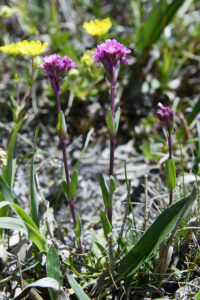
Initially, these plants were placed in the family Saxifragaceae, later in a separate family, Parnassiaceae. Following genetic research, they have been moved to the spindle-tree family. Some authorities still regard these plants as belonging to Saxifragaceae.
The generic name is derived from Parnassos, a mountain near Delphi, which, in Ancient Greek mythology, was the abode of the Muses. In his Herball (1597), English herbalist John Gerard (c. 1545-1612) mentions the names Grasse of Parnassus and Gramen Parnassi. In fact, the name of these plants dates back to Greek physician, pharmacologist, and botanist Pedanius Dioscorides (died 90 A.D.), who was the author of De Materia Medica (5 volumes dealing with herbal medicine). In this work, the description of this ‘grass’ is quite skimpy: “It has leaves similar to those of ivy, a white fragrant flower, [and a] small fruit which is not useless.” (Source: stories.rbge.org.uk/archives/26399)
In those days, the term ‘grass’ had a much wider meaning than today. It seems that the name Grass of Parnassus was given in allusion to the fact that cattle, grazing on Mount Parnassos, relished these plants, which seems quite strange, as they are poisonous – at least to people, but maybe not to cattle.
It is very widely distributed in the Northern Hemisphere, found from arctic and subarctic regions, in America southwards almost to the Mexican border, and in Eurasia southwards to North Africa, Turkey, the Himalaya, Japan, and Taiwan.
Towards the southern limits of its distribution area it is restricted to mountains, in the Alps sometimes encountered up to altitudes around 3,000 m. Its preferred habitat is wet marshes and meadows, indicated by the specific name, which is Latin for ‘growing in marshes’.
In former days, it was utilized as herbal medicine to treat disorders of the liver, and tea brewed on the leaves was taken for indigestion. Some also claimed that, when added to wine or water, the leaves could dissolve kidney stones.
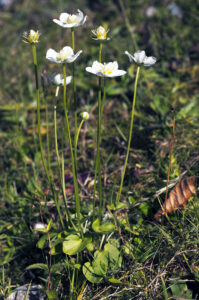
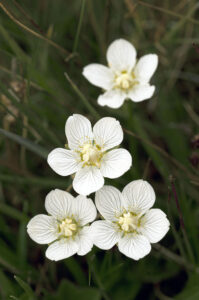
The generic name, derived from Ancient Greek helios (‘sun’) and anthemon (‘flower’), refers to the fact that most members of the genus grow in sunny places.
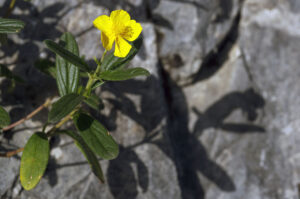
The inflorescence is mostly a one-sided, few-flowered raceme, flowers to 2 cm across, petals 5, lemon-yellow or golden-yellow, stamens numerous. Sepals lanceolate, very hairy, green, often with reddish-brown edge. The individual flower is short-lived, but throughout the summer the plant produces an abundance of them. They only open in sunshine, at temperatures above 20 degrees.
It is distributed in the major part of Europe, and also in Turkey and the Caucasus, growing in heaths, and on dry slopes and rocks. Several subspecies are found in the Alps, some of which grow up to altitudes around 2,400 m.
The specific name is derived from the Latin nummulus (‘little coin’), referring to the flowers, which shine like golden coins in the sunshine.
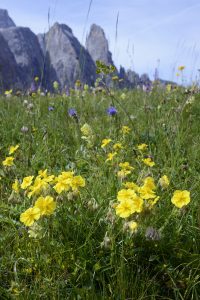
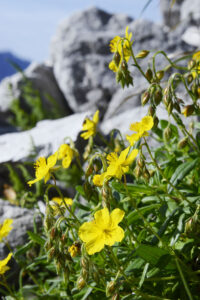
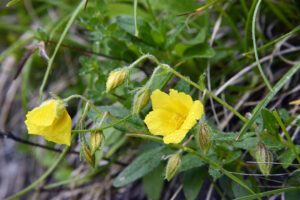
The generic name is derived from Ancient Greek kolkhikon, the classical name of C. speciosum. The common names both refer to the ‘naked’ (leafless) flowers that appear in late summer or autumn, long before the leaves, which emerge in spring. Most species of the quite similar, but unrelated genus Crocus bloom in spring, although a few species flower in the autumn. In this genus, leaves and flowers appear simultaneously.
The whole plant contains the alkaloid colchicine, with the highest concentrations in the leaves, which deters herbivores from eating them.
It is widespread in the Iberian Peninsula, northwards to the Pyrenees, where it may be found up to elevations around 2,600 m. It is abundant in pasture lands, flourishing along roads and trails, often in dry and stony places.
The highest density is found in highly disturbed areas with large populations of a species of vole, Microtus duodecimcostatus. Research suggests a symbiotic relationship between the two: the voles feed on the much less toxic rhizomes, which activates asexual reproduction in the plant. This mechanism is not observed in undisturbed pastures. (Source: D. Gómez et al. 2003. Seasonal and spatial variations of alkaloids in Merendera montana in relation to chemical defense and phenology. J. Chemical Ecol. 29 (5): 1117-1126)
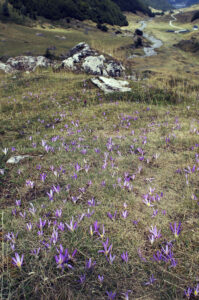
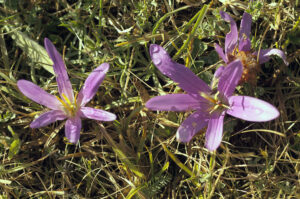
Many members of this family are dealt with in depth on the page Plants: Morning-glories and bindweeds.
The thin stems, mostly yellow or red, twine around other plants, often completely enveloping them. A dodder seed starts its life like most other seeds by sending roots into the soil, from which grow stems, whose leaves are reduced to scales. When a stem gets into contact with a suitable plant, it wraps itself around it, inserting sucking organs, called haustoria, into the plant, through which the dodder obtains water and nutrients. Its root in the ground then dies.
Their strange appearance taken into consideration, it is hardly surprising that dodders have many folk names, including strangleweed, scaldweed, beggarweed, lady’s laces, wizard’s net, devil’s guts, devil’s hair, devil’s ringlet, goldthread, hailweed, hairweed, hellbine, pull-down, angel’s hair, and witch’s hair.
The generic name is derived from the Arabic name of dodders, kusuta, or kuskut, which, in the form Cuscuta, was applied to them by Rufinus, an Italian monk and botanist, who was the author of De virtutibus herbarum, completed c. 1287, which listed nearly a thousand medicinal materials, mostly plants.
Several species of dodder are presented on the page Plants: Parasitic plants.
Greater dodder is very widely distributed, found in temperate areas of Europe and Asia, eastwards to south-eastern Siberia and Japan, southwards to Morocco, Iran, the Himalaya, and China. It is occasionally encountered in North and South America.
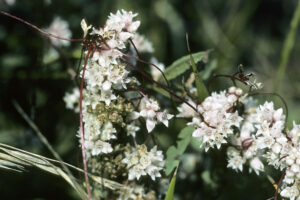
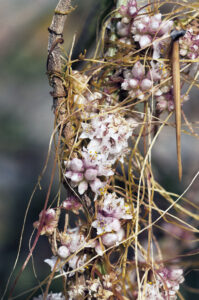
The generic name is Latin, meaning ‘horn’. It was the classical name of Cornelian dogwood (C. mas), whose wood is so dense that it will sink in water. The prefix dog may imply that the fruits of common dogwood (below) are of little value, due to their bitter taste. Alternatively, it may refer to the former usage of dogwood shoots, which were sharpened and used by farmers as cattle prods, called dags. Skewers were also made from the tough and durable wood.
This plant is partial to sunny places, although it can tolerate some shade. Towards the southern limit of its distribution, it is restricted to mountains.
It is native to the major part of Europe, from Ireland, Scotland, and southern Norway southwards to Spain, southern Italy and Greece, eastwards to western Russia, Ukraine, Turkey, the Caucasus, and the Alborz Mountains of northern Iran. Elsewhere, it is widely cultivated as an ornamental due to its reddish stems, which are quite showy, when the leaves have been shed.
In 1991, the well-preserved body of a Stone Age hunter was discovered in a glacier in the Alps. Ötzi the Iceman, as he was dubbed, died about 5,300 years ago, presumably caught in a snowstorm. His arrow shafts were made from wood of dogwood and viburnum (Adoxaceae). (Source: K. Spindler 1994. The Man in the Ice)
In former days, oil from the fruits was used as lamp fuel. Medicinally, they were utilized as an emetic, whereas the astringent bark was used as a febrifuge.
The specific name is Latin, meaning ‘blood-red’, presumably alluding to the red autumn foliage of this species.
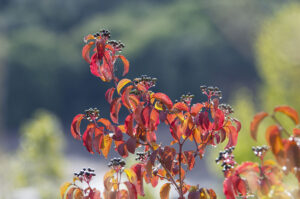
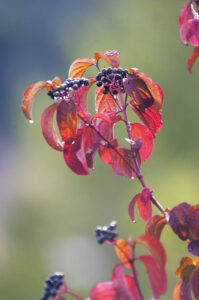
The generic name is composed of Ancient Greek petros (‘rock’) and the genus name Sedum (‘stonecrop’), thus ‘stonecrops growing on rocks’.
It has two kinds of stem. Creeping ones are flowerless, with dense masses of blue-green or dark green leaves, resembling foliage of the cypress spurge (Euphorbia cyparissias) (see below). They are opposite, fleshy, hairless, linear, cylindric, curved, sharp-pointed, about 1 cm long and 1 mm broad, stalkless above. Flowering stems are ascending, to 30 cm long, with terminal clusters of golden-yellow flowers, to 2 cm across, petals usually 7, occasionally 5 or 9, strap-shaped, pointed, to 7 mm long.
This is a popular ornamental plant, cultivated in many countries around the world. The leaves are occasionally used in salads, with a slightly astringent taste.
The specific name is Latin, meaning ‘growing among rocks’.
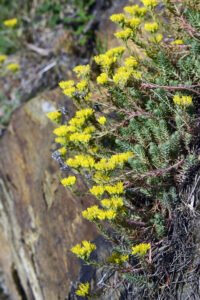
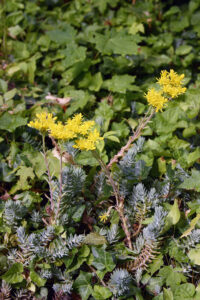
The generic name is derived from Ancient Greek rhodon (‘rose’) and the Latin iola, a diminutive suffix, thus ‘little rose’, alluding to the fragrance of the root.
It is very widely distributed, found in the major part of Europe, eastwards across Siberia to the Pacific coast, southwards to Xinjiang, northern China, Korea, and Japan, in Alaska, Greenland, and north-eastern Canada and the United States, as far south as North Carolina. In the southern parts of the distribution area, it is restricted to mountains.
This plant has been used in traditional medicine for at least 2,000 years, first mentioned by Greek physician, pharmacologist, and botanist Pedanius Dioscorides (died 90 A.D.), who was the author of De Materia Medica (5 volumes dealing with herbal medicine).
In the West, it was utilized for treatment of anxiety and depression, in Chinese herbal medicine to increase the blood circulation in cardiovascular conditions or menstrual irregularities, and to treat acute pain caused by blood stagnation. In some places, it is threatened due to overcollecting.
The specific name is Latin, meaning ‘pertaining to roses’, presumably like the generic name alluding to the fragrance of the root.
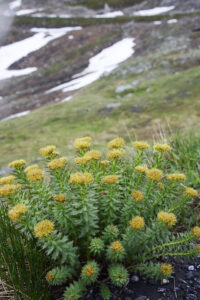
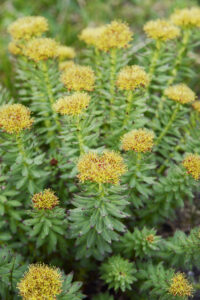
Most species are prostrate plants, which grow in dry areas, for instance in sand, among scree, or on rocks.
The generic name is the classical Latin term for houseleek (Sempervivum, below). Why it was applied to these plants is not clear.
It is a tufted perennial, forming mat-like, dense growths of green, red, or reddish-brown leaves, alternate, succulent and nearly cylindric, to 2 cm long, with a blunt, rounded tip. Inflorescences are dense, terminal, branched clusters of star-shaped flowers, borne on erect stems to 10 cm tall. Petals white or pale pink with a red central nerve, pointed or blunt, to 4 mm long.
The specific name is Latin, meaning ‘white’, alluding to the flower colour.
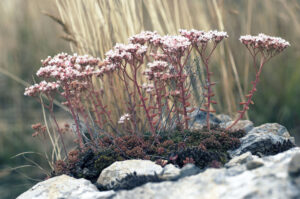
It grows on acid soils, on rocks, stone walls, and along stony roads and streamsides, distributed in northern and southern Europe, and from Turkey eastwards to the Caucasus and northern Iran.
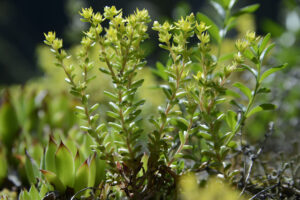
In the Alps, it may be encountered up to elevations around 2,850 m. It mainly grows on dry, stony, slightly acid soils, in sunny locations. It is also a colonizer of ruins and old walls.
It forms dense mats of shrubby, creeping stems with very numerous bluish-green or greyish-green, egg-shaped, fleshy leaves, to 7 mm long, flat above and strongly arched below. They are covered in tiny hairs in some subspecies of the plant, whereas they are smooth in others. The star-shaped flowers are in small clusters at the end of stems, to 15 cm high, petals pointed, white or pale pink above, reddish-purple below with a darker central nerve.
The specific name is derived from Ancient Greek dasys (‘thick’) and phyllon (‘leaf’), referring to the thick leaves.
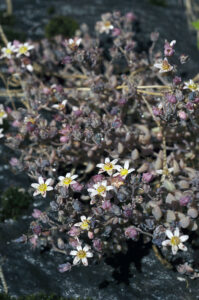
The generic name is Latin, meaning ‘forever alive’, derived from semper (‘always’) and vivum (‘something alive’), referring to the fleshy, evergreen leaves of these plants. The leek part of the common name stems from Anglo-Saxon leac, meaning ‘plant’, thus ‘house plant’, referring to an old habit of planting common houseleek (S. tectorum, see below) on house roofs. The folk name hen and chicks alludes to the numerous runners that spread out from the mother plant.
It is native to the Pyrenees, the Alps, the Apennines, the Carpathians, and Corsica, found from the lower valleys up to elevations around 2,900 m. It grows on rocks, among gravel, and in grassy areas.
The popular name, as well as the specific name, derived from Ancient Greek arakhne (‘spider’), allude to the long hairs that usually grow along the margin of the leaves of the central rosettes, not unlike a spider’s web.
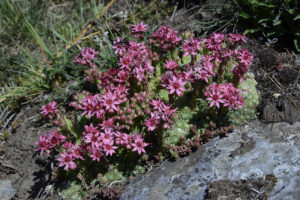
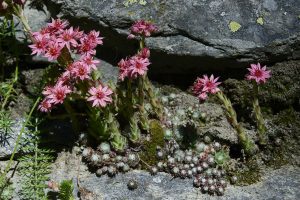
The specific name is Latin, meaning ‘with large flowers’.
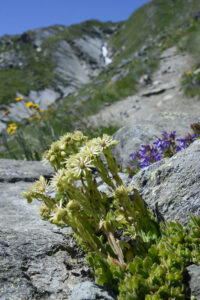
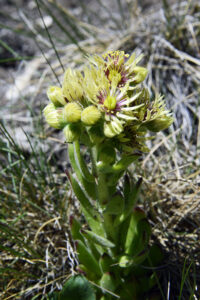
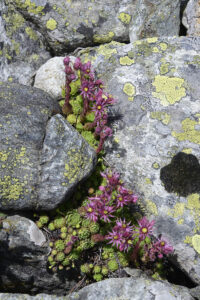

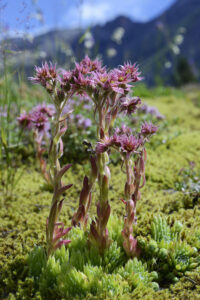
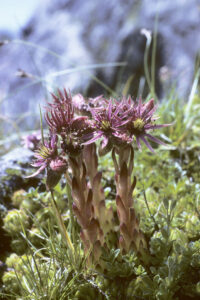
The native distribution area includes the Pyrenees, the French Massif Central, the Alps, and the Apennines, growing up to elevations around 2,800 m. It is widely cultivated elsewhere.
The specific name is Latin, meaning ‘of roofs’, alluding to the widespread planting of this species on straw roofs as a protection against fire, as the large, fleshy leaves certainly do not easily catch fire.
In the book Capitulare de villis it is mentioned that Louis, later Emperor Louis the Pious (778-840), in 812 ordered the tenants on the Crown Lands to plant houseleek on the roofs of houses and huts as a protection against fire.
Formerly, common houseleek was much utilized as a medicinal plant. It was also believed that if you planted it on the roof of a pigsty, it would protect the pigs against disease.
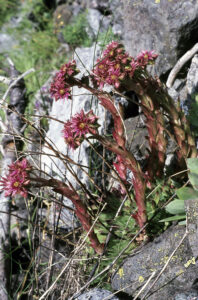
The generic name is derived from Ancient Greek erion (‘wool’) and phoros (‘bearing’), alluding to the flowerheads being covered in cottony hairs when in seed.
Following his expedition to Lapland in 1732, Swedish naturalist Carl Linnaeus (1707-1778) published the botanical records in a work titled Flora Lapponica (1737). Here he mentions that the Samis used the seedheads of cotton-grass as stuffing in pillows.
In a work titled Flora Silesiaca, German botanist Heinrich Gottfried von Mattuschka (1734-1779) praises cotton-grass as stuffing in gloves, pillows, and furniture, and its usage for wicks, paper, hats, and all kinds of cloth, to be spun singly or mixed with wool or silk.
This species is found in subarctic and temperate areas of Europe, Asia, and North America, southwards to the Pyrenees, the Balkans, Tibet, northern China, Korea, and the Rocky Mountains. It has a scattered occurrence in the Alps, growing from the lowlands up to altitudes of at least 1,750 m.
The specific name is Latin, meaning ‘slender’.
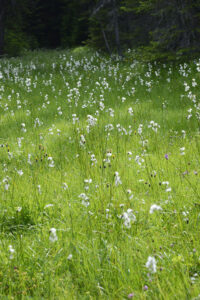
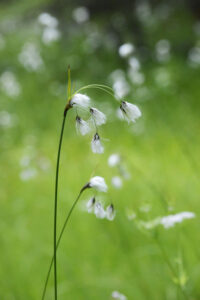
In the northern parts of its range, it grows down to sea level, but in the southern parts it is restricted to mountains. In the Alps, it grows at altitudes between 1,500 and 2,900 m, but in North America and elsewhere it has been encountered at elevations over 4,000 m.
It is restricted to humid habitats like marshes, wet meadows, lake- and streamsides, and wet gravel, spreading via underground stems and often forming huge growths. The thin stems may grow to 70 cm tall, but are usually much shorter. Lower leaves are up to 12 cm long, whereas upper leaves are reduced to black-tipped sheaths. The inflorescence is a solitary, terminal flowerhead, covered in a dense layer of snow-white, cottony hairs when in seed.
The specific name was given in honour of Swiss botanist and plant collector Johannes Gaspar Scheuchzer (1684-1738), who specialized in studying grasses.
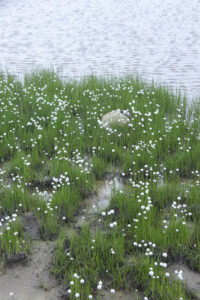
The leaves are all basal, very narrow, forming a tussock, flowering stems to 60 cm tall, with a single inflated leaf-sheath, without blade, hence the specific name, derived from the Latin vagina (‘sheath’). Like with other species of the genus, the inflorescence is very dense, forming a tuft when in seed, which gave rise to the common name.
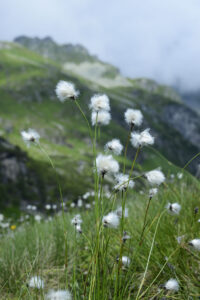
The generic name is derived from Ancient Greek kystis (‘bladder’) and pteris (‘fern’), referring to the inflated indusium, a membrane that covers and protects the developing sporangia on the underside of the leaves.
It has a scattered occurrence, found in lower montane areas of Scandinavia, the Pyrenees, the Alps, the Balkans, Ukraine, Turkey, and the Caucasus. In the Alps, it may be encountered up to altitudes around 2,400 m, restricted to limestone and other calcareous soils in damp environments.
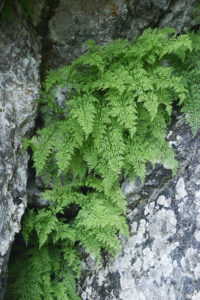
It is distributed almost worldwide, but is absent in hot, tropical climates. It is common and widespread in Europe, growing on damp limestone cliffs and old walls, and in stony areas in forests. In the Alps, it may be encountered up to elevations around 2,400 m.
Formerly, it was utilized medicinally for various disorders.
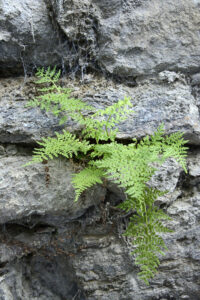
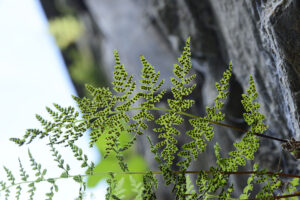
The generic name is derived from Ancient Greek gymnos (‘naked’) and karpos (‘fruit’), alluding to the naked sporangia clusters.
It has small, delicate leaves up to 40 cm long, twice pinnate, with rounded lobes on the leaflets. The leafstalk is black. The naked sporangies are on the underside of the leaves.
The specific name is derived from Ancient Greek drys (‘oak’) and pteris (‘fern’), presumably referring to the leaves, which resemble those of members of the genus Dryopteris (wood ferns).
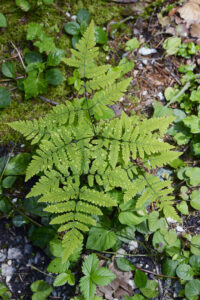
The generic name is derived from Ancient Greek polys (‘many’) and stikhos (‘line’ or ‘row’), undoubtedly referring to the arrangement of the leaflets. The common name alludes to the shield-like shape of the membrane, covering the sporangia clusters.
This species is widespread, found in the major part of Europe, North Africa, and the Middle East, eastwards to Xinjiang. It grows in forests and rocky areas on humus-rich soils, on calcareous as well as acid substrates. In the Alps, it may be found up to elevations of at least 2,000 m.
Strictly speaking, the specific name means ‘stinging’ in Latin, but in this connection it may be translated as ‘bristly’, alluding to the bristly margins of the leaflets.

It is native to much of the Northern Hemisphere, southwards to the Mexican border, North Africa, Pakistan, and Japan, growing in shady forests and among rocks. In the Alps, it may be encountered up to elevations around 2,700 m.
The specific name is derived from Ancient Greek lonkhe (‘lance’ or ‘spear’), referring to the pointed leaflets.
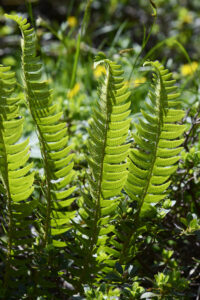
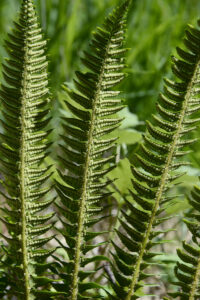
The generic name is the classical Latin word for heath.
It is an evergreen dwarf shrub, growing to a height of about 90 cm, leaves linear, pointed, growing in whorls up the stems, dark green above, paler below, to 1 cm long and 2 mm wide, with down-rolled margins. The inflorescence is a dense raceme, to 17 cm long, the individual flowers bell- or urn-shaped, to 8 mm long, petals whitish-pink, pink, or lilac, the dark purple anthers and white filaments protruding. It thrives on sandy or stony, acid soils that are not too dry.
The specific name is Latin, meaning ‘wandering’. It is not clear what it refers to. The common name alludes to the fact that the only population of this species in England is found in Cornwall.
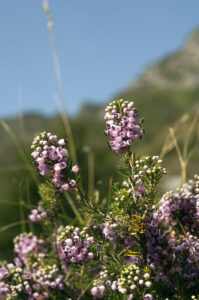
The generic name was applied by Swedish naturalist Carl Linnaeus (1707-1778) in honour of his pupil and friend Pehr Kalm (1716-1779), a Finnish explorer and naturalist, who collected a member of the genus in eastern North America.
It is a dwarf shrub, which rarely exceeds a height of 10 cm, forming carpet-like growths of creeping branches, densely covered in leaves. Occasionally, it may grow to 40 cm tall. The alternate leaves are short-stalked, leathery, entire, to 8 mm long and 2.5 mm wide, pale green, often with tiny white dots. The short-stalked flowers are solitary or few together, terminal, petals 5, pink to dark red, to 9 mm long, fused at the base, lobes triangular, spreading.
The specific name is Latin, meaning ‘prostrate’.
The obsolete generic name was given in honour of French physician and botanist Jean-Louis-Auguste Loiseleur-Deslongchamps (1774-1849).
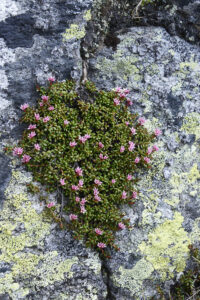
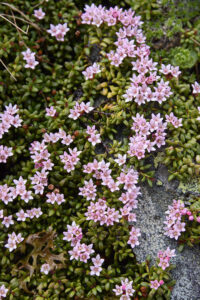
The leaves are basal or very low on the stem, short-stalked, ovate, elliptic, or obovate, to 3 cm across, in diameter, with small teeth. The single, nodding, fragrant flower, to 2.5 cm across, is terminal on a stem to 10 cm, sometimes up to 17 cm tall, petals 5, white, spreading, with wavy margin. The style is large, green, anthers are yellow.
The generic name is derived from Ancient Greek monos (‘single’) and hesis (‘delight’), alluding to the attractive, solitary flower. The specific name is Latin, meaning ‘one-flowered’.
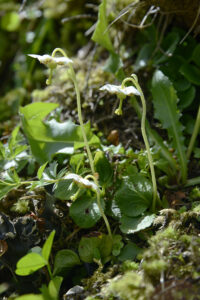
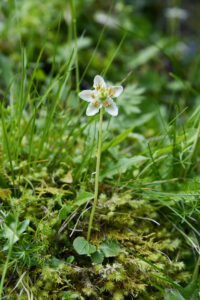
The generic name is derived from the Latin pirum (‘pear’) and the diminutive suffix ola, thus ‘little pear’, alluding to the shape of the leaves.
This plant grows on acid soils in deciduous and coniferous forests, and also in birch bogs. It is distributed in subarctic and temperate areas of the Northern Hemisphere, southwards to the Mediterranean, China, and Japan, in America southwards almost to the Mexican border. In the Alps, it occurs up to elevations of at least 2,300 m.
The specific name is Latin, meaning ‘smaller’. i.e. compared to other members of the genus.
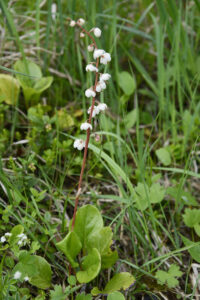
It very much resembles the lesser wintergreen (above), but is a larger plant, stem up to 40 cm tall, sometimes with as many as 30 flowers that are larger, with more spreading petals.
The specific name is Latin, meaning ‘with round leaves’.
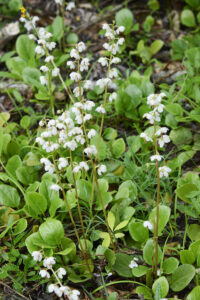
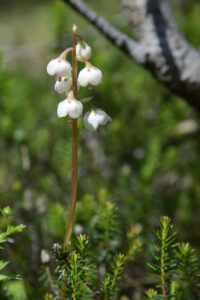
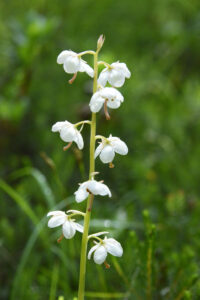
Pictures, depicting rhododendrons from many parts of the world, are presented on the page Plants: Rhododendron.
In Ancient Greek, rhododendron means ‘rose tree’. Until the 1600s, this name was used for oleander (Nerium oleander), which is described on the page Plants: Flora in Turkey. In 1753, it was transferred to rhododendrons by Swedish naturalist Carl Linnaeus (1707-1778).
The German names Alpenrose (‘rose of the Alps’) and Bergrose (‘mountain rose’) were already used for these plants in the 1500s by Swiss physician and naturalist Conrad Gessner (see Doronicum above), although they are not at all related to roses. In those days, the term rose was applied to many plants with attractive flowers.
It is a heavily branched, evergreen shrub, to 1.3 m tall, with stout branches, which may be up to 2 cm in diameter. Research has found that individuals with such branches may be almost 100 years old. Leaves are alternate, often clustered at the end of branches, leathery, to 4 cm long and 1 cm wide, lanceolate to narrow-elliptic, margin serrated, tip pointed, dark green and glossy above, young leaves yellowish below, older leaves with a felt-like layer of rusty-brown hairs. Inflorescences are terminal clusters of dark pink to red flowers, each to 8 mm long, petals 5, fused to form a bell-shaped corolla with ovate lobes, tip rounded.
In folk medicine, the plant has been used for treatment of rheumatism and kidney stones.
The specific name is Latin, meaning ‘rust-coloured’. Like the common name it refers to the rusty-coloured layer of hairs covering the underside of the leaves.
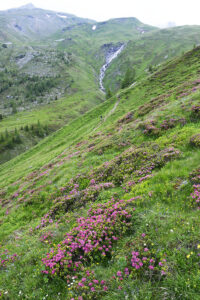
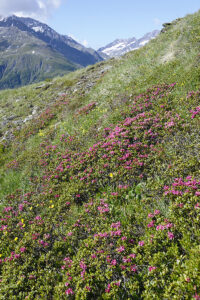
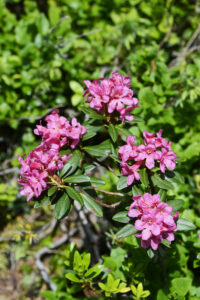
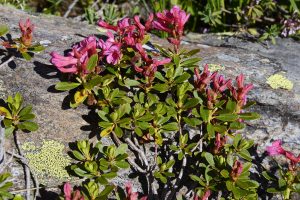
It closely resembles rusty-leaved alpenrose, but is easily identified by the ciliate leaves, and the flowers are pale pink. Where the distribution area of the two species occasionally overlaps, hybrids between them are frequent.
Like the previous species, this plant was used in traditional medicine to treat rheumatism and kidney stones.
The specific name is Latin, meaning ‘hairy’, alluding to the leaf margin.
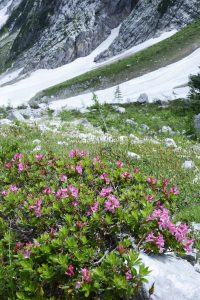
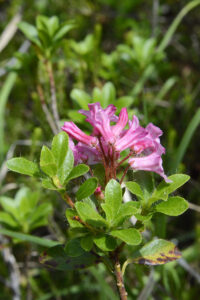
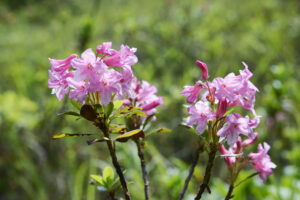
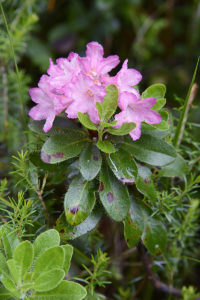
The generic name is derived from Ancient Greek rhodon (‘rose”) and thamnos (‘bush’). The common name is adapted from the German Alpenrose (‘rose of the Alps’).
It is an evergreen dwarf shrub with ascending branches, to 30 cm long. Leaves are alternate, clustered at the end of branches, leathery, to 1.5 cm long, margin toothed and bristled. Flowers are terminal, in groups up to 4, stalked, to 3 cm across, petals pale pink with red streaks near the throat, only fused at the base, style white with a carmine tip, filaments white, anthers purplish-black.
The specific name is composed of Ancient Greek khamai (‘on the ground’, i.e. ‘low’), and the genus name Cistus (rockroses), a group of plants in the family Cistaceae. The name alludes to the flowers, which superficially resemble those of rockroses.
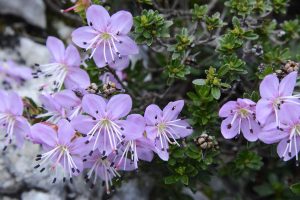
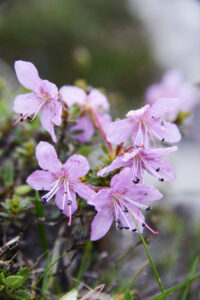
The floral structure of these plants, the cyathium, is cup-like, consisting of fused bracts with nectary glands along the margin. These bracts are surrounding a ring of male flowers, each with one stamen, and a single female flower is in the centre. Superficially, this arrangement resembles a single flower. The fruit is a capsule, with 3 valves.
King Juba II (c. 50 B.C. – 19 A.D.) of Numidia (in present-day Algeria and Tunisia) had an interest in plants and often described them, including a thorny, succulent plant from the Atlas Mountains in Morocco, whose latex was a powerful laxative. He named this plant Euphorbea in honour of his Greek chief physician, Euphorbus. In 1753, Swedish naturalist Carl Linnaeus (1707-1778) adopted this name, in the form Euphorbia, for the entire genus.
Its natural habitats include grasslands, dunes, and gravel areas along lakes, rivers, and beaches. It also thrives in open, disturbed areas, such as roadsides and pastures.
It contains a milky sap, which is toxic, having a strongly irritating effect on the skin, often forming painful blisters.
The specific and popular names allude to the leaves, which resemble the foliage of certain species of cypress trees (Cupressus).
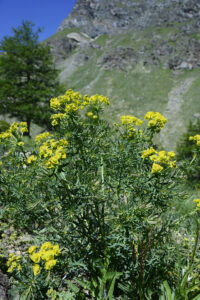
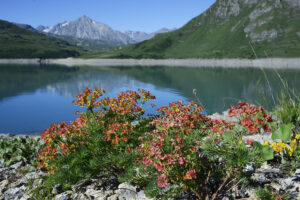
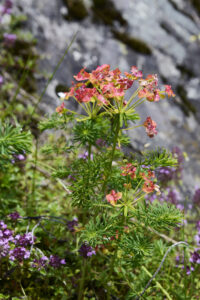
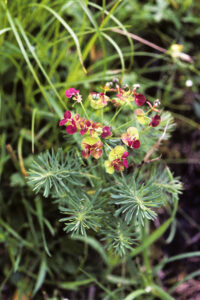
The leaves are pinnate in most species, but may be trifoliate or palmate. The fruit, the legume, or pod, is usually much longer than broad, splitting open along two seams.
According to the latest revision, this family now includes 6 subfamilies. The species mentioned below all belong to the subfamily Faboideae (Papilionoideae). Flowers of this subfamily have 5 petals, forming a unique structure. The upper petal, called the standard, is large and often reflexed, covering and protecting stamens and pistil. The two lateral petals, called the wings, are of equal size, surrounding the two bottom petals, which are free at the base, but fused at the tip, forming what is called the keel, as it resembles the keel of a boat. They enclose stamens and pistil.
The generic name is derived from Ancient Greek anthyllio, diminutive of anthos (‘flower’).
This perennial, with ascending or upright stems, varies from dwarf plants 5 cm tall to shrubby herbs that may reach a height of 40 cm. Basal leaves often have only a terminal elliptic leaflet, to 8 cm long, lateral leaflets 1-4 pairs, much reduced in size, or often missing. Stem leaves have 2-7 pairs of leaflets, ovate, elliptic, or lanceolate, lateral ones to 2.5 cm long and 8 mm wide, terminal leaflet to 6 cm long and 2 cm wide, rounded.
The inflorescence is a compact flowerhead with numerous flowers, to 1.9 cm long, golden-yellow in most subspecies, occasionally whitish, orange, or red. The white-haired calyx is inflated, with uneven teeth. The pod is ovoid, hairy, dark, one-seeded.
It is distributed from the entire Europe eastwards to the Ural Mountains, southwards to northern Africa and Iran, with an isolated occurrence in Ethiopian mountains. It grows in dry grasslands and coastal dunes, along roads and embankments, and in other disturbed areas, preferably on calcareous soils, from the lowland up to alpine regions. In the Alps, it has been encountered up to elevations around 3,000 m.
It was first described in 1561 as Vulneraria rustica (‘rural wound plant’) by Swiss physician and naturalist Conrad Gessner (see Doronicum above), alluding to its usage for healing wounds. It was also used for cough. The first part of the name is derived from the Latin vulnus (‘wound’).
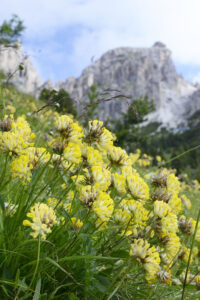
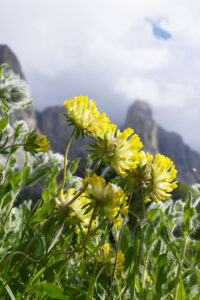
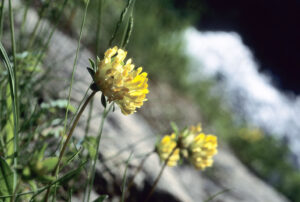
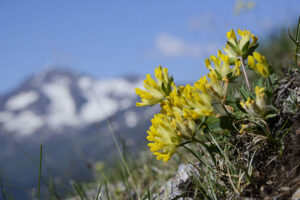
These plants are very variable, from soft-haired herbs to spiny shrublets. The leaves of the vast majority are pinnate, with numerous leaflets. The calyx is tubular, with 5 short teeth or lobes, often of unequal length. The keel of the flower is blunt-tipped, as opposed to members of the genus Oxytropis, which are very similar, but whose keel has a beaked tip. The pod is often longitudinally divided into 2 chambers.
In Ancient Greece, astragalos was the term applied to one of the bones in the ankle joint, called the ball bone. Dice were made from the ball bones of certain animals. However, astragalos was also the name for a member of the pea family, Lathyrus niger. A possible explanation is that to the Greeks, the seeds of this plant resembled the dice made from the ball bones.
The name vetch stems from Anglo-Norman French veche, a corruption of the Latin vicia. Milk-vetches are quite similar to true vetches of the genus Vicia. The prefix milk refers to an old belief that cows fed with milk-vetch would yield more milk.
Stem erect, usually unbranched, smooth or slightly hairy, to 40 cm tall, leaves pinnate, to 15 cm long, with 3-7 pairs of ovate or elliptical leaflets, to 2.5 cm long, pointed, stipules (small leaves at the base of the leaf) to 2 cm long and 1 cm wide. Inflorescences to 5 cm long, with 5-20 nodding flowers, to 1.5 cm long, calyx yellowish-green or reddish, to 5 mm long, toothed, corolla yellowish-white. Pods initially with a dense cover of black and white hairs, later smooth.
The specific name is Latin, meaning ‘growing in cold regions’.
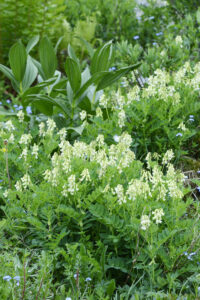
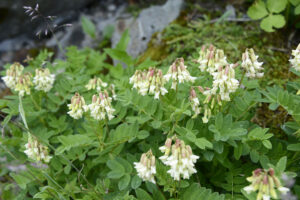
This species is native from the western Alps eastwards to western Siberia and the Altai Mountains, southwards to the Mediterranean, the Caucasus, and northern Iran. It was originally a steppe plant, which has adapted to grassy areas in mountains.
The specific name alludes to the similarity of the flowers to those of the genus Onobrychis (below).
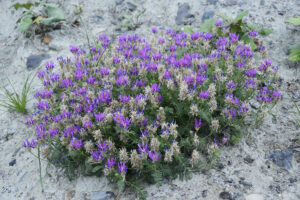
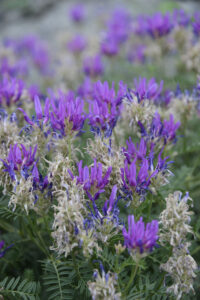
The generic name is derived from Ancient Greek hedysaron, a word used for an unknown plant by Greek scholar and botanist Theophrastos (c. 371-287 B.C.), and later by Greek physician, pharmacologist, and botanist Pedanius Dioscorides (died 90 A.D.), who was the author of De Materia Medica (5 volumes dealing with herbal medicine).
The first part of the name is derived from Ancient Greek hedys (‘sweet’), alluding to the root, which is edible, raw or cooked, with a slightly sweet, liquorice-like taste. The root of H. boreale was formerly much relished by North American native tribes.
Stems are erect or ascending, angular, to 60 cm tall, leaves pinnate, to 15 cm long, with 9-21 lanceolate leaflets, to 3 cm long, stipules (small leaves at the base of the leaf) membranous, brown, fused to above the middle. Inflorescences are one-sided racemes with up to 50 purplish-violet or reddish-violet flowers, corolla to 2 cm long. The pods do not open at maturity, but disintegrate into one-seeded units. The root is edible, raw or cooked.
The specific name is Latin, meaning ‘resembling Hedysarum‘, which seems odd, as it is a species of Hedysarum. The explanation is that when Swedish naturalist Carl Linnaeus (1707-1778) named the plant in 1753, he called it Astragalus hedysaroides (‘the milk-vetch that resembles Hedysarum’). It was since transferred to the genus Hedysarum.
An alternative common name of this plant is Alpine sainfoin, which is confusing, as the name sainfoin is usually reserved for members of the genus Onobrychis (below).
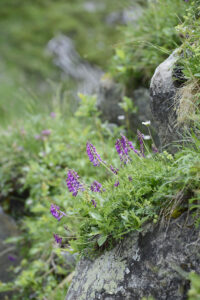
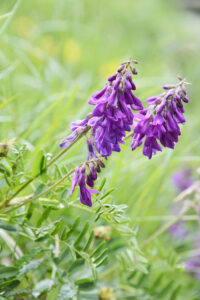
The generic name is the classical Latin name of these plants, of unknown origin. Alternative common names include golden rain tree and golden-chain tree, alluding to the numerous pendent, golden-yellow inflorescences.
It is distributed from the French Cévennes eastwards to the Balkans, found up to elevations around 2,000 m.
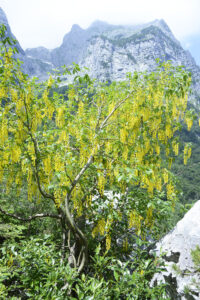
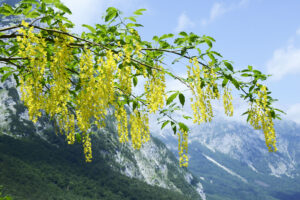
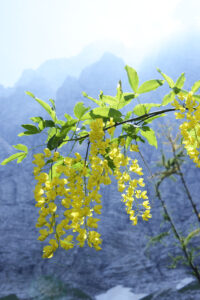
The generic name is a Latinized version of Ancient Greek lathyros, the classical name of the chickling pea (Lathyrus sativus).
It forms dense growths, stems erect, angular, quite stiff, more or less hairy, leafy, to 60 cm tall, leaves with 3-5 pairs of elliptic-lanceolate leaflets, sharply pointed. Stipules quite large, lanceolate. Inflorescence is a one-sided, stalked raceme, with 5-20 lemon-yellow flowers, to 2.5 cm long, which turn orange with age. The pod is oblong, brown, smooth, to 7 cm long.
The specific name is Latin, meaning ‘smooth’.
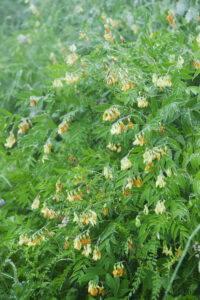
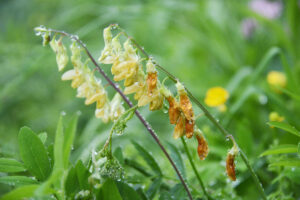
The generic name is derived from Ancient Greek onobrykhis, from onos (‘ass’) and brykho (‘to eat greedily’). Presumably, some Ancient Greek noticed asses greedily eating these plants. Through the ages, they have been much used as fodder, and one species, O. viciifolia, has become naturalized in numerous countries.
The popular name is derived from Old French sain foin (‘healthy hay’). In the 1500s, French scientist Olivier de Serres wrote: “The herb is called sain-foin in France, in Italy herba medica, in Provençe and the Languedoc luzerne. From the inordinate praise the plant has been given, for its medical virtues and for fattening the livestock that graze on it, comes the term sain.”
In most northern European languages, the name of the plant usually derives from esparceto, the Provençal term for the similar-looking and closely related sweetvetches (Hedysarum) (above).
It grows on calcareous soils, in meadows and pastures, and among rocks, at elevations between 1,300 and 2,600 m, from the French Alps eastwards to the Balkans, Turkey and the Caucasus, and thence southwards to Jordan.
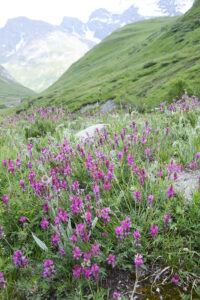
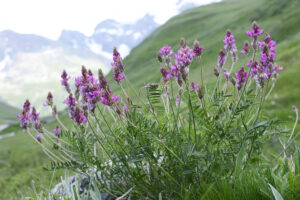
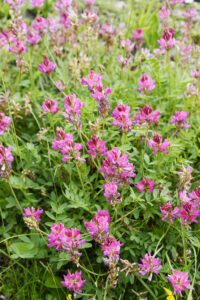
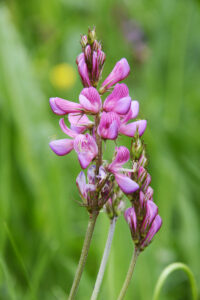
The generic name is derived from Ancient Greek oxys (‘sharp’) and tropis (‘keel’), referring to the beaked keel, as opposed to the blunt keel in the very similar flowers of the genus Astragalus (above).
The American term for these plants is locoweed, derived from Spanish loco (‘mad’ or ‘crazy’). Early settlers noticed that cattle and horses, which had eaten these plants, would stagger around, acting strangely.
A prostrate plant, growing to 15 cm tall, leaves basal, stalked, pinnate, to 20 cm long, with 10-15 pairs of elliptic or lanceolate leaflets, smooth or sparsely hairy, stipules lanceolate, larger than the leaflets. Inflorescences are dense spikes, to 6 cm long, borne on leafless stalks to 20 cm long, each with 5-15 whitish, pale yellow, purplish, or violet flowers, to 2 cm long. The pod is hairy, to 1.8 cm long and 8 mm wide.
In the Alps, it is regarded as a valuable fodder plant.
The specific name is Latin, meaning ‘growing in fields’ or ‘growing in plains’.
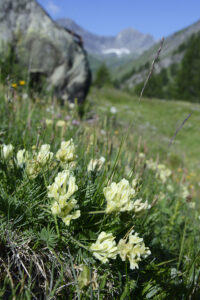
The generic name was the classical Latin word for clover, meaning ‘with 3 leaves’, referring to the trifoliate leaves of the genus. The pod is small, containing a single seed.
An erect, hairy plant, to 40 cm high, leaves trifoliate, leaflets narrow, oblong or lanceolate, to 8 cm long and 1 cm wide, hairy and with tiny teeth along the margin, veins prominent. Stipules awl-shaped, to 3 cm long. The spherical to egg-shaped inflorescences, to 2.5 cm long, are sessile, subtended by the uppermost leaves. Corolla pinkish-red or reddish-purple, rarely white or pink, to 1.2 cm long. The hairy calyx tube has 20 veins – a unique character for this species.
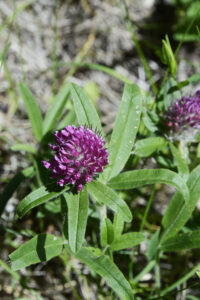
It grows on acid soils in the central and southern Alps, the Apennines, the French Massif Central, and the Pyrenees, at altitudes between 1,000 and 3,100 m. The eastern limit of the distribution area roughly follows a line from Arlberg, western Austria, southwards to Lake Garda.
It is an important fodder plant for livestock as well as wild herbivores, including chamois (Rupicapra rupicapra) and marmot (Marmota marmota).
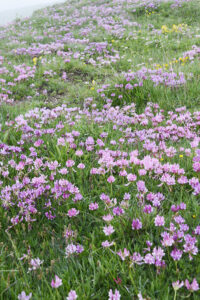
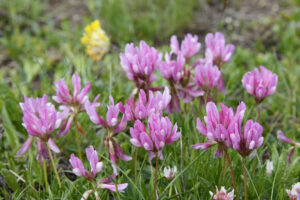
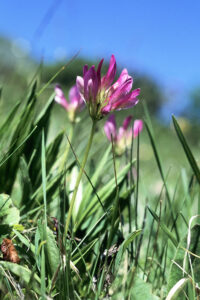
This species is widespread, found from Germany and Poland southwards to the Mediterranean, and thence eastwards to Ukraine, the Caucasus, Iraq, and Iran, occurring at elevations between 300 and 3,000 m. It thrives on moist, nutrient-rich soils, growing mainly in grasslands. It is one of the few alpine plants that benefit from the increased uasag of chemical fertilizers.
It is a valuable fodder plant, and formerly it was also used medicinally.
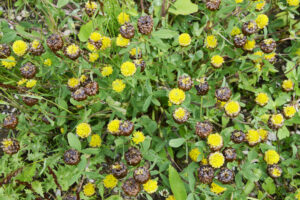
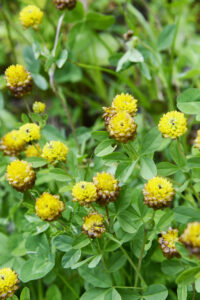
The stem is erect, woolly-haired, branched above, to 50 cm tall. Leaves alternate, long-stalked, trifoliate, leaflets elliptic or lanceolate, to 6 cm long and 2.5 cm wide, with finely toothed margin, underside hairy. Stipules ovate, pointed, whitish with brown streaks, lower part close to the stalk, forming a sheath. Flowerheads are terminal, on long, woolly-hairy stalks, elliptic or ovoid, to 2 cm across, flowers to 9 mm long, corolla white or yellowish-white, after flowering turning brownish.
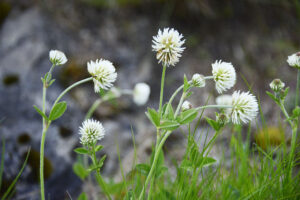
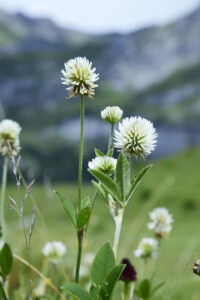
The generic name is the classical Latin word for vetch.
This plant is widespread in Eurasia, found in most of Europe, apart from the southernmost areas, eastwards to central Siberia. It is widespread in the Alps, growing in light forests and shrubberies, and along forest edges and roadsides, up to elevations around 2,300 m.
The specific name means ‘growing in woods’, derived from the Latin silva (‘forest’).
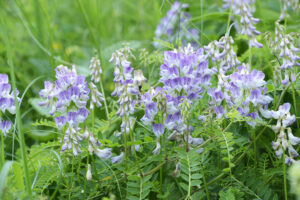
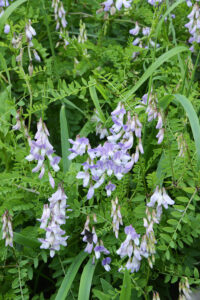
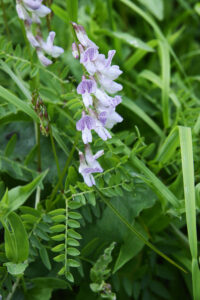
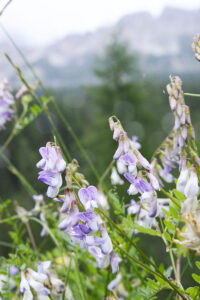
The flowers of most species are various shades of blue, others are purple, violet, mauve, yellow, white, or, rarely, red. The four or five petals are usually fused, being trumpet-, funnel-, or bell-shaped.
The generic name refers to King Gentius, who ruled in Ancient Illyria 181-168 B.C., and who allegedly discovered the medicinal value of the great yellow gentian (below).
Some Asian gentian species are presented on the page Plants: Himalayan flora 2.
It is native to central and southern Europe, from the Pyrenees, the Cevennes, and the Jura Mountains eastwards to the Czech Republic, Ukraine, and the Balkans, growing on acid soils. In the Alps and the Pyrenees, it may be encountered at altitudes between 800 and 3,000 m.
Formerly, children in the Alps would pick a flower and smash it between their hands to produce a loud bang.
The specific name is Latin, meaning ‘stemless’. It was the first gentian to be featured in the Curtis’s Botanical Magazine, in 1788.
Clusius’ gentian (below) is very similar and has a similar distribution, but is partial to limestone. It has narrower leaves and no green blotches inside the corolla.
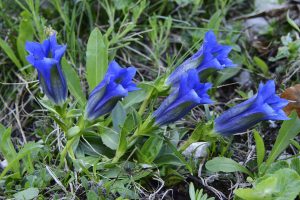
This species has a wide distribution in southern Europe, from the Spanish Sierra Nevada and the Pyrenees eastwards across the Alps to the Carpathians, found at altitudes between 1,800 and 4,200 m, making it the highest-occurring gentian species in the Alps.
Short-leaved gentian very much resembles round-leaved gentian (below), but differs by its green calyx, where only the ribs are dark, whereas the entire calyx is dark in round-leaved gentian.
The specific name is Ancient Greek, meaning ‘with short leaves’.
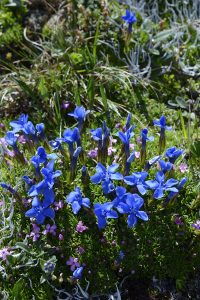
The specific name was given in memory of Charles de l’Écluse (1526-1609), also called Carolus Clusius, a Flemish physician and botanist, who was among the first to study the Alpine flora.
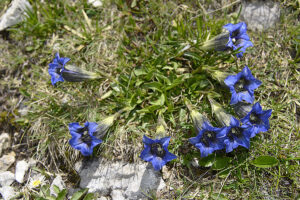
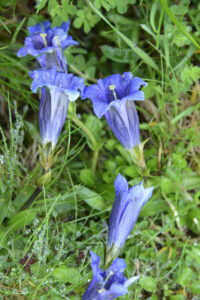
It is widespread in central and southern Europe, from Holland, France, and Spain eastwards to western Siberia, Turkey, and Iran, usually growing at altitudes between 200 and 1,600 m, occasionally higher. In Bulgaria, it has been found up to 2,900 m. It prefers dry, calcareous soils in shrubberies and grasslands.
The cross-wise arrangement of the leaves gave rise to the specific name, meaning ‘forming a cross’ in Latin. For this reason, the plant was much sought after during the Middle Ages, being a symbol of the crucified Jesus.
A Hungarian legend relates that when the plague broke out among the soldiers of King László (c. 1040-1095), he dreamed that an angel ordered him to shoot an arrow in the air. The herb, on which the arrow fell, would be able to heal the sick soldiers. As it turned out, the arrow fell on cross-leaved gentian, giving rise to the Hungarian name of this plant, Szent Lászlo Kiraly füre (‘Herb of King St. Ladislaus’).
Cross-leaved gentian is the host of an endangered butterfly, the mountain Alcon blue (Phengaris rebeli, formerly Maculinea rebeli), of the family Lycaenidae. Females lay their eggs on the leaves, and when the larvae emerge, they feed on the flowers and seeds. When they reach the fourth larval stage, they drop to the ground, where they emit a fragrance, which make ants of the species Myrmica schencki pick them up and bring them to their nest, in which they are reared by the ants. (Source: V. Oškinis 2012. Relationship between the butterfly Phengaris rebeli and its larval host plant Gentiana cruciata in a Lithuanian population. Ekologija 58 (3): 369-373)
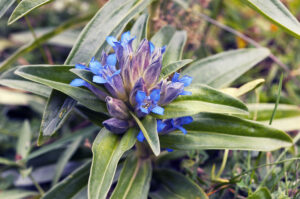
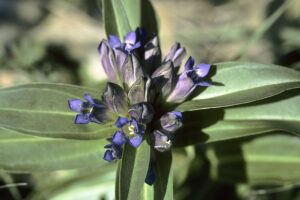
It is native to mountains of central and southern Europe, eastwards to Ukraine and western Turkey, growing in alpine and sub-alpine grasslands, mostly on calcareous soils. In the Alps, it may be encountered at elevations between 1,000 and 2,500 m.
It was formerly very common, and German botanist Otto Sendtner (1813-1859) relates how he in the 1830s was walking through veritable ‘woods’ of great yellow gentian in Bavaria.
The Greeks recommended the root for stomach and liver problems, and also for infections. In the Middle Ages, it was highly praised as a medicinal herb, used for various ailment, including infections, and as an antidote for poisons.
The root contains one of the most bitter-tasting substances known, and it is unrivalled as a stomachic tonic. A few drops of gentian tincture will stimulate the function of liver and pancreas, and also increase the appetite. Herbalists recommend it for a number of ailments, including jaundice, dyspepsia, flatulence, fever, and infections.
In certain parts of Europe, the fermented root is distilled, and the product is added to aperitifs and liqueurs. In the early 1900s, gentian liqueur was an immensely popular drink in the Alps. In 1928, in Switzerland alone, liqueur was produced from about 340 tons of gentian root.
A drinking song from the Inn Valley, Tyrol:
The specific name is Latin, meaning ‘yellow’, referring to the flower colour.
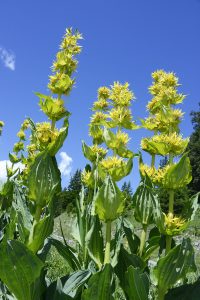
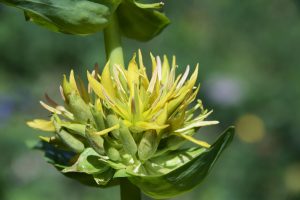
This species has a very wide distribution, from the Pyrenees across the Jura Mountains, the Alps, and the Carpathians, southwards to the Balkans and Turkey, and also in Scandinavia, Finland, north-western Russia, Iceland, Greenland, and north-eastern Canada. It thrives in stony and grassy areas, on calcareous as well as acid soils. In the Alps, it occurs at altitudes between 1,300 and 3,000 m.
The specific name is composed of the Latin niv, an obsolete form of nix (‘snow’), and the suffix alis, thus ‘living in snow’.
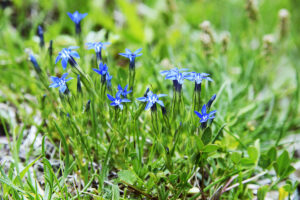
It is found in mountains from southern Spain and the Pyrenees eastwards across the Alps to the northern part of the Balkans, mostly on sunny, calcareous soils, at altitudes between 1,600 and 2,800 m.
The specific name is Latin, meaning ‘with small discs’, referring to the round leaves.
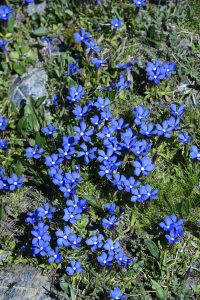
This plant is distributed in montane areas, from the Alps eastwards to the Carpathians and Ukraine, and on the Balkans. In the Alps, it grows at altitudes between 1,100 and 3,600 m, restricted to nutrient-poor, acid soils.
Like the great yellow gentian (above), its root has been utilized in folk medicine, and it was also added as a flavouring to alcoholic drinks.
The specific name is Latin, meaning ‘with small dots’, alluding to the flowers.
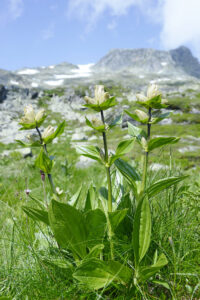
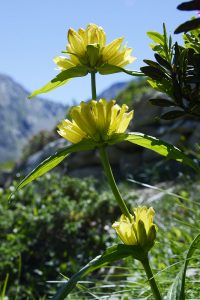
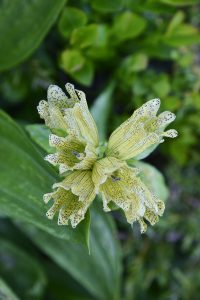
It has a disjunct distribution, found in the western Alps, eastwards to western Austria, in the northern Apennines, in southern Norway, and a small population in Härjedalen, Sweden, which was discovered as late as the beginning of the 1970s. It grows on acid soils, in the Alps found at altitudes between 1,100 and 2,800 m.
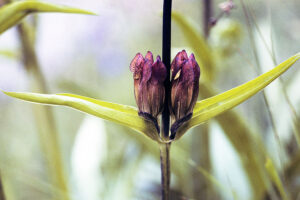
This species is distributed in the Alps and the Apennines, eastwards to Ukraine, and also on the Balkan Peninsula. It thrives on moist, calcareous soils.
The specific name is Latin, meaning ‘with small bags’, alluding to the inflated calyx.
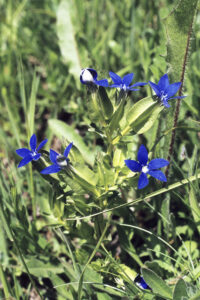
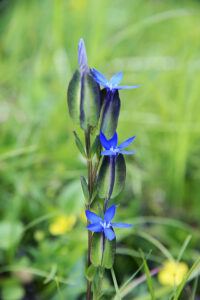
Usually, this plant is very low, but the erect, angular stems may occasionally grow up to 15 cm tall. Leaves are elliptic-lanceolate, the basal, rosette-forming leaves to 3 cm long, significantly larger than the stem leaves, which are opposite, arranged cross-wise up the stem to just below the calyx. Flowers are terminal, solitary, tubular, to 3 cm across, corolla dark blue, sometimes greenish on the outside, tube to 1.8 cm long, petal lobes broadly ovate, blunt ot slightly pointed, spreading, with a tiny, upright, bi-lobed, white-striped appendage between them.
In many places in the Alps, it was formerly believed that if you brought this plant into your house, lightening would most certainly strike it. It was also regarded as a flower of death: If you plucked it, someone would die. In Switzerland, the snow-white, tube-shaped style was called Tötli (‘small corpse’).
The specific name is Latin, meaning ‘spring’, indicating that it blooms early in spring. However, it also flowers in summer and autumn.
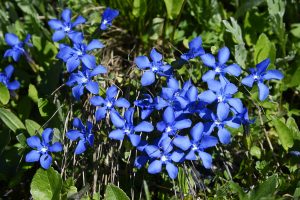
The generic name is composed of the genus name Gentiana, and Ancient Greek opsis (‘appearance’), thus ‘resembling Gentiana’.
The smooth, angular stem is erect or ascending, occasionally sparsely branched, to 30 cm tall. Stem leaves opposite, sessile, linear-lanceolate, pointed, to 5 cm long and 4 mm wide, arranged cross-wise up the stem. Flowers are usually solitary, terminal, corolla azure-blue to dull blue, to 4 cm across, petals fused into a tube, to 3.5 cm long, margin with fringes, ending in acute teeth. The brownish calyx is about half as long as the corolla tube, lobes linear-lanceolate, with sharp teeth.
The specific name is Latin, meaning ‘hairy’, referring to the fringed edge of the petals.
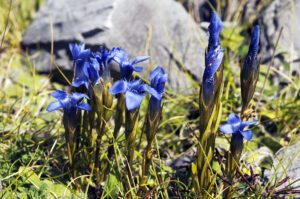
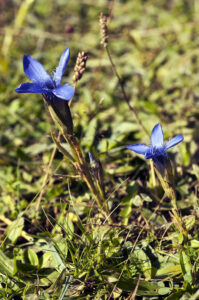
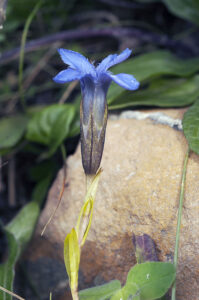
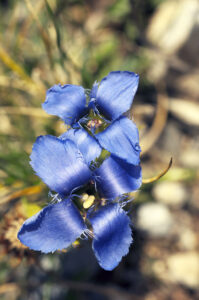
The generic name was applied in 1737 by Swedish naturalist Carl Linnaeus (1707-1778) in honour of Dutch painter and horticulturist Emanuel Sweerts, or Swert (1552-1612), who published Florilegium Amplissimum et Selectissimum (1612), a work depicting about 560 bulbs and flowers.
Many species of this genus are described on the page Plants: Himalayan flora 2.
The stem is erect, angular, to 60 cm tall, lower leaves ovate or spatulate, alternate, upper leaves lanceolate, opposite. The inflorescence is a loose, terminal panicle, sepals 4-5, green, slender, pointed. Corolla to 2.5 cm across, lobes 4-5, to 1.3 cm long, fused only at the base, violet-purple or dull blue with numerous darker streaks, style short and thick, stamens 5, purple, thick, topped by split anthers, at the base 10 dark glands, fringed with short white hairs.
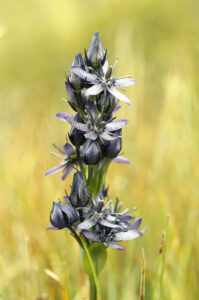
Stipules (leaf-like appendices at the base of leaves) are often distinct on these plants. After flowering, the style forms a long, straight or up-curved beak, which separates into 5 elastic spring-like coils, each containing a single seed that is expelled, usually when the style is touched.
The generic name is derived from Ancient Greek geranos (‘crane’), alluding to the fruit, whose shape resembles a crane’s bill.
In German, these plants are called Storchschnabel (‘stork’s-bill’). In 1542, German physician and botanist Leonhart Fuchs (see Allium schoenoprasum above) writes in his great herbal De Historia Stirpium Commentarii Insignes (‘Notable Commentaries on the History of Plants’): “Storckenschnäbel seind von den Griechen unnd Lateinischen genemt worden Gerania, darumb das sie am obersten teyl des stengels bringen ein köpfflin mit langen schnäbelin, nit anderst dann die Krench oder Storcken. Unnd daher kompt es, das zu unsern zeiten würdt Rostrum ciconiae geheyssen, das ist Storckenschnabel.” (‘By the Greeks and the Latinos, stork’s-bill is called Gerania, because at the top of the stem they bring forth a small head with long bills, no different from the bill of cranes or storks. And therefore, in our time, they are called Rostrum ciconiae, i.e. stork’s-bill.’)
In English, the name stork’s-bill refers to members of the genus Erodium, likewise of the crane’s-bill family.
This plant mostly grows in shady places, along forest edges and in shrubberies. It is native to southern, central, and eastern Europe, from Spain and France eastwards to the Balkan Peninsula and Ukraine, northwards to Poland and Belarus. It is widely cultivated and has become naturalized northwards to the British Isles, Sweden, and Finland. In the Alps, it is restricted to the lower parts.
The specific name is Latin, meaning ‘brownish’, alluding to the flower colour.
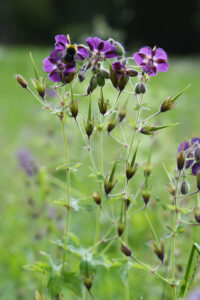
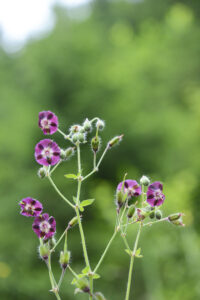
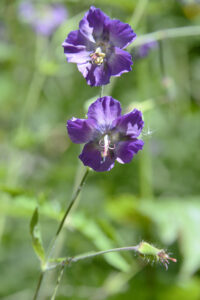
This plant grows in a variety of habitats, including open forests, meadows, grazing grounds, and wastelands. It is native to mountains of central and southern Europe and North Africa, eastwards to Ukraine, the Caucasus, and northern Iran. In the Alps, it has been found up to an elevation of 1,730 m.
It is widely cultivated and has become naturalized in numerous countries, northwards to Scandinavia, Finland, and European Russia, and also in north-eastern North America and Australia.
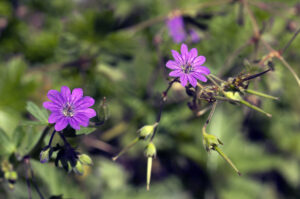
The stem is much-branched, hairy or smooth, green or red, to 50 cm tall. Leaves are palmate, long-stalked, deeply dissected, to 4 cm long and 7.5 cm wide, green or red. The small flowers, to 1.5 cm across, are terminal, usually in pairs, petals pink, to 1.4 cm long.
When touched, the entire plant exudes a strong, unpleasant smell, hence the popular name stinking Bob. This smell is due to the presence of an essential oil.
In former days, this species was known as Saint Robert’s herb, like the specific name referring to French abbot and herbalist Robert de Molesme (c. 1028-1111), one of the founders of the Cistercian Order. He used it to cure people, who were suffering from various diseases, including diarrhea, liver and gall bladder problems, toothache, and wounds. American native tribes also utilized it medicinally.
In his booklet Chrut und Uchrut (in English called Weeds – a useful booklet on medicinal herbs), from 1911, Swiss priest and herbalist Johann Künzle (1857-1945) states the following: “The application of Herb Robin is also very effective against abscesses and inflammations of cattle. Glory be to God.”
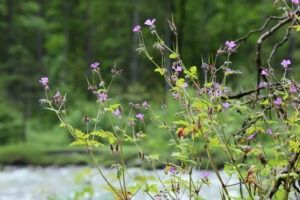
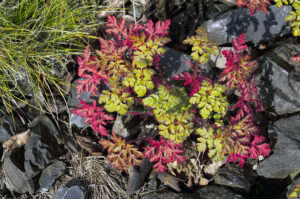
This species grows in open forests and meadows, from the lowland up to elevations around 2,300 m. It is distributed in the entire Europe, from Iceland and the British Isles eastwards to central Siberia and Kazakhstan, southwards to Spain, Turkey, and northern Iran. It has also been encountered in southern Greenland, but may be introduced there.
The specific name means ‘growing in woods’, derived from the Latin silva (‘forest’).
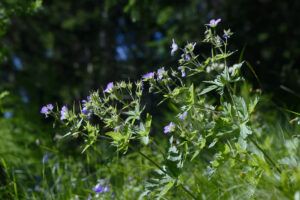
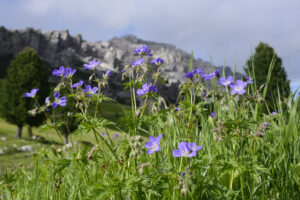
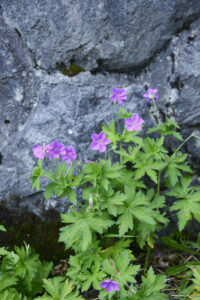
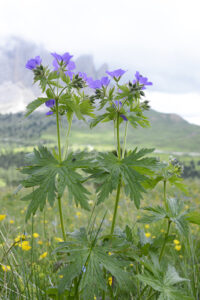
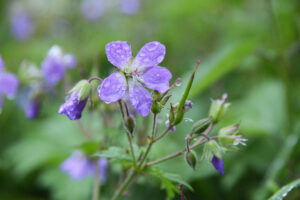
The fruit is highly distinctive, mostly globular, soft, juicy, sometimes brightly coloured or hairy.
A number of species are presented on the page Plants: Himalayan flora 2.
It is a deciduous shrub, to 3 m tall, branches spineless, leaves long-stalked, to 15 cm long and wide, with 3-5 triangular, serrated, glandular-hairy lobes. Inflorescences are pendent racemes, each with 20-35 flowers, corolla to 7 mm across, sepals to 4 mm long, hairy, pink or reddish, petals scaly, half as long as the sepals, broadly spatulate. The fruits are globular, dark red, with a sour taste. The sepals remain on the ripe berries.
Rock currant is quite similar to alpine currant (R. alpinum), but that species has much paler flowers, whose bracts are longer than the stalks, and the sepals wither before the berries mature.
The specific name is Latin, meaning ‘growing among rocks’.
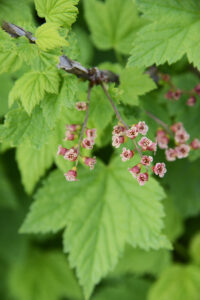
The major part of the species have yellow flowers with numerous and prominent stamens. Leaves and flowers are often dotted with glands.
The generic name is derived from Ancient Greek hyper (‘above’) and eikon (‘picture’), alluding to an old belief, that if these plants were hung above pictures, they would ward off evil spirits.
The popular name refers to Saint John the Baptist. In the Middle Ages, the blood-red juice of some species was seen as a symbol of the blood from the Saint’s beheading. John the Baptist had reproached King Herod for marrying his brother’s wife Herodias, hereby incurring Herodias’ wrath. Cunningly, her daughter persuaded the king to promise her anything she wanted, and, on request from her mother, she asked for John the Baptist’s head on a tray. (Mark, 6:18-28)
This species is partial to limestone rocks, growing at elevations between 500 and 2,500 m. It is abundant in the Pyrenees, rarer in the French and far western Swiss and Italian Alps.
The specific name is derived from the Latin nummulus (‘little coin’), referring to the leaves.
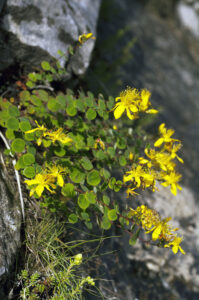
The native range is the Pyrenees, the Jura, the western and southern Alps as far east as the Bergamasque Alps (north-east of Milan), and also from the Carpathians southwards to the northern Balkan Peninsula. It may be found at altitudes between 1,000 and 2,400 m, growing in stony shrubberies and pastures, preferably on calcareous soils. It is divided into 3 subspecies, of which burseri is restricted to the Pyrenees.
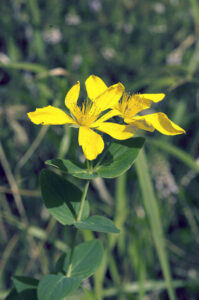
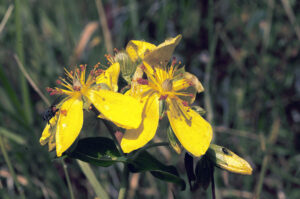
Some sources speculate that the generic name is derived from the Italian lucciola (‘to shine’ or ‘to sparkle’), or from the Latin lux (‘light’), inspired by the way the plants sparkle when wet with dew.
It is native to the major part of Europe, except the northernmost regions, growing on nutrient-poor and acid soils in forests, shrubberies, and grasslands. In the Alps, it occurs up to elevations around 2,200 m.
The specific name is Latin, meaning ‘resembling Luzula‘, which seems odd, as it is a species of Luzula. The explanation is that when French naturalist, academic, and soldier Jean-Baptiste Pierre Antoine de Monet (1744-1829), Knight of Lamarck, named the plant in 1789, he called it Juncus luzuloides (‘the rush that resembles Luzula’). It has since been transferred to the genus Luzula.
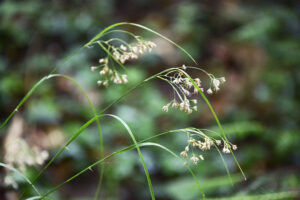
It is distributed in montane areas of central and southern Europe, including the Pyrenees, the French Massif Central, the Alps, and the northern Apennines, growing in forests up to elevations around 2,000 m.
The specific name stems from the Latin niv, an obsolete form of nix (‘snow’), thus ‘resembling snow’, referring to the inflorescences.
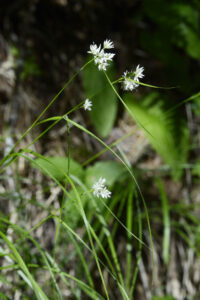
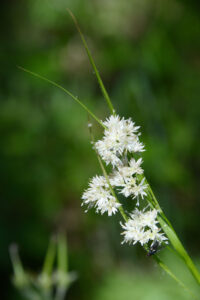
The generic name in fact stems from a writing error. It should have been abiga, from abigo (‘to force birth’ or ‘to cause an abortion’), alluding to the yellow bugle (A. chamaepitys), which was used medicinally to induce an abortion. The common name was given in reference to the tubular flowers.
It is found along forest edges, in shrubberies and grasslands, mainly in mountains, but at lower elevations. It is distributed from the Netherlands and France eastwards to European Russia, southwards to the Mediterranean, Turkey, and the Caucasus. It has also become naturalized in North America.
This herb has been used in traditional Austrian medicine as tea, taken for respiratory tract disorders.
The specific name was applied by Swiss botanist Johann Bauhin (1541-1612), who described and depicted the plant in Historia Plantarum as Consolida media Genevensis (1651). Apparently, he had observed it near Geneva.
The widely distributed common bugle (A. reptans) is quite similar, but has several runners and usually entire leaf margins. The two species occasionally interbreed.
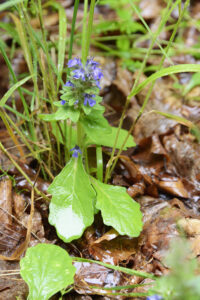
It is native to almost all of Europe, from Iceland and Scandinavia southwards to the Mediterranean, eastwards to Ukraine and the Caucasus. In the southern parts of this area, it is restricted to mountains. It grows on neutral soils in open areas, including grasslands, moors, and among rocks. In the Alps, it is found up to altitudes around 2,700 m.
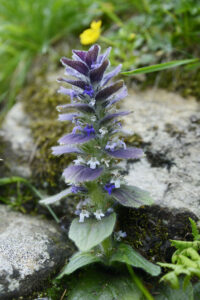
According to Roman naturalist Pliny the Elder (23-79 A.D.), an early name of B. officinalis (below) was vettonica, named for the Vettones, a people living in Spain, who used it as herbal medicine. Modern authorities, however, claim that Betonica is derived from the Celtic bew (’head’) and ton (’good’), referring to its usage against headache.
Some authorities include these plants in the genus Stachys (below).
It is widespread in the Pyrenees, the Alps, the Apennines, and the Balkan Peninsula, growing in grassy areas at altitudes between 300 and 2,300 m.
The specific name is derived from Ancient Greek alopex (‘fox’) and oura (‘tail’), alluding to the long, soft-haired inflorescence. This name was first used by Greek scholar and botanist Theophrastos (c. 371-287 B.C.).
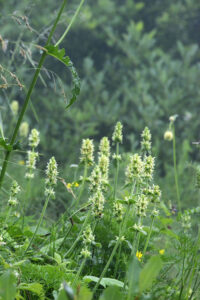
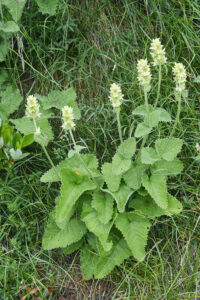
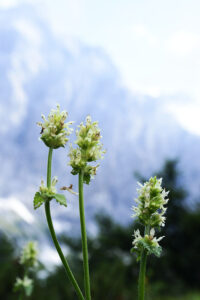
The specific name is Latin, meaning ‘hairy’.
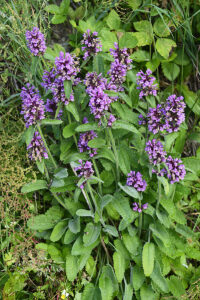
This plant is indigenous to almost all of Europe and North Africa, eastwards to central Siberia, Turkey, and the Caucasus, but is widely cultivated elsewhere. In the wild, it grows in dry grasslands and open woods.
Betony was held in high esteem by the Greeks as well as the Romans. Greek-Roman botanist Antonius Musa (64-14 B.C.), chief physician to Emperor Augustus, maintained that it was a certain cure for no less than 47 diseases. An old Italian proverb says: “Sell your coat and buy betony,” whereas a Spanish proverb says: “He has as many virtues as betony.”
More about the role of this plant in folklore and traditional medicine is described on the page Plants: Plants in folklore and poetry. Formerly, the leaves were used to dye wool yellow.
The specific name is derived from the Latin officina (‘workshop’ or ‘office’), and the suffix alis, thus ‘made in a workshop’. However, in a botanical context, the word denotes plants species that were sold in pharmacies due to their medicinal properties.
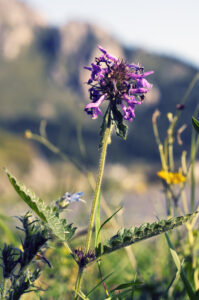
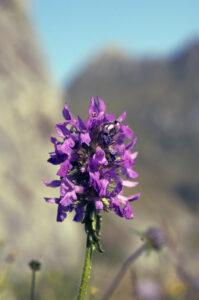
The generic name is derived from Ancient Greek klinopodion, from kline (‘bed’) and podion (‘little foot’), thus ‘little foot of a bed’, maybe alluding to the square stem of wild basil (below).
It is native to montane areas of central and southern Europe, eastwards to Ukraine and Turkey, and also in North Africa. It is very common in the Alps, growing in dry, stony places at altitudes between 900 and 2,700 m.
The plant has an aromatic fragrance like peppermint due to an essential oil. Formerly, it was utilized in folk medicine to reduce fever and to induce sweating. Dried leaves were used for tea and as flavouring in dishes.
Formerly, about 10 species of calamint were placed in the genus Acinos. In a paper, On the taxonomic status of the genus Acinos (Lamiaceae), published in Botanicheskiy Zhurnal 101(1): 80-94, 2016, botanist Denis Melnikov argues that all species of this genus should be transferred to the genus Ziziphora. Today, however, most authorites place them in the genus Clinopodium.
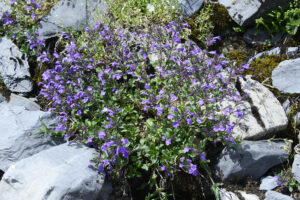
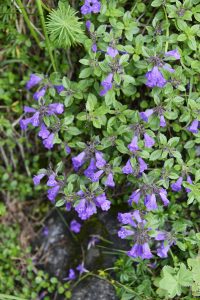
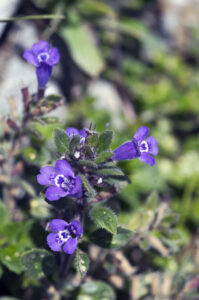
This plant grows in open areas, including dry grasslands and moors, usually on calcareous soils, from sea level to subalpine altitudes. It is very widespread, found from Scandinavia southwards to North Africa, from the British Isles eastwards to eastern Siberia, and from Turkey eastwards to Pakistan. It is also widely naturalized in North America. In the Alps, it occurs at altitudes up to about 2,000 m, in Turkey to about 2,500 m.
The leaves are utilzed as tea and in dishes, and a brown and a yellow dye can be obtained from them. Medicinally, the plant has traditionally been used as an astringent, a cardiac stimulant, an expectorant, to heal wounds, and to increase perspiration. Research has shown that it possesses anti-bacterial properties.
The specific name is Latin, meaning ‘common’.
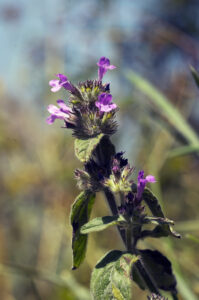
The generic name is derived from Ancient Greek gale (’weasel’) and opsis (’appearance’), alluding to the open throat of the flower, which is likened to the wide-open mouth of a weasel. The common name refers to the leaf shape of many of the species.
The origin of this plant is probably the Mediterranean and Asia Minor, but it spread to almost all of Europe, and later North America, with the advent of agriculture. In later years, it has declined in arable lands, but is still common in forest clearings, along hedges and roads, and in waste places, growing in nitrogen-rich, basic or slightly acidic soils. In mountains, it is often found in gravelly areas, in the Alps up to altitudes of at least 2,100 m.
It was formerly utilized against cramps, mucus in the lungs, swellings, and infection. A decoction of the plant is used for treatment of lung problems. It became naturalized in North America early enough for the Iroquois to use it medicinally.
The specific name is derived from Ancient Greek tetra, meaning ‘four’. It may refer to the square stem, which has rather sharp edges.
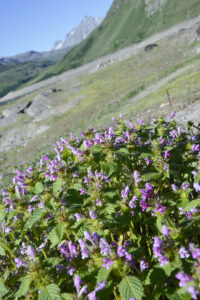
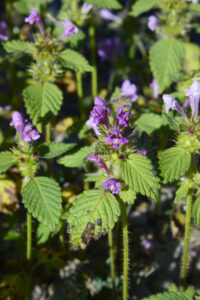
The square stem, to 45 cm tall, is sparsely glandular-hairy, leaves gathered in a basal rosette, stalked, ovate, glossy dark green, wrinkled, to 7 cm long and 5 cm broad, with blunt teeth along the margin. The flowers are arranged in one-sided whorls up the stem, each with 2-6 nodding flowers, corolla violet-blue or dark purple, tubular or bell-shaped, to 2 cm long, upper lip short, lower lip with a broad mid-lobe, throat hairy. The calyx is blackish, tubular, with 5 sharp teeth.
The generic name is derived from Ancient Greek hormao (‘to hasten’), referring to the usage of this herb as an aphrodisiac. The common name refers to the gaping corolla.
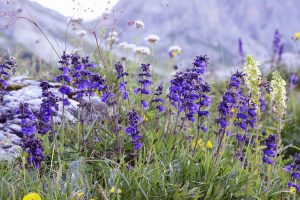
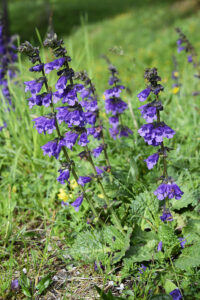
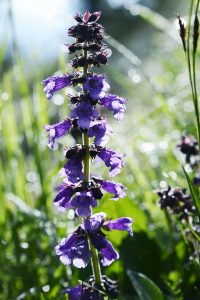
The generic name is derived from Ancient Greek lamia (‘gaping mouth’), alluding to the shape of the flowers. The common name refers to the nettle-like leaves, which do not sting.
It grows in a variety of habitats, along roads and in grasslands, woodlands, and waste places, generally on moist, fertile soils. It is native from central and southern Europe eastwards across the Middle East and the Caucasus to the Chinese provinces of Xinjiang and Gansu. In the Alps, it may be found up to elevations around 2,200 m.
The specific and common names were given in allusion to the spotted lower lip.
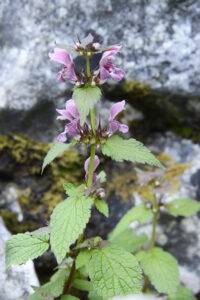
The generic name is a Latinized version of minthe, the Ancient Greek word for these plants.
This species is native to the major part of Europe eastwards to central Siberia, and thence southwards to the Arabian Peninsula, Iran, the Himalaya, and China, and to northern, eastern, and southern Africa, avoiding tropical areas.
The plant has a peppermint-scented fragrance and contains medicinal properties. In his Complete Herbal, from 1653, English herbalist Nicholas Culpeper (1616-1654) writes: “It is good for wind and colic in the stomach … The juice, laid on warm, helps the King’s evil [scrofula] or kernels in the throat [tonsil stones] … The decoction or distilled water helps a stinking breath, proceeding from corruption of the teeth, and snuffed up the nose, purges the head. It helps the scurf or dandruff of the head used with vinegar.”
The specific name is Latin, meaning ‘with long leaves’. The epithet horse stems from Middle English, denoting a coarse variety of a plant, in this case presumably alluding to the inferior quality of horse mint, compared to peppermint (M. x piperata).
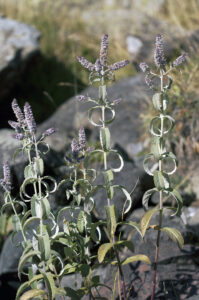
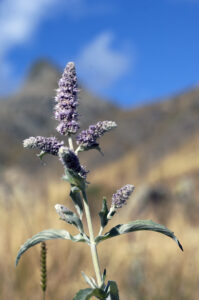
About the generic name, formerly spelt Brunella, English botanist William Coles (1626-1662), also called William Cole, writes in his book Adam in Eden, or Nature’s Paradise. The History of Plants, Herbs, Flowers (1657): “(…) Brunella, from Brunellen, which is a name given unto it by the Germans, because it cureth that inflammation of the mouth which they call ‘die Breuen’.” Cole was partly mistaken, as the German name of the common self-heal is Braunelle, and the inflammation, which is not in the mouth, but in the throat, is called Bräune.
It mostly grows in grasslands on calcareous soils (subspecies pyrenaica on acid soils), distributed in the major part of Europe, southwards to the Mediterranean, eastwards to European Russia and the Caucasus. In the southern parts of the distribution area, it is restricted to mountains. It is quite common in the Alps, found up to elevations around 2,400 m.
The specific name is Latin, meaning ‘with large flowers’.
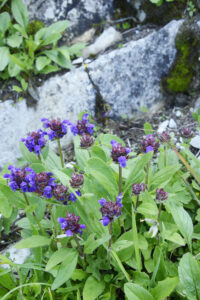
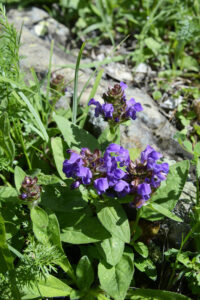
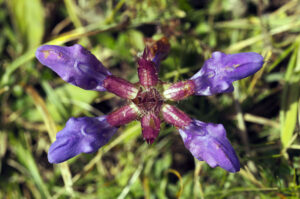
In his delightful book All about Weeds, American botanist Edwin Spencer (1881-1964) writes: “It is a strange plant in that one seldom finds it in abundance anywhere, and yet it is found everywhere. A man, who had spent seven years in Japan, and who had lived on nearly every island in the archipelago, said that he never failed to find this little plant wherever he went, and that although he had been in many nations of the world he had never entered one, where Prunella was not present to greet him – not many plants, but always enough to attract his attention.”
In his Herball (1597), English herbalist John Gerard (c. 1545-1612) writes: “There is not a better wound herbe in the world than that of Self-Heale (…) for this very herbe, without the mixture of any other ingredient (…) will be brought into the form of a salve, which will heal any green wounde, even in the first intention, after a very wonderful manner. The decoction of Prunell, made with wine and water, doth join together and make whole and sound all wounds, both inward and outward.”
Among American natives, persons with fever were bathed in a decoction of self-heal. This decoction was also drunk to sharpen your vision. In the Pacific Northwest, juice of the plant was applied to boils and was also used to treat cuts and inflammations.
Today, self-heal is widely used for wounds and quinsy. In Nepal, it is utilized for swollen eyes and glands, and a paste of the plant is applied to an aching back.
The mildly bitter leaves can be used in salads.
The specific name is Latin, meaning ‘common’.
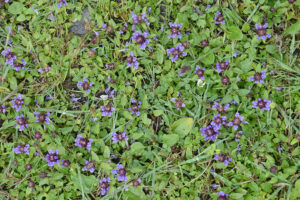
The generic name is derived from the Latin salvere (‘to make well or healthy’), referring to the healing properties of the common sage (S. officinalis).
This plant is native to Europe, except Scandinavia and Iceland, and also to northern Africa and western Asia, eastwards to the Ural Mountains and Caucasus. It has become naturalized in many parts of the United States, and in the state of Washington it is considered a noxious weed.
The specific name, from the Latin pratum (‘meadow’) and ensis (‘of’ or ‘from’), refers to its preferred habitat, but it may also be found in shrubberies and along forest edges, preferably on nutrient-rich, calcareous soils. In the Alps, it has been encountered up to altitudes around 1,700 m.
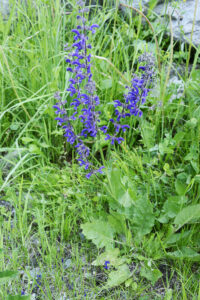
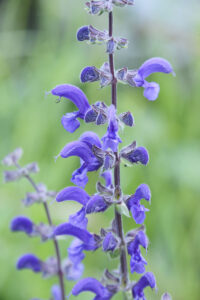
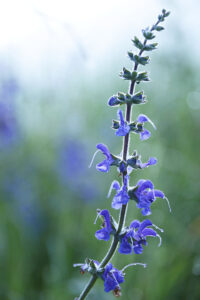
Several species have been utilized as herbal medicine, especially as tea.
The generic name is derived from Ancient Greek siderites (‘made of iron’), alluding to a belief that these plants were capable of healing wounds, caused by iron weapons during battles. Others claim that the name stems from the shape of the sepal, which resembles the tip of a spear.
This species occurs in mountains of south-western Europe, from the Pyrenees eastwards to the western Alps and the Jura. It grows in forests, meadows, and rocky areas, preferably on limestone, at elevations between 1,500 and 1,800 m.
The specific name is Latin, meaning ‘with leaves like hyssop’ (Hyssopus officinalis).
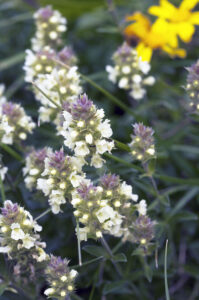
The generic name is the Ancient Greek name of the downy woundwort (S. germanica). The popular name woundwort refers to the former usage of several species in this genus for healing wounds, hedge-nettle to the nettle-like leaves of many of the species.
This plant grows in grassy areas and forest clearings at elevations between 400 and 2,000 m, from Spain via the Alps to the Balkan Peninsula, and thence throght Turkey to the Caucasus and the Alborz Mountains of northern Iran. It also occurs at a few locations in England and Wales.
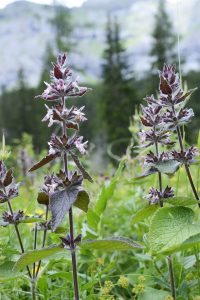
This plant is native to central and southern Europe, from Belgium and Spain eastwards to European Russia, the Caucasus, and Iran. It grows in dry grasslands, on rocky slopes, and along roads, mostly on calcareous soilsm from sea level to altitudes around 2,100 m.
The specific name is Latin, meaning ‘straight’ or ‘upright’, which supposedly refers to the inflorescence – a bit odd, as many species in this genus have upright inflorescences.
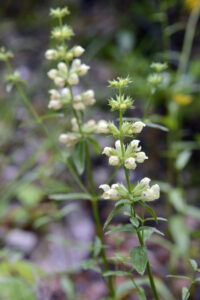
The generic name was used for several members of the genus by Greek physician, pharmacologist, and botanist Pedanius Dioscorides (died 90 A.D.), who was the author of De Materia Medica (5 volumes dealing with herbal medicine). It is believed to refer to King Teukros of Troy who used the plant medicinally.
The popular name is Middle English, from the Latin germandra, derived from Ancient Greek khamaidrus (‘ground oak’), from khamai (‘on the ground’) and drus (‘oak’), alluding to the leaves of some species, which were thought to resemble oak leaves.
This plant is native to central and southern Europe and North Africa, eastwards to Ukraine and Turkey, growing in grassy and rocky areas on calcareous soils, from the lowland up to elevations around 2,400 m.
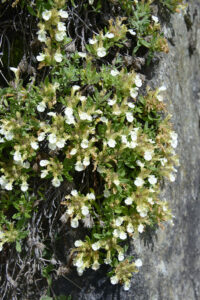

It grows on dry, stony, calcareous and nutrient-poor soils, in grasslands and on rocky slopes, from sea level to elevations around 2,000 m. It is distributed in the Pyrenees and the Cantabrian Mountains of northern Spain, and it has also been observed in the south-eastern French departments Drôme and Isère.
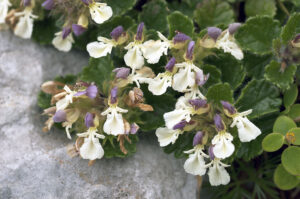
The genus, containing about 125 species, is widely distributed in subarctic and temperate regions of the Northern Hemisphere, and also in Central and South America.
The generic name is diminutive of the Latin pinguis (‘fat’ – compare the word ‘penguin’), which, like the common name butterwort, refers to the slimy and fatty leaves. The name was first applied by Swiss physician and naturalist Conrad Gessner (see Doronicum above) in his unfinished work Historia plantarum.
Its role in folklore and medicine is described on the page Plants: Plants in folklore and poetry.
The specific name is Latin, meaning ‘common’.
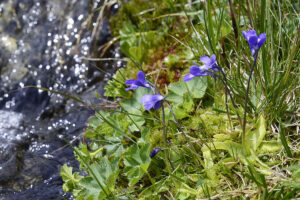
In the Alps, it is quite common up to elevations around 2,500 m, but has been encountered up to 2,650 m.
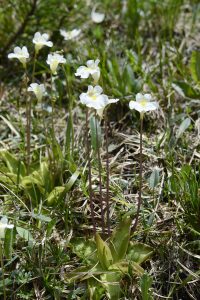
Following genetic studies, Lloydia species have now been moved to the genus Gagea, which contains more than 200 species, widely distributed in Eurasia, with a few species in North Africa and North America. The major part of the species have yellow, star-shaped flowers. For this reason, the common English species, G. lutea, is popularly known as the yellow Star-of-Bethlehem.
The generic name honours English botanist Sir Thomas Gage, 7th Baronet of Hengrave (1781-1820).
A very tough plant, which often grows in rocky, windy locations. In such areas, insects are unlikely to visit, and self-pollination is often facilitated.
As described above, this species was first observed in Wales. Otherwise, it is widely distributed in montane areas of the Northern Hemisphere, from the Alps and the Carpathians eastwards to the Himalaya, Central Asia, Siberia, China, Korea, and Japan, and also in western North America, from Alaska southwards to New Mexico. In the Alps, it grows in open areas at elevations between 1,600 and 3,100 m. In the Himalaya, it may be encountered up to altitudes around 4,800 m.
The specific name is derived from the Latin serus (‘late’), i.e. flowering late in the season – an odd name, considering that in the Alps it blooms between June and August.
In Welsh, it is called brwynddail y mynydd, meaning ‘rush-leaved one of the mountain’.
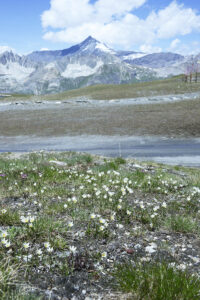
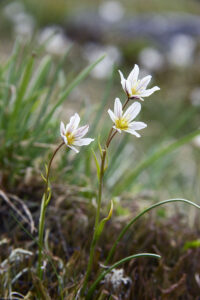
The generic name is the classical Latin name of these plants.
It comes in two varieties, var. bulbiferum, which has bulbils in the axils of the upper stem, and var. croceum, which has no bulbils. The bulbils fall to the ground and mature after two or three years.
This plant is widely distributed in montane areas, at altitudes between 500 and 1,900 m, from the Pyrenees eastwards to the Carpathians, and from northern Germany (Harz Mountains) southwards to the Balkans. It also has a spotted occurrence in Scandinavia, but whether these are genuine wild plants or escapes, is an open question.
The specific name is derived from the Latin bulbifer, meaning ‘bulb-bearing’, of course alluding to the bulbils. The common names refer to the gorgeous flowers.
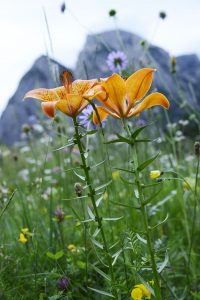
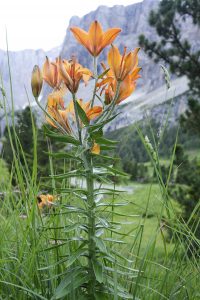
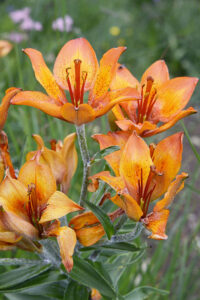
It is native to the Balkans, northwards to southern Austria and north-eastern Italy.
The specific name refers to Carniola, a historical region in the border area of present-day Italy and Slovenia, where it is quite common.
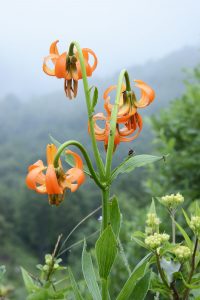
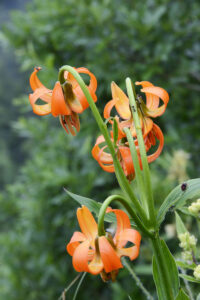
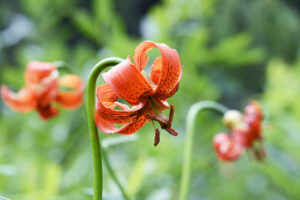
It has a very wide distribution, found from Portugal and the Pyrenees eastwards across the Alps to the Balkans, Turkey, and the Caucasus, and across southern Siberia to Xinjiang, Mongolia, and the Yenisei River. In Scandinavia, it has become naturalized. It is quite common in the Alps, growing from the lower slopes to altitudes around 2,650 m.
It is partial to calcareous soils, at lower altitudes growing in open forests. If conditions get too shady, it may not flower. At higher altitudes, it is found in open areas, especially tall-grass meadows.
German Dominican friar, philosopher, scientist, and bishop Albertus Magnus (c. 1200-1280) recommends juice of this plant for kidney pain, and boiled bulbs of the plant should be good as a cure for obsession. It is highly recommended for children with pain from growing teeth. It was enough to hang the bulbs around their neck as an amulet – they must at least be worn on Fridays during the Lord’s Prayer, they must not be touched with bare hands, and they must be sown into a small piece of cloth without making knots on the thread.
In case you place the yellow bulbs near milk or butter, they also turm yellow. Formerly, in Franconian Switzerland, cows were fed with the bulbs on Walpurgis Day to dye the fat yellow.
The name martagon is derived from the Turkish martagan (‘turban’), which, like the popular name Turk’s cap, refers to the flower shape.
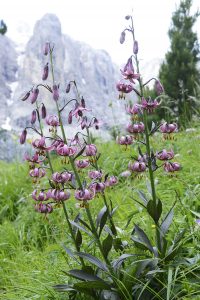
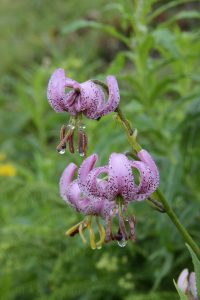
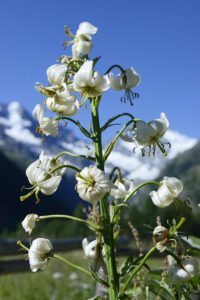
The generic name is a Latinized version of linon, the Ancient Greek name of flax.
This plant is found in mountains, at altitudes between 1,400 and 2,500 m, from central and southern Europe eastwards across western Asia to the Ural Mountains, growing on limestone in grassy areas, among rocks, and in scree. In central Europe, it occurs in the Pyrenees, the Alps, and the Apennines.
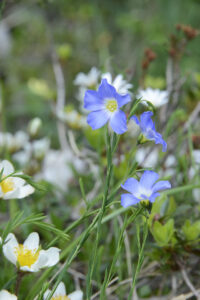
In Ancient Rome, it was believed that sneezing would confirm the truthfulness of an assertion. The powdered root of white false helleborine was used in snuff and would definitely make you sneeze. For this reason, Roman naturalist Pliny the Elder (23-79 A.D.) named the plant veratrum, derived from verare (‘truthful’).
Others claim that the generic name is derived from Proto-Indo-European wreyt (‘twisting’ or ‘writhing’), perhaps alluding to the spirally arranged stem leaves.
The common name is derived from Ancient Greek helleboros, which was the word used for Helleborus orientalis (see Ranunculaceae).
All parts of this species are poisonous. It is thus avoided by grazing animals and tends to form large growths in open, grassy areas up to altitudes around 2,700 m. It is widely distributed in central and southern Europe, from Portugal and the Pyrenees eastwards to Turkey and the Caucasus, and also from far northern Norway and Finland eastwards across subarctic areas to eastern Siberia.
Incidentally, it has been speculated among historians, if the death of Macedonian king Alexander the Great (356-323 B.C.) was due to poisoning with white false helleborine. The king was ill for twelve days and suffered symptoms similar to those of poisoning with this plant. (Source: L. Schep 2013. Was the death of Alexander the Great due to poisoning? Was it Veratrum album? Clinical Toxicology 54 (1): 72-77)
The specific name is Latin, meaning ‘white’, alluding to the pale flower colour.
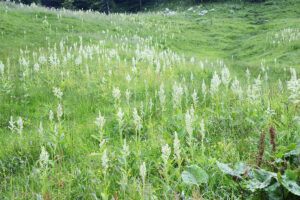
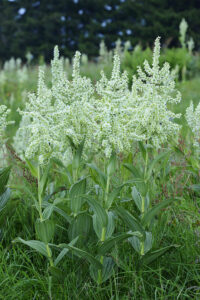
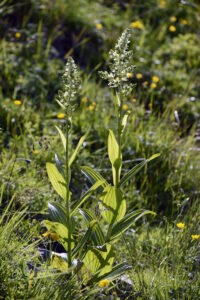
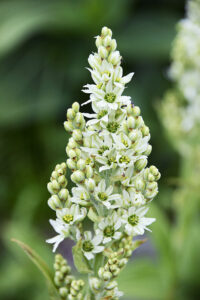
It is widely distributed, from central, southern, and eastern Europe eastwards across the Caucasus, Tibet, and Mongolia to eastern Siberia.
The specific name was given in honour of Flemish botanist and physician Matthias de l’Obel (1538-1616), who, in a work entitled Stirpium adversaria nova, from 1570, divided plants into 7 classes: cereals, orchids, garden plants, vegetables, trees and shrubs, palms, and mosses. No less than 2,191 plant species were depicted in his work Plantarum seu stirpium historia, from 1576.
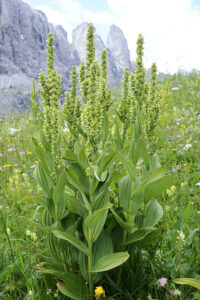
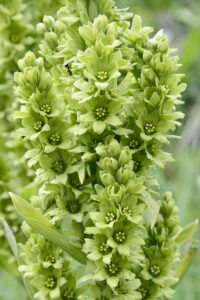
The family name is derived from Onagra, the original name of evening-primroses (today called Oenothera). The term Onagra was first used in botany in 1587, meaning ‘(food) of onager’, an Asiatic species of wild ass (Equus hemionus). It is most odd that this name later was applied to evening-primroses, which were originally purely American plants.
There is much controversy as to the name of this genus. Initially, Chamaenerion may have originated as early as 1561. It is derived from Ancient Greek khamai (‘near the ground’) and nerion, the Ancient Greek name of the oleander (Nerium oleander), alluding to the oleander-like leaves of rosebay willow-herb (below). In 1753, Swedish botanist Carl Linnaeus (1707-1778) placed these plants in the genus Epilobium (below). However, many botanists disregarded his decision, preferring Chamaenerion.
In 1818, French naturalist Constantine Samuel Rafinesque-Schmaltz (1783-1840) proposed the name Chamerion, suggesting it as either a subgenus or genus. Rafinesque had his own peculiar rules of botanical nomenclature, regarding it as appropriate to shorten existing generic names. His new name, however, was not widely accepted until published in 1972 by Czech botanist Josef Ludwig Holub (1930-1999), who designated a different type species, Epilobium amenum. However, as this species is now included in C. angustifolium, Chamaenerion has precedence over Chamerion. Some authorities still include these plants in Epilobium. (Source: A.N. Sennikov 2011. Chamerion or Chamaenerion (Onagraceae)? The old story in new words, Taxon 60 (5): 1485-1488)
The common name alludes to the similarity of the leaves of rosebay willow-herb to those of certain species of willow (Salix).
This gregarious herb often forms large growths, especially in open disturbed habitats, such as forest clearings and abandoned fields. An example of the latter is described on the page Nature Reserve Vorsø: Expanding wilderness.
It is very widely distributed in northern temperate and subarctic areas, southwards to Morocco, Pakistan, northern Indochina, Korea, and northern United States. It is common in the Alps and the Pyrenees, found up to elevations around 2,500 m. In the Himalaya, it may be encountered up to about 4,700 m.
The specific name is Latin, meaning ‘narrow-leaved’. The name fireweed refers to the ability of this species to rapidly colonize areas, burned by fire. Incidentally, it was one of the first plants to appear when the eruption of Mt. St. Helens, Washington State, had devastated a huge area in 1980.
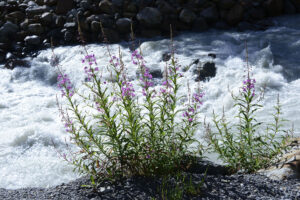
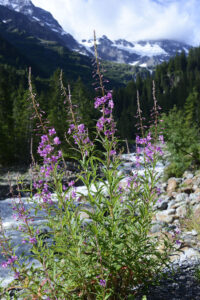
This species is widespread in central and southern Europe, from eastern France eastwards to Ukraine, and thence southwards to Turkey, the Caucasus, and northern Iran. It grows on rocky slopes and in gravelly and sandy areas on calcareous soils, found up to elevations around 2,000 m.
The specific name is derived from Dodona, a town and religious shrine in Ancient Greece, situated near present-day Ioannina, north-western Greece. Presumably, the type specimen was collected there. An obsolete specific name is rosmarinifolium, alluding to the leaves being quite similar to those of rosemary (Salvia rosmarinus).
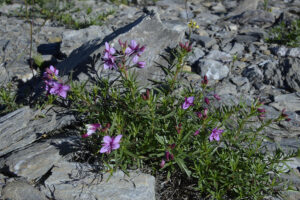
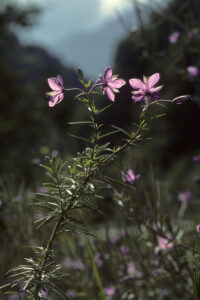
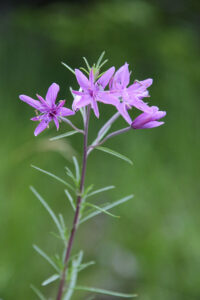
The generic name was used as early as 1561 for E. angustifolium (today Chamaenerion angustifolium, above) by Swiss physician and naturalist Conrad Gessner (see Doronicum above) in his unfinished work Historia plantarum. He composed the name from Ancient Greek ion epi lobion (‘violet on a pod’), lobion literally meaning ‘fruit of the cowpea (Vigna unguiculata), alluding to the similarity of the flower colour to that of certain violets (Viola), and to its pod-like fruit.
The common name refers to the similarity of the leaves of some species to those of certain species of willow (Salix).
This species occurs in almost all of Europe, eastwards to western Siberia. In Europe, it is mainly found in the south, rare or absent further north. It grows in sunny, stony places, on stone walls, and in dry shrubberies, on acid soils. In the Alps, it occurs up to elevations around 2,000 m.
The specific name is Latin, meaning ‘growing on hills’.
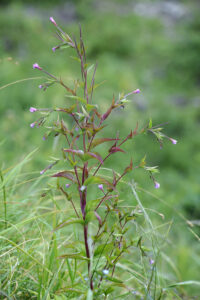
Orchids are divided into terrestrial species, growing in soil, and epiphytic species, growing on trees (sometimes on rocks or fallen tree trunks). The latter develop aerial roots that absorb nutrients and moisture from the air, and many have pseudobulbs, swollen, fibrous, bulb-like stems that store water and nutrients. The species described here are all terrestrial.
The flower structure of this family is unique. There are 3 sepals, often coloured and shaped like 2 of the 3 petals. The third petal forms the lower lip, usually differering very much from the other petals in size and shape, and sometimes in colour, often with a spur. Stamens and ovary are fused, forming the so-called column. Anthers and stigma are separated by a beak-like structure, the rostellum. The anthers produce so-called pollinia, small ‘bags’ which contain pollen. These pollinia easily stick to visiting insects by a sticky secrete, and the insects then transport them to the next flower where they get attached to the stigma. Other species are self-pollinating. The fruit is a capsule, containing countless tiny seeds, spread by the wind.
Most of these plants live in symbiosis with the mycelium of underground fungi, which is attached to the rhizome or root of the plants. When an orchid seed is about to germinate, it is completely dependent on this mycelium, as it has virtually no energy reserve, obtaining the necessary carbon from the fungus. Some orchids are dependent on the mycelium their entire life, but their relationship is symbiotic, as the orchid delivers crucial water and salts to the fungus. However, some species do not contain chlorophyll, being parasites on the fungi.
The family name is derived from Ancient Greek orkhis (‘testicle’), alluding to the underground tubers of members of the genus Orchis, which resemble testicles.
The generic name is derived from Ancient Greek kephale (‘head’) and antheros (‘anther’), alluding to the anther that sits on the column like a head.
The common name is Old English, denoting various plants supposed to cure madness, derived from Ancient Greek helleboros, which was the word used for Helleborus orientalis (see Ranunculaceae). The same name is used for members of the genus Epipactis (below).
This species grows in open forests and shrubberies, rarely in grasslands, on calcareous soils, up to elevations around 2,600 m. The flower colour is largely determined by the amount of lime in the soil. The richer the substrate, the stronger the colours. It is found in most of Europe, North Africa, and the Middle East, eastwards to the Ural Mountains, Iran, and Turkmenistan.
The specific name is Latin, meaning ‘red’.
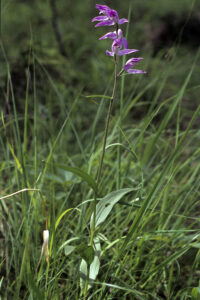
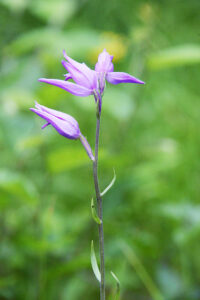
The generic name is derived from Ancient Greek dactylos (‘finger’) and rhiza (‘root’), alluding to the two divided, finger-like tubers. The genus was previously included in the genus Orchis, which, however, may be identified by having two round tubers (see family name above).
Typical habitats include open forests, moderately wet meadows, and along streams, mostly on calcareous soils. It is widespread from almost all of Europe eastwards across Siberia to Yakutiya, Xinjiang, and Mongolia. In the Alps, it may be found up to elevations around 2,300 m.
The specific name honours German physician and botanist Leonhart Fuchs (see Allium schoenoprasum above).
Some authorities regard this species as a subspecies, fuchsii, of the heath spotted orchid (D. maculata), which, however, grows on acid soils, and its lip is less deeply trilobed.
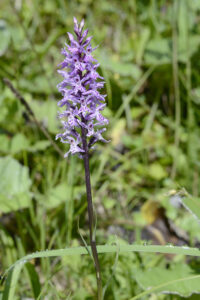
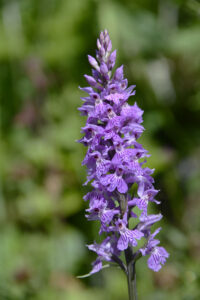
This plant is distributed in central Europe, from the Black Forest and the Vosges eastwards to western Siberia, growing in wet meadows and bogs. In the Alps, it has a scattered occurrence, found from the lower valleys up to altitudes around 2,100 m.
The specific name honours Austrian pharmacist, botanist and politician Joseph Traunsteiner (1798-1850).
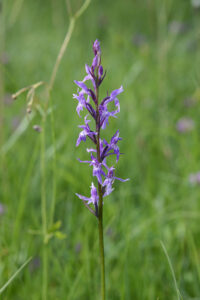
It is widely distributed in temperate and subarctic areas of the Northern Hemisphere, southwards to the Mediterranean, Iran, southern China, and the central United States. It grows in grassy areas, preferably on moist, fertile soil. It is quite common in the Alps, growing up to elevations around 3,000 m.
The specific name, meaning ‘green’ in Latin, alludes to the greenish colour of the flowers. The popular name also refers to the flower colour, which is not unlike the colour of certain frogs. The obsolete generic name is derived from Ancient Greek koilos (‘hollow’) and glossa (‘tongue’), alluding to the hollow spur on the tongue-like lip.
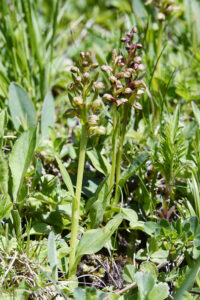
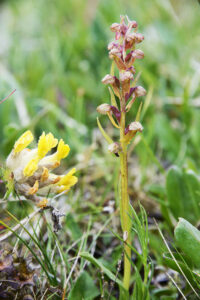
Members are characterized by the lip, which is divided into two parts, a concave inner part, forming a small pouch-like bowl, which contains nectar, and a triangular outer part. They have no spur.
The generic name is a Latinized version of Ancient Greek epipaktis, which is of uncertain meaning. It has been proposed that it may derive from epipaktóo (‘to shut close’), alluding to the healing powers of the tuber of E. helleborine, which was traditionally used for treatment of insanity, gout, headache, and stomach ache.
The common name is Old English, denoting various plants supposed to cure madness, derived from Ancient Greek helleboros, which was the word used for Helleborus orientalis (see Ranunculaceae). The same name is used for members of the genus Cephalanthera (above).
This species prefers warm and dry locations on basic to neutral, nutrient-poor soils, growing in open forests, grassy areas, among rocks and in scree, and on sandy soils such as dunes. It is also a pioneer species, which may occur in fallow fields and along roads.
It is a common plant in the Alps, found from the lowlands up to altitudes around 2,400 m. It is widespread in Europe, from subarctic areas southwards to the Mediterranean, and thence eastwards to the Caucasus, Iran, and western Siberia.
The specific name is derived from the Latin ater (‘dark’ or ‘black’) and ruber (‘red’), alluding to the flower colour.
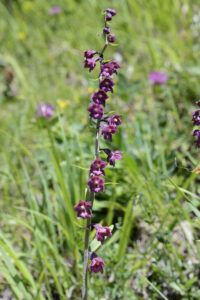
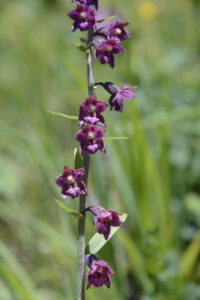
There is much controversy regarding the systematics of vanilla orchids. Most authorities place them in this genus, others maintain that the genus Nigritella, where they formerly belonged, is still valid. Future genetic studies may throw light on the issue.
The generic name is derived from Ancient Greek gymnos (‘nude’) and aden (‘gland’), referring to the nectar glands.
This species is widely distributed in temperate areas of Europe, eastwards to the Pacific, southwards to the Mediterranean, Iran, southern China, and Japan. In the southernmost areas, it is restricted to mountains. In the Alps, it may be encountered up to elevations around 2,800 m. Its habitats include open forests, humid grasslands, near springs, and along roads.
It was first mentioned by German physician and botanist Leonhart Fuchs (see Allium schoenoprasum above) in his work New Kräuterbuch (‘New Herbal Book’) in 1543, in which he calls it Creutzbluom mennle (‘male cross-flower’), whereas Creutzbluom weible (‘female cross-flower’) refers to heath spotted orchid (Dactylorhiza maculata).
The specific name is derived from Ancient Greek konops (‘mosquito’). With a bit of imagination, the flower resembles a mosquito, the long spur being the mouthparts.
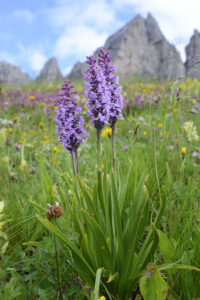
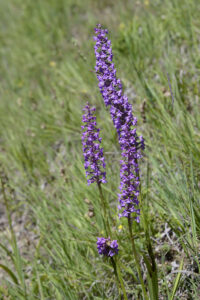
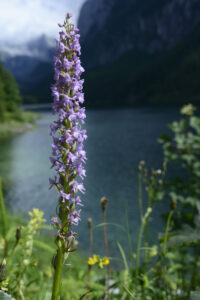
Stem erect, to 22 cm tall, somewhat angular due to the decurrent leaves, which are numerous below, grass-like, smooth, upper leaves few, very small, bract-like. The inflorescence is a terminal, very dense, hemispherical or ovoid cluster of dark blackish-purple, reddish-purple, or rose-coloured flowers, bracts narrowly lanceolate, as long or slightly longer than the flowers, margin entire or slightly wavy, petals to about 1 cm long and 2 mm wide, lip to 1.2 cm long, pointing upwards, spur very short, bag-shaped. The flowers emit an intense fragrance of vanilla.
This plant, in its widest sense, is widely distributed in Europe, from the Pyrenees across the Alps to the Carpathians and the Balkan Mountains, growing in short-grass meadows at altitudes between 900 and 2,800 m.
A few vulnerable populations are also found in Scandinavia, where it used to be quite common in montane hay-fields, in which old-fashioned farming methods were practiced, but, following the introduction of modern agricultural practice, these populations have been greatly reduced.
The specific name is derived from the Latin niger (‘black’), referring to the flower colour.
The popular name refers to the very dark purple flowers and their strong fragrance of vanilla. In the Alps, two ancient names of this plant were Chokolat-Blümel and Chokoladen-Blümchen, both meaning ‘little chocolate flower’, of course referring to the flower colour.
Plants with rose-coloured flowers are variously treated as a subspecies, rubra, of black vanilla orchid, or as a separate species, rosy vanilla orchid (G. rubra). They often grow together, and to me it seems logic that rose-flowered plants may merely be a colour variety of black vanilla orchid.
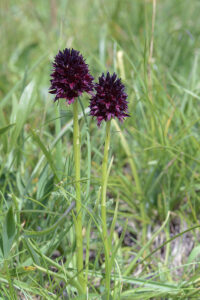
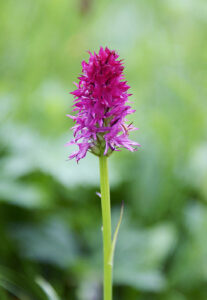
The generic name was given in honour of Italian botanist Vincenzo Tineo (1791-1856), who was director of Palermo Botanical Garden and later the chancellor of Palermo University. His published a number of works, including Plantarum rariorum Sicilae (1817) and Catalogus plantarum horti (1827).
It is distributed in the major part of Europe, from England and Portugal eastwards to central Siberia and the Caucasus. It is rare in North Africa. It has a scattered occurrence in the Alps, encountered up to elevations around 2,400 m. It typically grows in open grasslands and open forests, preferably on calcareous soils, but occasionally on acidic soils.
The specific name is Latin, meaning ‘scorched’, like the common name given in allusion to the flower buds, which are a very dark purplish-black, somewhat resembling the colour of charcoal.
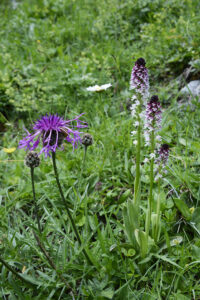
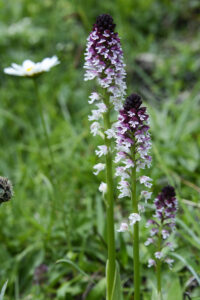
In its wider sense, the genus now contains about 80 species, native to cooler regions across most of Europe, northern Asia, and North America, with a few species extending into subtropical regions around the Mediterranean, in Indochina, and in the south-eastern United States.
The generic name is Ancient Greek, meaning ‘bird’s nest’, alluding to the appearance of the tangled roots of N. nidus-avis (below).
It is very easily identified by its brownish stem and flowers, entirely devoid of chlorophyll. The stem is to 40 cm, rarely 60 cm tall, with a terminal spike of up to 60 flowers. To germinate, the seeds are completely dependent on various species of fungi of the genus Sebacina.
The specific name is Latin, meaning ‘bird’s nest’, which, as the popular name, alludes to the thick, tangled root, which somewhat resembles a bird’s nest.
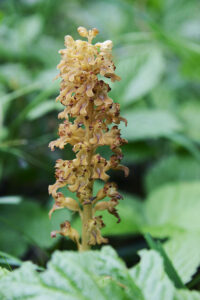
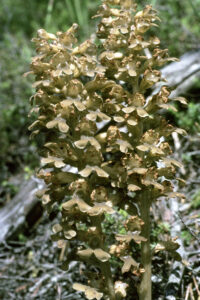
The generic name is derived from Ancient Greek platys (‘flat’, in this connection probably meaning ‘broad’ or ‘wide’), and antheros (‘anther’), referring to the wide separation of the pollinia in the greater butterfly-orchid (P. chlorantha).
The English name alludes to the flower shape.
More about butterfly-orchids is found on the page Quotes on nature.
The pollinia are parallel, sitting close together, a character, which separates this species from the similar greater butterfly-orchid (P. chlorantha), in which they are separated and point away from each other below. The spur is to 3 cm long, slightly curved (or straight in subspecies latiflora). It produces abundant nectar and is pollinated by moths.
The subspecies latiflora, known as long-spurred lesser butterfly-orchid, grows in open forests. As its name implies, it has a very long spur, to 4 cm long, which is completely straight.
The lesser butterfly-orchid is distributed in temperate areas of Europe and northern Asia, eastwards to central Siberia and Mongolia, and also in North Africa and the Middle East, eastwards to the Caucasus and Iran. It thrives on acid as well as calcareous soils, growing in deciduous forests, shrubs, moors, and grassy areas, in the Alps encountered up to elevations around 2,500 m.
The specific name is Latin, meaning ‘with 2 leaves’, referring to the 2 basic leaves.
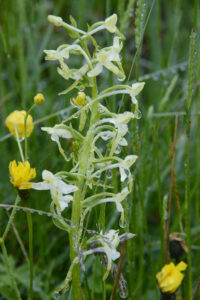
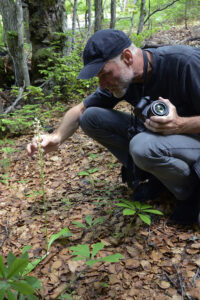
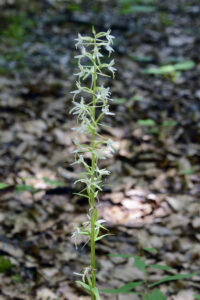
The generic name was given in honour of Austrian pharmacist, botanist and politician Joseph Traunsteiner (1798-1850).
This plant is found in montane grasslands on calcareous soils, from central and southern Europe eastwards to Ukraine and the Caucasus. In the Alps, it has been encountered up to elevations around 2,600 m.
The specific name refers to the inflorescence.

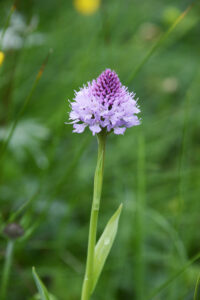
Many genera in the family are hemiparasites, i.e. they contain chlorophyll, making them able to partly sustain themselves. These hemiparasites were formerly included in the figwort family (Scrophulariaceae), but, following extensive DNA research, they have been moved to the broomrape family.
The sole remaining member, the alpine bartsia, is easily identified by its dark purple inflorescence, an adaptation to repel harmful UV-radiation. It is a prostrate plant, often branched from below, stems erect or ascending, hairy, to 30 cm tall. Leaves opposite, ovate, very hairy, to 2.5 cm long, toothed along the margin. The lower leaves are green, those above are tinged with purple. The dark purple corolla is narrow at the base, to about 2 cm long, 2-lipped, a hood-like upper lip and a shorter lower one with 3 blunt lobes.
This plant is distributed in subarctic areas, from Scandinavia eastwards to central Siberia, and also in Iceland, Greenland, and north-eastern Canada. In southern Europe, it is restricted to mountains, found in the Pyrenees, the Alps, mountains of eastern Europe, and on the Balkans. Populations in the Black Forest and the Vosges, and on the Swedish island of Gotland, are regarded as ice-age relics. It is common in the Alps, growing on calcareous soils in grasslands and among rocks, at altitudes between 1,000 and 3,000 m.
The genus was named in honour of a Prussian botanist, Johann Bartsch (1709-1738) of Königsberg. The famous Swedish botanist Carl Linnaeus (1707-1778) urged him to participate in an expedition to present-day Suriname as a physician, but, unfortunately, he perished during this journey.
The plant was first named by Swiss botanist Gaspard Bauhin (see genus Cirsium above) as Teucrium alpinum coma pupureocoerulea (‘Alpine hairy purplish-blue germander’).
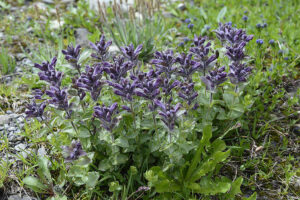

Most species are very similar, and they often hybridize, which makes it even more difficult to identify them. The majority are small, branched from below, leaves opposite, more or less ovate, strongly serrated, flowers small, 2-lipped, upper lip very short, lower lip lobed, mostly white with purple or reddish streaks and a yellow spot near the throat, rarely completely yellow or violet.
The usage of these plants for eye problems goes back to medieval Europe. Followers of the Doctrine of Signatures claimed that the Great God had created all plants in a way to make it possible for humans to recognize the usage of them. To them, the red streaks on the petals of eyebright resembled bloodshot eyes, and this plant was therefore an effective remedy for eye diseases. For once, the followers of the Doctrine of Signatures hit the nail on the head, as the plant is still recommended for conjunctivitis (‘red eyes’), infection of the eyelid, and discharge from the eyes.
The generic name stems from Ancient Greek, derived from Euphrosyne (’gladness’), the name of one of the three graces who was distinguished for her joy and mirth, probably given to the plant because of its properties as a medical herb. A popular French name of the plant is casse-lunettes, which loosely translates as ‘throw away your glasses’.
More about eyebright is found on the page Plants: Plants in folklore and poetry.
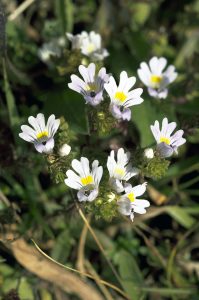
The generic name is derived from Ancient Greek orobos (‘vetch’) and ankhein (‘to strangle’), alluding to the bean broomrape (O. crenata), which is a common parasite on the fava bean (Vicia faba).
It has a wide distribution, occurring in the major part of Europe and in North Africa, eastwards through Russia and south-western Asia to Tibet, the Himalaya, and central China. In the Alps, it is found up to altitudes around 1,900 m, whereas in Asia it has been encountered up to 3,700 m. It prefers moderately dry, calcareous soils.
The specific name is Latin, meaning ‘white’, referring to the pale (but rarely completely white) flowers.
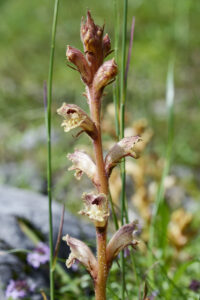
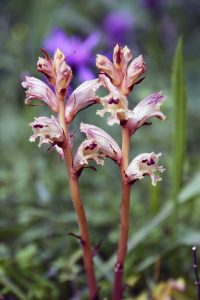
Stem erect, slender, hairy, reddish, brownish, or yellowish, to 60 cm tall, leaves and bracts dark purple, scale-like, flowers in a dense terminal spike, corolla tubular, to 2.4 cm long, glandular-hairy, brownish-yellow outside, blood-red inside.
The specific name is Latin, meaning ‘slender’, perhaps alluding to the stem.
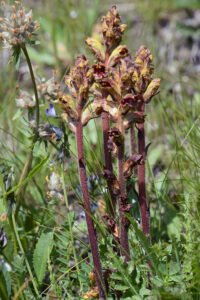
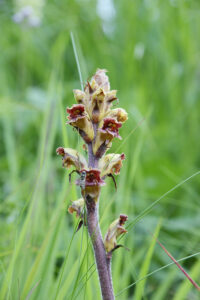
This plant is parasitic mainly on members of the pea family (Fabaceae), including clover (Trifolium) and sainfoin (Onobrychis). It grows in grassy areas on a wide variety of soils, acid, neutral, or alkaline, in the open or in semi-shade. It is native to central and southern Europe, eastwards to Ukraine, Turkey, northern Iraq, and the Caucasus, and also to the Arabian Peninsula, and northern and eastern Africa. It has become naturalized in several South American countries. In the Alps, it is restricted to lower altitudes, usually below 800 m.
Formerly, it was utilized to treat various health problems.
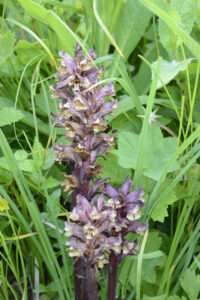
The corolla of these plants is 2-lipped, the upper lip compressed sideways, forming a helmet-like structure, or elongated into teeth or a beak, whereas the lower lip is usually broad, lobed, flat or curved.
The generic name is derived from the Latin pediculus (‘louse’). According to an old superstition, louseworts could transfer lice to people and cattle, or, according to another belief, the exact opposite was the case, namely that they were able to rid people and cattle of lice! In Denmark, a decoction of these plants was used to expel lice from clothes.
If you shake a lousewort capsule that contains ripe seeds, you may hear a rattling sound from the seeds, which has given rise to the popular name rattle of these plants.
Usually, animals do not graze on louseworts, as they contain poisonous glycosides. Nevertheless, in former times, children at various places in Great Britain would suck out the nectar of the flowers. In Donegal, the plant was known as honey-cap or honey-cup, and in Shetland as bee-sookies or hinney-flo’er.
This species is restricted to the south-western Alps, growing in grasslands on calcareous soils, at elevations between 1,800 and 2,600 m.
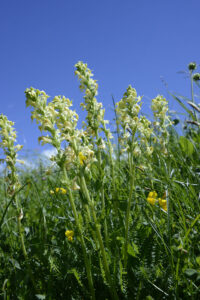
The stem grows to 35 cm tall, and the pale yellow flowers are arranged in a long, dense, terminal spike, which gave rise to the specific name.
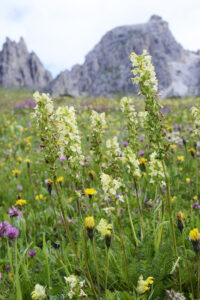
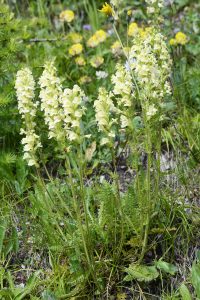
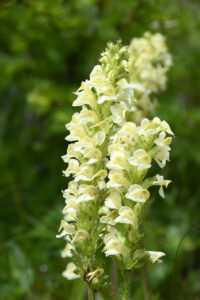
This plant grows in grass or other taller vegetation on calcareous soils, in the Alps found up to elevations around 2,000 m. It is distributed from the central Apennines eastwards to Slovenia, Croatia, Romania, and Ukraine, and thence northwards to Poland and Belarus.
The specific name was given in memory of Belsazar de la Motte Hacquet (c. 1739-1815), of French descent, professor of anatomy and surgery in Laibach (now Ljubljana). He wrote a book about the botany of the Carniola area, named Plantae alpinae carniolicae (1782).
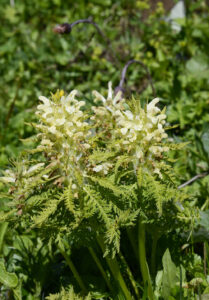
This species is restricted to the Alps, found from France eastwards to Austria and Slovenia. It thrives in calcareous grasslands, at altitudes between 1,000 and 2,700 m.
The specific name is Latin, meaning ‘skin’ or ‘surface’. It is not clear what it refers to.
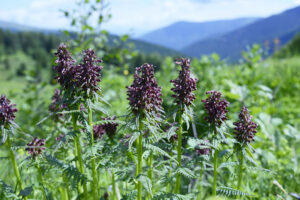
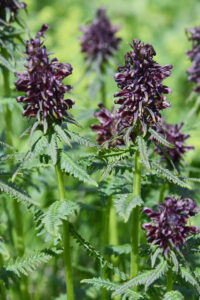
It is distributed in the Pyrenees and the Alps, eastwards to Austria and Slovenia, and in the Dinaric Alps, growing in grasslands at altitudes between 1,900 and 2,700 m. It is divided into two subspecies, the nominate rosea occurring from Liechtenstein and north-estern Italy eastwards, ssp. allionii from the Pyrenees eastwards to Switzerland and north-western Italy.
The specific name is Latin, meaning ‘rose-coloured’.
Subspecies allionii was named in honour of Italian physician and botanist Carlo Allioni (1728-1804), professor of botany at the University of Turin. His most important work was Flora Pedemontana, sive enumeratio methodica stirpium indigenarum Pedemontii, from 1755, a study of the plant life of Piedmont, listing 2,813 species, of which 237 were previously unknown.
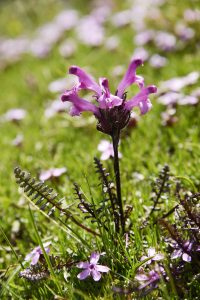
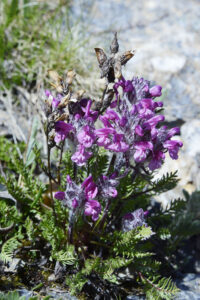
Plant to 20 cm tall, stem ascending, with 2 longitudinal lines of white hairs, leaves lanceolate in outline, twice pinnately divided, smooth, usually dark purple, to 9 cm long and 2 cm wide. The inflorescence is a short spike, bracts leaf-like, calyx bell-shaped, tubular, to 9 mm long, corolla to 2.2 cm long, bright pink, sometimes purple on upper lip, tube cylindric, a little longer than the calyx.
It is distributed from eastern Switzerland eastwards to the Julian Alps and the Carpathians, growing on limestone screes and in grassland, at altitudes between 1,200 and 2,800 m.
The specific name is derived from the Latin rostrum (‘beak’), caput (‘head’), and atus, an adjective-forming suffix, referring to the dense inflorescence, composed of beaked flowers.
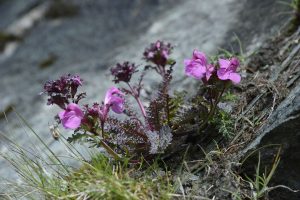
This plant grows in grasslands on calcareous soils, from eastern France eastwards to Austria and the northern part of the Balkan Peninsula.
The specific name is derived from the Latin rostrum (‘beak’), spica (‘spike’), and atus, an adjective-forming suffix, thus ‘spike with a beak’, referring to the long, slender, ‘beak’-like spike, composed of beaked flowers.
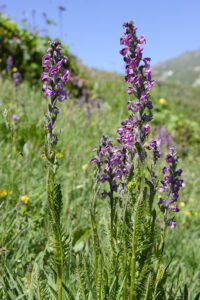
The distribution of this plant is almost circumpolar, from Scandinavia eastwards along the Russian Arctic coast to Alaska and north-western Canada. It is also native to mountains of Europe, from the Pyrenees across the Alps to the Carpathians and the Tatra Mountains, on the Balkans, and in Ukraine, Central Asia, China, and Japan. It is partial to calcareous soil, in central Europe growing at altitudes between 900 and 3,000 m, but in Central Asia found up to 4,400 m. It is very common in the Alps.
The specific name is Latin, meaning ‘with whorls’, referring to the leaf arrangement.
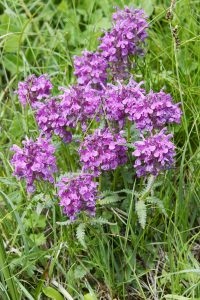
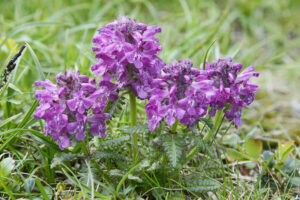
Many genera of the family have gorgeous flowers, including true poppies (Papaver, below), Himalayan poppies (Meconopsis), and horned poppies (Glaucium). Several true poppies are presented on the page In praise of the colour red, Himalayan poppies on the page Plants: Himalayan flora 2, horned poppies on the page Plants: Flora in Turkey.
Two groups of plants, which were formerly regarded as separate families, are now included in the poppy family, namely Fumariaceae, which includes corydalises, fumitories, and bleeding hearts, and Pteridophyllaceae, with only one genus and one species, Pteridophyllum racemosum, found in Japan.
According to Roman naturalist Pliny the Elder (23-79 A.D.), the generic name was the classical Latin word for the Moon. It was also used for poppies, referring to their round, moon-shaped petals.
Stems erect, hairy, to 20 cm tall, with a milky sap. The leaves are all basal, once or twice pinnate, bluish-green. In most subspecies, the flowers are yellow or orange, in a few white, initially nodding, later erect, to 5 cm across, petals 4.
It is divided into at least 8 subspecies, some of which are regarded as separate species by some authorities.
It was the first poppy species to be described, by Swiss physician and naturalist Conrad Gessner (see Doronicum above) in 1555.
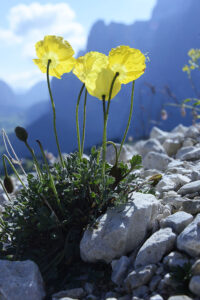
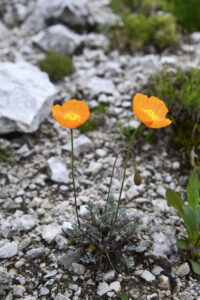
It has several stems, usually 30-60 cm tall, occasionally to 75 cm, with a yellow milky sap. The bright green or slightly bluish leaves are long-stalked, pinnately divided, lanceolate in outline, to 20 cm long, leaflets strongly serrated. Flowers are a distinct orange-yellow, to 8 cm in diameter, sepals shed shortly after the opening of the flower bud, petals 4.
Incidentally, this plant has been used since 2006 as the basis for the logo of Plaid Cymru (pronounced ‘Plyde Kumree’), a Welsh nationalist and social-democratic political party, which advocates for Welsh independence from the United Kingdom.
The specific name refers to Cambria, the classical Latin term for present-day Wales.
Initially, this plant was separated from the genus Papaver in 1814 by French botanist Louis Viguier (1790-1867), mainly based on the structure of its style. He called it Meconopsis cambrica, the generic name being the classical Greek counterpart of the Latin papaver, derived from mekon (‘moon’) and opsis (‘resembling’), likewise referring to the round petals of poppies.
However, a phylogenetic study from 2011 concluded that the Welsh poppy is in fact a member of Papaver, and the former name of the species, P. cambricum, which was published in 1753 by Swedish naturalist Carl Linnaeus (1707-1778), has been restored. (Source: J.W. Kadereit, C.D. Preston & F.J. Valtueña. Is Welsh Poppy, Meconopsis cambrica (L.) Vig. (Papaveraceae), truly a Meconopsis? New Journal of Botany, Vol. 1, 2011, pp. 80-88)
Today, Meconopsis poppies are restricted to central and eastern Asia. Several species are described on the page Plants: Himalayan flora 2.
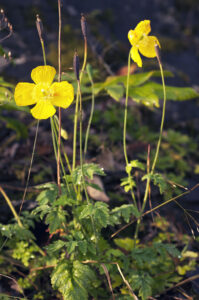
The leaves are linear, needle-like, and when falling they leave a scar. Mature female cones are woody, between 1.5 and 60 cm long, with numerous scales arranged in spirals, with 2 winged seeds on each scale. The male cones are small, 0.5-6 cm long, falling soon after pollination. Many species exude a sticky, fragrant resin.
The generic name is the classical Greek and Latin names of larches.
The specific name is derived from the Latin deciduus (‘falling down’), referring to the fact that this tree sheds its needles in autumn.
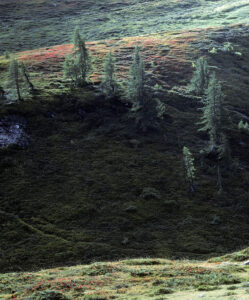
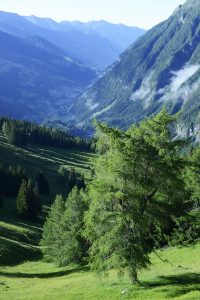
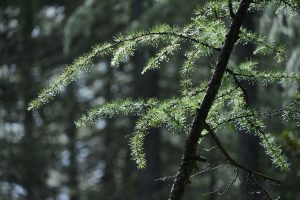
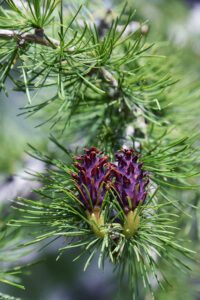

The generic name is the classical Latin word for pines, maybe originally stemming from Sanskrit pitu (‘sap’ or ‘resin’), alluding to the ample production of resin in this genus.
It is native to southern Europe, from the Pyrenees across the Alps to the Carpathians, and southwards to the Apennines in Italy, and to higher mountains of the Balkans. In the late 1700s and the 1800s, it was widely planted to stabilize sand dunes in Scandinavia, Finland, and the Baltic region, and has become widely naturalized there. In Scandinavia, it is regarded as an invasive plant.
Syrup can be made from boiling buds and young cones.
The specific name is the old Rhaetic name of this tree. Rhaetian was a Tyrsenian language, spoken in the region Rhaetia in the eastern Alps in pre-Roman times.
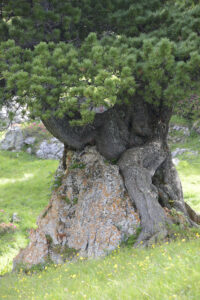
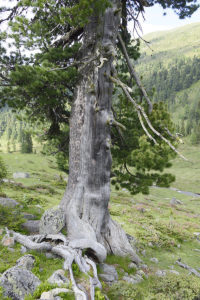
The pale to dark green needles are 4-24 cm long and 1.2-2.1 mm wide, depending on subspecies. Mature seed cones are to 10 cm long, with rounded scales. They ripen about 18 months after pollination.
Divided into 5 or 6 subspecies, this tree is distributed across southern Europe, from the Iberian Peninsula to Turkey and the Crimea, and also in the higher Atlas Mountains in Morocco and Algeria. It usually grows at elevations up to 1,600 m, but may occasionally be encountered up to 2,000 m.
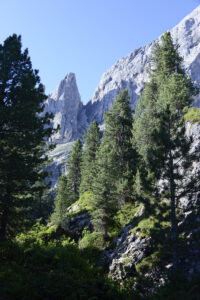
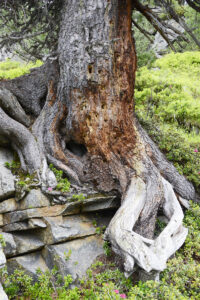
The generic name is derived from Ancient Greek khaino (‘I gape’) and rhinos (‘nose’), alluding to to gaping mouth and the rather short spur of these plants.
This plant is native to the northern part of the Iberian Peninsula, the Pyrenees, and the Balearic Islands, growing in rocky areas, mainly on limestone, and also on stone fences. In the Pyrenees, it may be found up to elevations around 2,600 m.
The specific name is Latin, meaning ‘with leaves like Origanum’ (oregano, or marjoram).
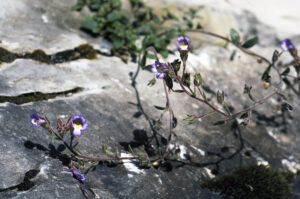
The generic name is the classical Latin name of these plants, originally digitalis herba, derived from digitus (‘finger’), thus ‘a plant relating to the finger’, alluding to the shape of the flower resembling a thimble.
Folk names of these plants include fairies’ glove, fairy caps, fairy thimbles, gloves of Our Lady, Virgin’s glove, witches’ gloves, bloody fingers, and dead men’s bells, all referring to the flower shape.
The role of foxglove in traditional medicine and folklore is related on the page Plants: Plants in folklore and poetry.
It is widely distributed in European mountains, including the Pyrenees, the French Massif Central, the Ardennes, the Vosges, the Jura, the Black Forest, the Alps, the Carpathians, the Dinaric Alps, and the Balkan Mountains, growing in forests and open areas up to altitudes around 2,000 m. It is also found at lower altitudes in eastern Europe, Turkey, and western Siberia.
In 1539, this species was called Campanula sylvestris flore luteo (‘yellow-flowered bellflower, growing in forests’) by German physician and botanist Hieronymus Bock (1498-1554), but in his herbal De Historia Stirpium Commentarii Insignes (‘Notable Commentaries on the History of Plants’), published 1542, German physician and botanist Leonhart Fuchs (see Allium schoenoprasum above) transferred it to the genus Digitalis, naming it D. lutea (‘yellow foxglove’).
The specific name is Latin, meaning ‘large-flowered’.
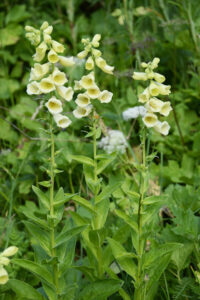
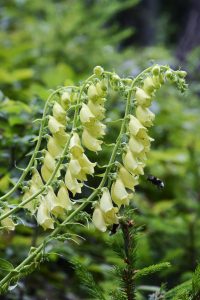
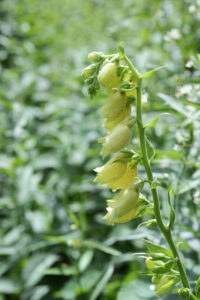
As their generic and popular names imply, the flowerheads are globular. The flower colour varies from blue to purple, violet, pink, or white.
Formerly, these plants constituted a separate family, Globulariaceae.
It is a dwarf shrub, rarely growing more than 10 cm high, which may be identified by the dark purple stems. Leaves are arranged in a rosette, lanceolate or oblong with a wedge-shaped to inverted heart-shaped base, rarely more than 3 cm, occasionally to 7 cm long, tip rounded, notched. Stem leafless, sometimes with a few scale-like leaves. Inflorescences are terminal, hemispherical heads with a diameter of about 1.2, sometimes up to 2 cm, pale blue or purplish-blue.
Despite the specific name, from the Latin cor (‘heart’) and folium (‘leaf’), the leaves are not really heart-shaped, but rather spatulate.
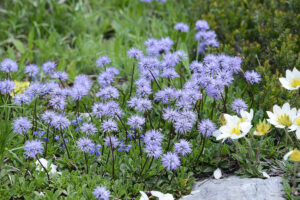
The leaves are all basal, much larger than in the previous species, growing to 10, occasionally 15 cm long. The flowerheads are also larger, to 2.5 cm across. The leafless stem may reach a height of about 25 cm.
The specific name is derived from the Latin nudus (‘naked’) and caulis (‘stem’), referring to the leafless stem.
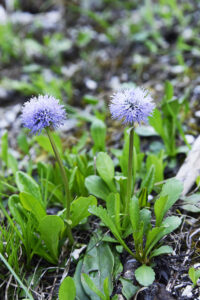
The generic name is derived from the Latin linum (‘linen’ or ‘flax’), thus ‘resembling flax’, alluding to the leaves of some species, which superficially resemble those of flax.
The toad part of the common name has various explanations. In his Herball (1597), English herbalist John Gerard (c. 1545-1612) says that the name was applied to these plants, because the flowers “be yellow, having a mouth unto a frog’s mouth.” Some 60 years later, English herbalist William Coles (1626-1662), in his work Adam in Eden, or the Paradise of Plants, claims that the name arose “because toads will sometimes shelter themselves amongst the branches of it.”
It is widespread in montane areas of central and southern Europe, from the Iberian Peninsula and the Pyrenees eastwards via the Jura Mountains, the Alps, and the central Apennines to the Balkan Peninsula. It grows in gravel and rocky areas, mainly on calcareous soils, at elevations between 1,200 and 4,200 m.
Due to the saffron-coloured spot on the lower lip, Swiss naturalist and physician Albrecht von Haller (1708-1777) compared the flower to a bird, made of amethyst and with a golden beak.
In the southern part of Austria, a folk name of this species is Löwenmaul (‘lion’s mouth’), alluding to the gaping flowers. In Kärnten, Austria, a traditional name is Stanklitter, dialect of Steinkletterer (‘stone climber’) – an apt name for the plant. In the old days, it was believed that it would protect a person against witches and charlatans.
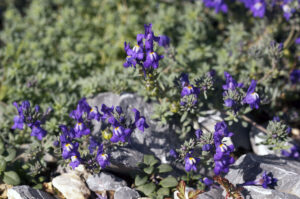
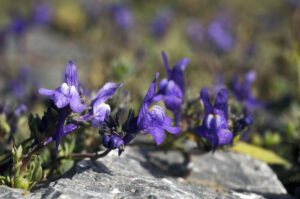
This species is found in the Pyrenees, the Iberian Peninsula, Corsica, Italy, and North Africa, growing among rocks, on slopes, in coastal dunes, pastures, and fallow fields, on calcareous as well as acid soils, from sea level up to elevations around 2,600 m. In the Alps, it is restricted to a few locations in southern Switzerland, and a small area in the Bergamasque Alps north of Milan.
The specific name is Latin, meaning ‘lying down on your back’, presumably referring to the creeping or ascending stems.
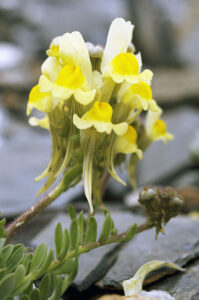
The generic name is a Latinized version of Ancient Greek paiderota, which, by Greek physician, pharmacologist, and botanist Pedanius Dioscorides (died 90 A.D.), and also by Roman naturalist Pliny the Elder (23-79 A.D.), was used for a species of Acanthus. Pliny also used the name for chervil (Anthriscus cerefolium). Why it was applied to this genus by Swedish naturalist Carl Linnaeus (1707-1778) is not known.
Some authorities place these plants in the genus Veronica (below), but they differ by the much longer corolla, which has two distinct lips.
This plant has a scattered occurrence in the central and eastern Alps, from the Bergamasque Alps north of Milan eastwards to Austria and northern Slovenia. It is restricted to areas with the mineral dolomite, usually growing at elevations between 1,500 and 2,600 m.
The specific name was applied by Italian botanist Pier Antonio Micheli (1679-1737), professor of botany in Pisa, curator of the Orto Botanico di Firenze, who was a leading authority on cryptogams (plants reproducing by spores), and discovered the spores of mushrooms. The name honours Filippo Buonarroti, in Latinized form Philippus Bonarota (1661-1733), a Florentine archaeologist and senator who supported the publication of Micheli’s work Nova plantarum genera iuxta Tournefortii methodum disposita (1729).
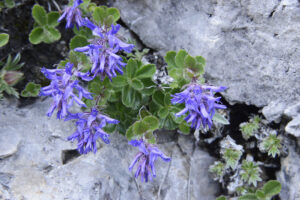
This plant is found in two separate areas, in north-eastern Italy, southern Austria, and northern Slovenia, and also in the southern Dinaric Alps, in Herzegovina. It grows in rocky areas on calcareous soils, at altitudes between 1,000 and 2,500 m.
The specific name is Latin, meaning ‘yellow’.
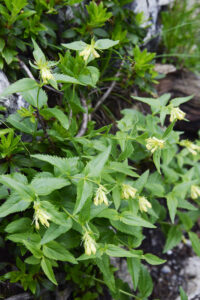
The generic name is Medieval Latin for ‘vineyard’. Presumably, some plantain species were observed growing in vineyards as weeds.
This plant is partial to calcareous soils, growing in grasslands, along roads, and in waste places, from sea level up to altitudes around 2,000 m. Its native range is from almost the entire Europe eastwards to the Siberian Pacific coast, southwards to the Mediterranean, Iraq, Iran, and north-eastern China. It has also been introduced elsewhere, in particular the north-eastern United States.
The specific name is Latin, meaning ‘of medium size’, presumably compared to the greater plantain (P. major), whose name means ‘larger’. However, they are of equal size.
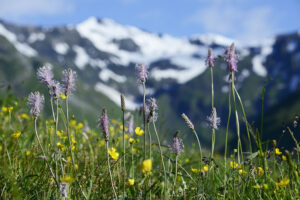
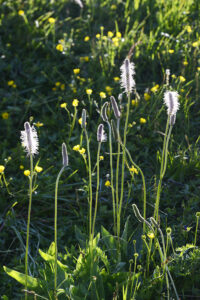
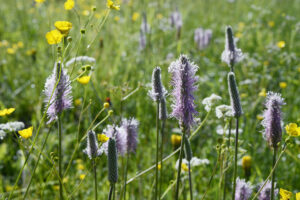
The generic name probably refers to the Biblical Veronica, who, according to legend, wiped the face of Jesus on his way to Golgotha. The flowers supposedly resemble the markings left on the cloth which was used. The common name is Old English, meaning ‘to thrive’, referring to the vigorous growth of many Veronica species.
The role of these plants in folklore and traditional medicine is described on the page Plants: Plants in folklore and poetry.
This species grows in humid meadows, along streams, in areas of newly melted snow, and among rocks, at altitudes between 1,400 and 2,900 m. It is very widely distributed in arctic and subarctic regions, from Canada eastwards to central Siberia, in montane areas in the British Isles, and central and southern Europe, eastwards to Ukraine, and also in western Himalaya and Tibet.
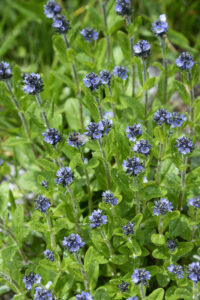
The native range of this species is subarctic areas of Greenland, Iceland, Norway, Sweden, Finland, and north-western Russia, and also montane areas of central and southern Europe. It grows on stony slopes and in alpine grasslands, in the Alps occurring at elevations between 300 and 3,100 m.
The specific name is Latin, meaning ‘shrubby’, alluding to the often woody lower stem.
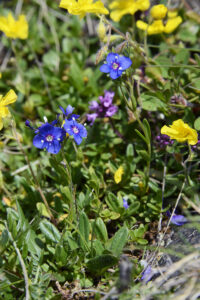
The inflorescence is a terminal, dense spike, to 30 cm long, sometimes with lateral spikes in the upper leaf axils. Bracts and sepals linear, glandular-hairy, corolla pale blue or bright blue, sometimes pink, purple, or white, to 7 mm long, with 4 lanceolate, unequal lobes, stamens almost as long as the corolla.
It grows in sunny places in dry grasslands, dunes, and shrubberies, and in sandy, gravelly, and rocky areas, usually on nutrient-poor, humus-rich soils. Its native range is from almost all of Europe eastwards to central Siberia, and thence southwards to the Caucasus and Xinjiang, in the southern areas mainly growing in mountains. In the Alps, it occurs up to elevations around 2,100 m.
The specific name is derived from the Latin spica (‘spike’), alluding to the inflorescence.
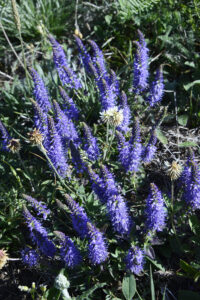
This species grows in open forests, shrubberies, and grasslands, and among rocks, preferably on calcareous soils. It is distributed in central and southern Europe eastwards to western Siberia, the Altai, and Mongolia, southwards to the Mediterranean and Kazakhstan.
The specific name means ‘resembling Teucrium’ (germander). It is not clear in what respect.
Some authorities regard it as a subspecies of the Austrian speedwell (V. austriaca).
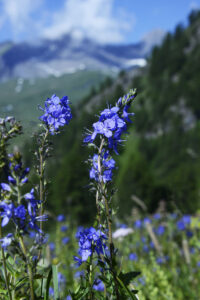
The native range of this species is mountains of central and southern Europe, including the Pyrenees, the French Massif Central, and the Alps, eastwards to Ukraine. It grows in forests and grasslands on calcareous soils.
The specific name is Latin, meaning ‘with nettle-like leaves’.
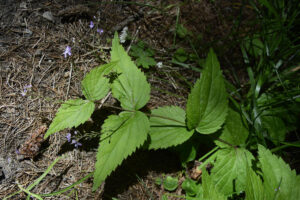
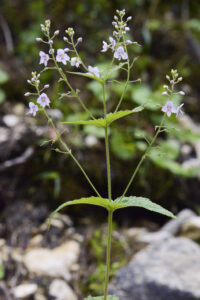
The generic name is probably of Celtic stock, from ar (’near’) and mor (’sea’), alluding to the fact that common thrift (A. maritima) usually grows near the sea. In his Commentarii de Bello Gallico (‘Notes on the Gallic War’), Roman emperor Gaius Julius Caesar (100-44 B.C.) mentions an area between the rivers Seine and Loire, which he calls Aremorica. Presumably, thrift was growing here. The Old French name of the plant, armoires, became Latinized as armerios in 1537, later written Armeria. (Source: J. Corneliuson 1997. Växternas namn. Vetenskapliga växtnamns etymologi. Språkligt ursprung och kulturell bakgrund. Wahlström & Widstrand)
It occurs in montane areas, from the Pyrenees eastwards to the Carpathians and the Balkans. It is particularly common in the southern Alps, thriving in grassy and stony areas at elevations between 1,100 and 3,200 m.
In eastern Austria, this plant was formerly used for treatment of consumption.
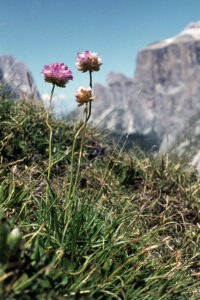
The flower structure of these plants is unique. Of a total of 6 sepals, 4 are small and green, whereas the 2 larger lateral ones are coloured like the petals, wing-like, almost enveloping the entire flower. The 8 filaments are fused to form a tube, and united with this tube are 2 tiny petals, one on either side. The third petal is larger, fringed, forming a boat-like structure on the underside of the flower. It serves as a ‘landing place’ for visiting insects, such as bees and butterflies.
The generic name is derived from Ancient Greek polys (‘many’ or ‘much’) and gala (‘milk’), alluding to an old belief that these plants would increase milk yield in cattle.
This species grows in open woods, grasslands, heaths, and dunes, on calcareous or slightly acid soils, from sea level up to about 2,200 m. It is distributed in almost all of Europe, eastwards to western Siberia, southwards to the Mediterranean and Turkey.
The specific name is Latin, meaning ‘common’.
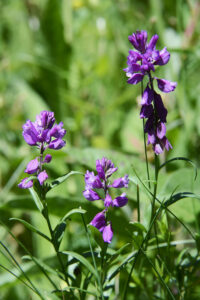
The name is derived from Ancient Greek polys (‘many’) and gony (‘knee’ or ‘joint’), alluding to the swollen nodes on the stems of many species. In numerous species, the stipules are fused into a stem-clasping sheath.
The word polygonon was used as a plant name as early as the 1st Century A.D. by Greek physician, pharmacologist, and botanist Pedanius Dioscorides (died 90 A.D.), who was the author of De Materia Medica (5 volumes dealing with herbal medicine).
A large number of species of this family are described on the page Plants: Knotweed family.
The generic name is derived from the Latin bis (‘twice’) and tortus (‘twisted’), like the English name snake-root referring to the twisted appearance of the rhizome of B. officinalis (below).
It is widespread in temperate areas of central and southern Europe, including the British Isles, eastwards to the Pacific, southwards to Morocco, Iran, and southern China. It is also a common escape in North America. In southern Europe, it is restricted to mountains. It is very common in the Alps, growing in meadows and pastures, at forest edges, and along trails, up to altitudes around 2,100 m.
Fresh leaves are a valuable fodder, whereas they crumble if they are preserved as hay. The leaves were also formerly cooked as a vegetable. The rhizome contains an edible starch.
The specific name is derived from the Latin officina (‘workshop’ or ‘office’), and the suffix alis, thus ‘made in a workshop’. However, in a botanical context, the word denotes plants species that were sold in pharmacies due to their medicinal properties.
In Germany, the rhizome of this species was sold under the name radix bistortae offizinell (‘twice twisted medicinal root’), and in powdered form it was used as a remedy against diarrhoea, dysentery, bleeding from the intestines, wounds in mouth and throat, and pharyngitis.
In Germany, the twisted rhizome gave rise to the popular name Schlangenwurtz (‘snake root’), and it was believed that destilled water from it could cure snake bite.
Popular names of this plant include meadow bistort and pudding grass, the latter referring to an old usage of the leaves in northern England as an ingredient in a bitter Lent pudding, together with other herbs, oatmeal, and eggs.
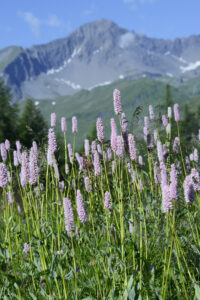
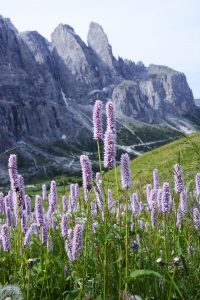
It is widely distributed in subarctic and temperate areas of the Northern Hemisphere, southwards to Arizona, Spain, the Caucasus, the Himalaya, and northern Indochina. In the Alps, it occurs at altitudes between 1,000 and 3,100 m, whereas in the Himalaya it may be encountered up to elevations around 5,000 m.
In Nepal, the root is used for fever, seeds for cough and infections. The seeds are roasted and pickled.
The specific name is derived from the Latin vivus (‘alive’) and pario (‘I bear’, i.e. offspring), alluding to the bulbils in the lower part of the spike.
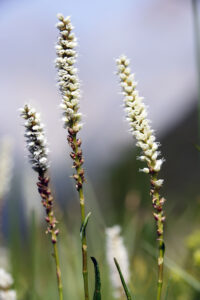
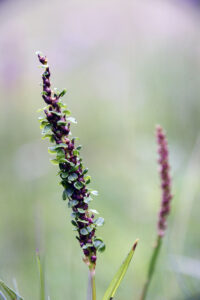
The fruit is mostly a triangular nutlet, often winged, arranged in dense clusters, often conspicuously reddish-brown when ripe.
Dock is an old term applied to various plants with large leaves, whereas sorrel is a brownish-orange to pale chestnut colour, referring to the fruits of this genus.
Shortly after the snow has melted, the yellowish-green to copper-red young leaves grow from the rhizomes. They become very large and long-stalked, blade heart-shaped or ovate, smooth, to 50 cm long, with wavy margin, stem leaves smaller, alternate, oblong or lanceolate. The stipules form a sheath around the stem.
The inflorescences are much-branched, dense, terminal compound panicles with hundreds of tiny greenish flowers. The fruit is a reddish-brown, triangular, winged nutlet, which may remain viable for more than 10 years.
It is native to mountains of central and southern Europe, as well as Ukraine and Turkey, eastwards to the Caucasus and north-western Iran. It grows in all kinds of open areas on nutritious soils, in the Alps found up to elevations around 2,600 m.
A popular name of this plant is monk’s rhubarb, alluding to the leaves, which are edible, raw or cooked. They make an excellent spinach, and in Germany Sauerkraut (sour cabbage) is made from them.
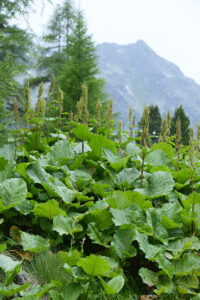
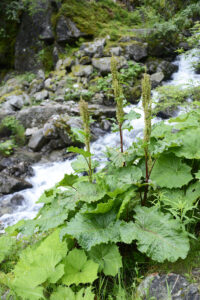
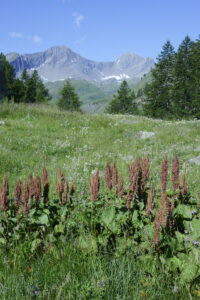
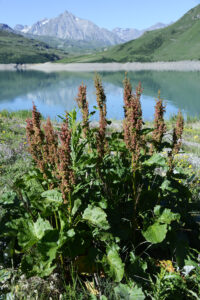
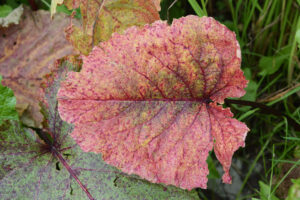
The generic name is derived from Ancient Greek andros (‘male’) and sakos (‘shield’), presumably alluding to the leaf shape of many of the species. In German, this is directly translated to Mannsshild. Originally, the name was probably applied to an alga of the genus Acetabularia (family Polyphysaceae), by Greek physician, pharmacologist, and botanist Pedanius Dioscorides (died 90 A.D.), and also by Roman naturalist Pliny the Elder (23-79 A.D.), presumably due to the shape of the ‘cap’ of these algae. The name was transferred to the rock-jasmines by Italian physician and naturalist Pietro Andrea Gregorio Mattioli (1501-1577).
The common name alludes to the flowers resembling jasmines.
This species occurs in the Alps, Apennines, Sudetes, Carpathians, and in mountains on the Balkan Peninsula, growing on acid soils at altitudes between 1,500 and 3,500 m.
The specific name is derived from the Latin obtusus (‘blunt’) and folium (‘leaf’).
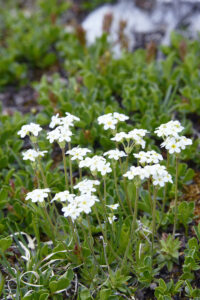
According to Greek scholar and botanist Theophrastos (c. 371-287 B.C.), Cyclamen species were an ingedient in love potions, but later its effect as an aphrodisiac was limited to apply to cattle. In the Middle Ages, they were utilized to treat liver problems, arthritis, and lumbago, and to this day they have been used for liver ailments.
The Ancient Greeks and Romans claimed that if cyclamen was planted near your house, you were protected against toxic concoctions, and as a magic herb it was able to calm down excited souls.
The generic name stems from Ancient Greek kyklaminos, probably derived from kyklos (‘circle’), referring to the round tuber of these plants. Incidentally, the tuber is edible. It is also much relished by pigs, reflected in the popular names sowbread and swinebread, translated from Medieval Latin panis porcinus (‘swine bread’).
It is easily identified by the bluish-green, rounded leaves with numerous irregular, whitish streaks, and the deep pink, purplish, or cyclamen-coloured flowers with strongly back-curved lobes, to 2.5 cm long.
The specific name is Latin, meaning ‘somewhat purple’, referring to the flowers.
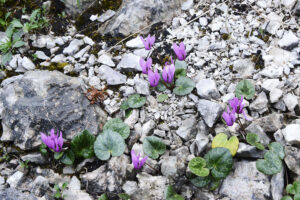
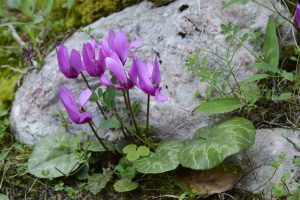
The leaves of these plants are arranged in a basal rosette, and the flowers are usually in terminal umbels on a leafless stalk. The petals are usually fused, forming a tube with 5 terminal, spreading lobes.
A large number are very hardy, reflected in the generic name, which is a diminutive of the Latin prima (’first’), referring to the early flowering of several species. The common name primrose is derived from the Latin prima rosa, meaning ‘the first rose’, although primroses are not even distantly related to roses.
According to some authorities, the name cowslip is a corruption of an Old English word, cuslyppe (‘cow dung’). This probably refers to the favoured habitat of the common cowslip (P. veris), namely dry slopes, grazed by cattle. Others claim that the word is a corruption of cow’s leek, derived from the Anglo-Saxon word leac (‘plant’).
It has been said that the name oxlip, which is a corruption of ox and slip, refers to the fact that oxlip, like cowslip, often grows on cattle grazing grounds. This may be a wrong presumption, as true oxlip (below) – at least in the northern part of its distribution area – mainly grows in forests.
The role of these plants in traditional medicine and folklore is related on the page Plants: Plants in folklore and poetry.
True oxlip is distributed in the major part of Europe, northwards to Denmark and southern Sweden, and in northern Asia, eastwards to the Altai Mountains, southwards to the Caucasus, Turkey, and northern Iran. It grows in forests and damp grasslands, and along streams.
The specific name is Latin, meaning ‘taller’, i.e. taller than the widespread and common P. veris, which is described in depth on the page Plants: Plants in folklore and poetry.
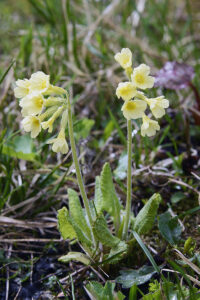
It grows in alpine grasslands and areas of snowmelt on acidic soils, at elevations between 2,000 and 3,200 m. It is distributed in the central and eastern Alps, and in the northern part of the Balkan Peninsula.
The specific name is Latin, meaning ‘sticky’.
It forms a confusing variety of hybrids with P. minima (below).
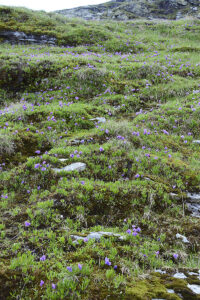
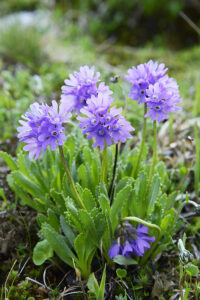
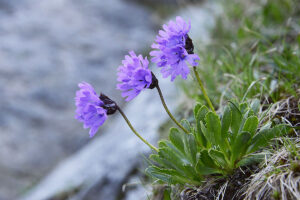
It is distributed from Austria westwards to the French Alps and the Pyrenees, growing on acid soils, mainly along streams and in snow-melt areas, at elevations between 1,100 and 3,100 m.
The specific name is derived from the Latin integer (‘entire’) and folium (‘leaf’).
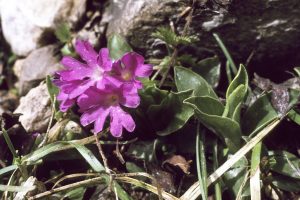
However, recent genetic studies have split it into two separate species, the western P. auricula, and the eastern and southern P. lutea, by some authorities named P. balbisii. The latter mainly grows at elevations between 1,000 and 2,900 m.
Collectively, these plants are known as bear’s ear, alluding to the shape of the leaves. They are the source of a huge number of primrose cultivars.
Yellow mountain cowslip is easily identified by the bright yellow flowers and the dull-green, broadly obovate, thin leaves, strongly serrated along the margin, and covered in glandular hairs. The leaf blade of P. auricula is usually narrower, almost lanceolate.
Both species were previously much utilized in traditional medicine for treatment of lung problems, cough, and wounds. It was believed that tea, brewed on plants collected on the Day of Ascension of Christ, would help against epilepsy, and powder made from plants picked on Walpirgis Day (May 1) would cure various diseases in cattle. These plants would not only make dizziness disappear in hunters, but also in their prey, the chamois (Rupicapra rupicapra) !!
The specific name is Latin, meaning ‘yellow’.

It is quite common in the eastern half of the Alps, and also in the Tatras, the Carpathians, and the northern Balkans, eastwards to Ukraine, growing in scree and snowmelts, usually on acid soils, at altitudes between 1,200 and 3,000 m.
The specific name is Latin, meaning ‘small’.
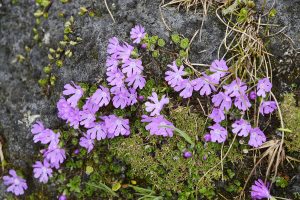
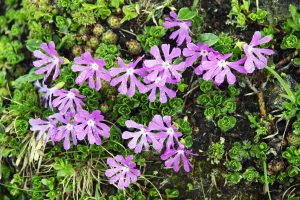
According to folklore in the Salzburg area, Austria, the Devil once wanted to obtain a bellflower, but had a hard time finding one. Instead, he came back with a flower that was less blue than the bellflower and had a jagged, torn-looking crown: the snowbell – hence the local Salzburg names Teufelsglockenblume (‘Devil’s bellflower’) or Falsche Glockenblume (‘false bellflower’).
Swiss folk names include Rossgleggli (‘little horse bell’) and Geissgleggli (‘little goat bell’) – not very flattering names either!
The generic name is a diminutive of the Italian word soldo (‘coin’), thus ‘little coins’, referring to the leaf shape of most species of this genus. Initially, the name was applied by botanists in the 1500s to the sea bindweed (Calystegia soldanella) due to the circular leaves of that plant. However, in 1583 the name was transferred to the snowbell genus by Flemish physician and botanist Charles de l’Écluse (1526-1609), also called Carolus Clusius, who was among the first to study the Alpine flora.
The common name refers to the early flowering of these plants, which often appear in depressions, shortly after the snow has melted.
Leaves are all basal, long-stalked, leathery, blade round or kidney-shaped, to 3 cm across, margin entire. Young leaves are glandular-hairy, later smooth. Flowering stems are to 15 cm tall, inflorescences few-flowered, corolla purple, to 1.5 cm long, funnel-shaped, deeply fringed. The latter character distinguishes it from most other snowbells.
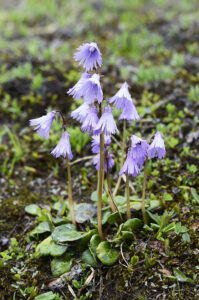
It is distributed in the eastern Alps, in south-eastern Germany, Austria, Italy, and Slovenia, growing on calcareous soils in grassy areas and on limestone rocks, at elevations between 1,700 and 2,850 m. An endemic subspecies, samnitica, is restricted to Majella National Park in the Abruzzo Mountains of Italy.
The specific name is Latin, meaning ‘small’.
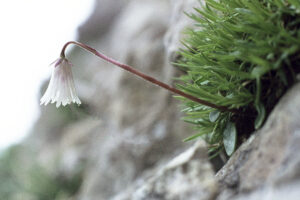
The dark or pale purple flowers are more bell-shaped than in the previous two species, and the margin is only slightly fringed.
The specific name is Latin, meaning ‘very small’.
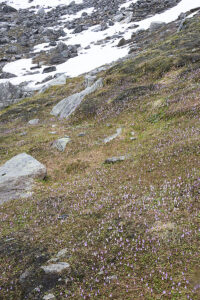
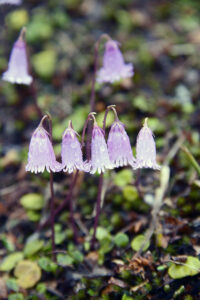
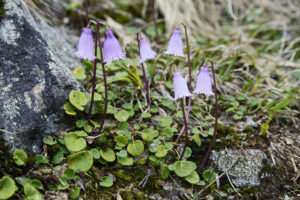
The flower structure of these plants is unique, with 5 coloured sepals, the upper ones forming an erect hood, and 2-10 inner petals, 2 of which have nectar-producing spurs hidden under the hood. The fruit is a follicle, which is pod-like, but at maturity splitting along one side only.
The major part of the species are deadly poisonous, even in small dosages. In the old days, the poisonous juice of aconite species was applied to hunting arrows all over Eurasia, and it was also applied to arrows and spears during wars. In some areas, it was utilized to eliminate criminals.
The generic name refers to the mountain Akonitos, near the Black Sea, where the Greek hero Heracles went to the underworld Hades to bring up its guardian, the three-headed dog Kerberos. As he tugged this terrible animal out of Hades, its froth fell on the ground as drops, from which aconite sprouted – a figure of the extreme toxicity of the genus.
The common names monkshood and helmet flower refer to the flower structure (see above), whereas wolfsbane is explained below under yellow wolfsbane.
The role of these plants in traditional medicine and folklore is related on the page Plants: Plants in folklore and poetry.

In Europe it has a scattered occurrence, found in montane areas of the Iberian Peninsula, the Pyrenees, the Corbières, the Jura, the southern Alps, and mountains in the Balkans. It is commonest in Spain and the Pyrenees, rare in the Alps, where it is restricted to southern limestone areas. It grows from the lowlands up to altitudes around 2,000 m.
The specific name is derived from Ancient Greek anti (‘against’) and thora, referring to an old belief that this plant could be used as an antidote against poisoning from the toxic Ranunculus thora.
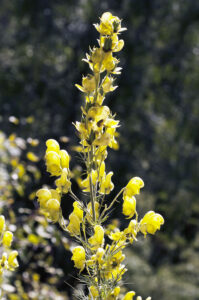
The nominate subspecies, called northern wolfsbane, is common in Scandinavian mountains and into the northernmost parts of Russia. Its flowers are purple, blue, or sometimes yellow. It was previously regarded as a separate species, A. septentrionale.
Subspecies vulparia occurs in central Europe, from the Pyrenees eastwards to the Carpathians. It is very common in the Alps, being most common from the lowlands up to altitudes around 2,100 m, but occasionally encountered up to 2,400 m.
Subspecies neapolitanum is found in southern Europe. It has pale yellow flowers.
Subspecies lasiostomum occurs in Romania, Ukraine, the Baltic States, and western Russia. Its flowers are dark yellow or pale yellow.
Subspecies moldavicum has pale purple flowers. It is distributed in Poland, Slovakia, Hungary, Romania, western Ukraine, and western Russia.
The specific name refers to lycoctonine, an alkaloid found in these plants. This name is derived from Ancient Greek lykos (‘wolf’), alluding to the fact that this alkaloid was utilized to kill wolves, hence the popular name wolfsbane. The wolves were killed, either by shooting them with arrows smeared in aconite juice, or by placing stakes, smeared in the juice, in trenches, in which a bait was present. The subspecific name vulparia, from the Latin vulpes (‘fox’) indicates that foxes were killed in a similar way.

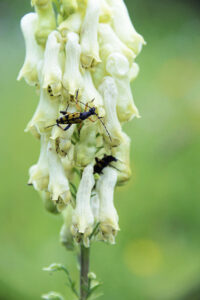
It is native from the British Isles, France, and Spain eastwards to Poland, Ukraine, and the northern part of the Balkan Peninsula, but has been widely introduced elsewhere as a garden plant and often becomes naturalized. It is quite common in the Alps and the Pyrenees, growing up to altitudes around 2,400 m.
In Middle Age Europe, witches reputedly used an extract from this species during their ‘flying’ ceremonies.
The specific name was the Medieval Latin name of monkshood, but also of some variety of turnip (Brassica napus).
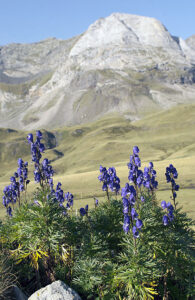
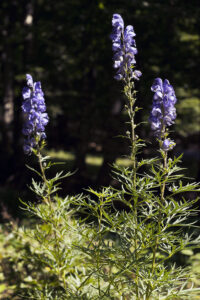
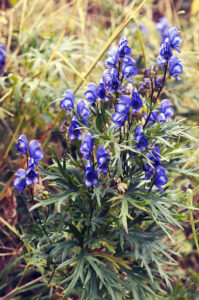
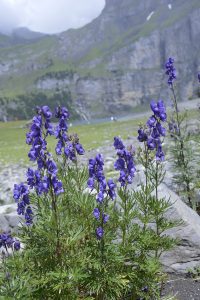
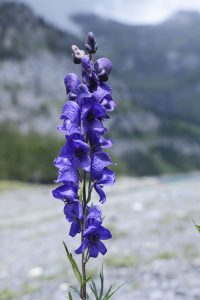
The name anemone is often linked to the Ancient Greek word anemos (’wind’), and windflower is a common English name of these plants. The connection, however, is hard to see, and, as indicated below, it is probably a wrong assumption.
According to Philip K. Hitti, in his book History of Syria including Lebanon and Palestine (1951), the Arabic name of the crown anemone (A. coronaria) is shaqa’iq an-Nu’man, which literally translates as ‘the wounds, or pieces, of Nu’man’. Nu’man probably refers to the Sumerian god of food and vegetation, Tammuz, whose Phoenician name was Nea’man. It is generally believed that the Arabic an-Nu’man became anemos in Ancient Greek, and that Tammuz was adopted by the Greeks as Adonis, who died of his wounds while hunting wild boar, and was transformed into a blood-red flower, stained by his blood. In the Near East, the crown anemone is often of the blood-red variety.
Lately, many species have been transferred to the genera Eriocapitella, Anemonoides, and Anemonastrum by Kew Gardens. This is a bit of a mystery to me, and, for the time being, I retain the old systematics.
Seven species are encountered in the Alps, of which 3 are widespread in Europe: wood anemone (A. nemorosa), yellow anemone (A. ranunculoides), and snowdrop anemone (A. sylvestris). These, and other anemones, are described on the page Plants: Anemones and pasque flowers.
A very widespread plant, found from the Pyrenees, the Alps, and the Apennines eastwards to Central Asia and Siberia, and thence southwards to the Caucasus, northern Pakistan, and Korea. It also extends into north-western North America, southwards to central British Columbia, with isolated occurrence on Vancouver Island and in mountains of Wyoming and Colorado.
It grows in grasslands and open woods, along roads, and among rocks, preferably in moist areas on calcareous soils. In the Alps, it may be encountered at altitudes between 500 and 2,500 m, in the Caucasus up to 3,800 m, in Central Asia and North America to 4,000 m.
Medicinally, narcissus-flowered anemone has been utilized by the Aleuts to stop bleeding.
The specific and popular names refer to the flowers, which somewhat resemble those of poet’s daffodil (Narcissus poeticus).
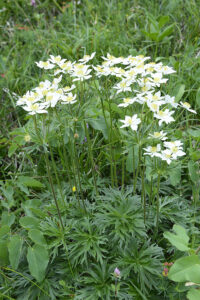
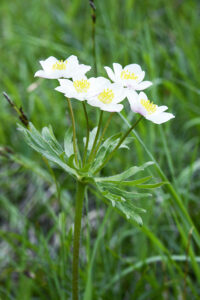
It is thought to be one of the most ancient of the group, formerly having a much wider distribution across Europe than today, where it occurs in four separate areas: northern Portugal and Spain, the eastern and southern Alps and the Apennines, the Carpathians, and finally Finland. In the latter area, it was noticed as late as 1929, and some authorities speculate that it was intentionally brought to Finland and planted by horticulturists.
The specific name is Latin, meaning ‘with 3 leaves’, referring to the leaflets.
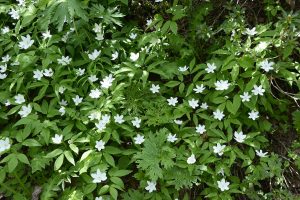
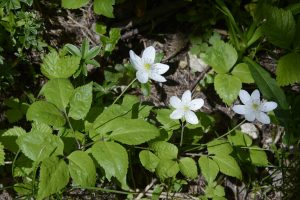
They are characterized by the peculiar shape of their flowers, each of the 5 petals having a spur, pointing backwards, and curved in many species. The petals alternate with 5 narrower and smaller sepals, usually of the same colour as the petals. The leaves are tripartite, with blunt lobes. The upper stem leaves are small, bract-like.
The generic name was first used by Swiss botanist Gaspard Bauhin (see genus Cirsium above), when he described the Alpine columbine (below). It is derived from the Latin aqua (‘water’) and legere (‘to collect’), thus ‘water jar’, referring to the shape of the flower.
Another interpretation claims that it is derived from the Latin aquila (‘eagle’), where the spurs are likened to eagle claws.
The common name columbine is derived from the Latin columba (‘dove’), referring to the alleged resemblance of the inverted flower to five doves, clustered together. Another popular name is granny’s bonnet, again referring to the flower shape.
As mentioned above under genus name, it was first described by Gaspard Bauhin, who called it Aquilegia montana magno flore (‘mountain columbine with large flowers’) – an apt name, as its flowers are the largest among the European species of the genus.
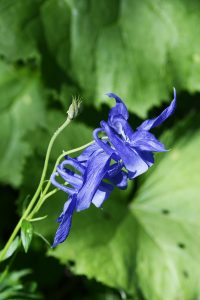
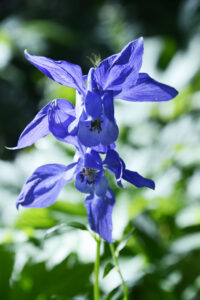
It is common in the Alps and the Apennines, from the lowlands up to altitudes around 2,000 m, growing in forests and grasslands, mainly on calcareous soils.
The specific name is derived from the Latin ater (‘dark’ or ‘black’), alluding to the dark flowers.
Some authorities treat this species as a subspecies, atrata, of the common columbine (A. vulgaris).
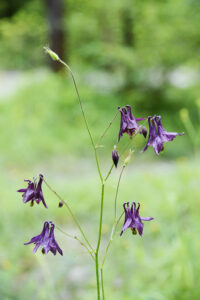
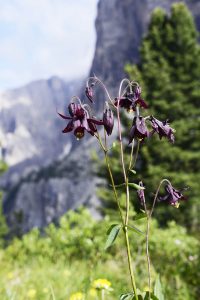
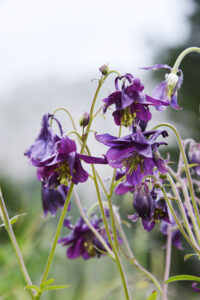
The specific name was given in honour of German physician and botanist August Max Einsele (1803-1870), who discovered the plant in 1847.
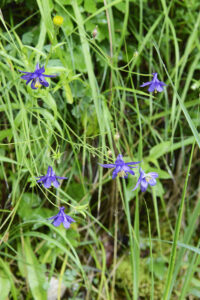
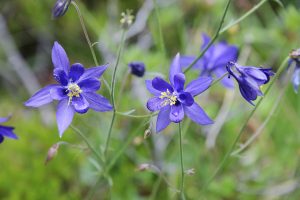
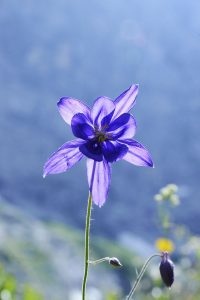
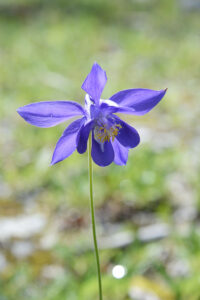
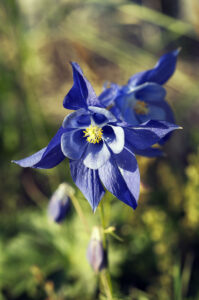
Roman naturalist Pliny the Elder (23-79 A.D.) states that “Caltha is a plant with yellow flowers.” The word is possibly derived from Ancient Greek kalthe (‘of yellow colour’).
Flowers appear early in spring, but blooming may also take place later in the summer, especially at higher elevations. Self-pollination occurs in rainy weather, as the flowers fill with water, and anthers and stigma are at the same height. The plant may also spread by rooting at the nodes.
As its specific and common names imply, this is a plant of marshy areas, in meadows, ditches, wet forests, and along streams. Its distribution is circumpolar in subarctic and temperate areas, southwards to Oregon, South Carolina, the Mediterranean, Iran, and northern Indochina. In the Alps, it occurs up to elevations around 2,100 m.
The specific name is derived from the Latin palus (‘swamp’), alluding to its preferred habitat.
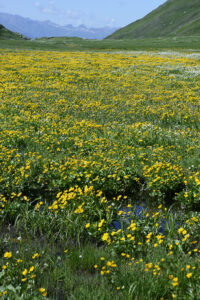
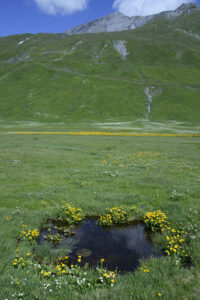
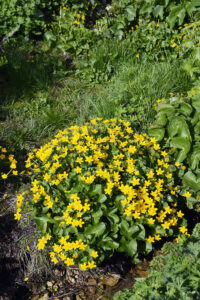
These plants climb due to the sensitivity of the leafstalks which, when touching another plant or something else, start twisting, curling around the object.
The generic name is derived from Ancient Greek klema (‘climber’).
Divided into several subspecies, it is distributed from central, eastern, and north-eastern Europe across northern Asia to Kamchatka, Korea, and Japan. In the Alps, it occurs at altitudes between 600 and 2,350 m.
It contains the toxic protoanemonin, which may cause reddening and itching of the skin.
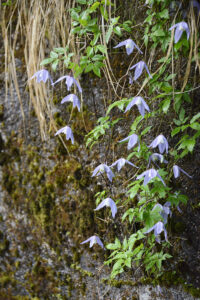
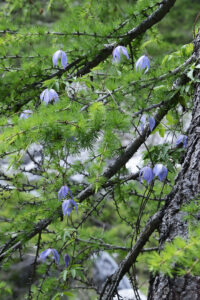
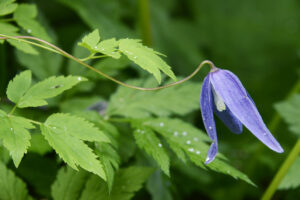
This pioneer plant grows in open forests, shrubberies, and fallow lands, especially on nitrogen-rich soils. It is distributed in central and southern Europe, North Africa, and the Middle East, eastwards to Afghanistan. Elsewhere, it is widely cultivated, often escaping to form naturalized growths. In New Zealand, it has been declared an unwanted organism.
In the Alps and the Pyrenees, it may be encountered up to elevations around 1,300 m.
It contains the toxic protoanemonin, which may cause reddening and itching of the skin. In the past, beggars smeared juice of the leaves on the skin to cause ulcerations, which might arouse pity in people. In Tuscany, spring sprouts were formerly used in a certain kind of omelettes, called vitalbini, which was maybe not so wise due to its toxicity.
Baskets were produced from the tough stems. In the Alps, in former days, children would smoke dry stems as cigarettes.
The specific name is the Italian name of the plant. In England, the name traveller’s joy was given in allusion to the profusion of feathery seedheads of this plant in the dark months leading up to Christmas. The name old man’s beard also refers to the seedheads. An old German folk name was Teufelzwirn (‘devil’s twine’), referring to its toxicity.
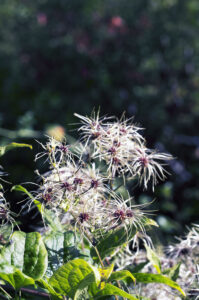
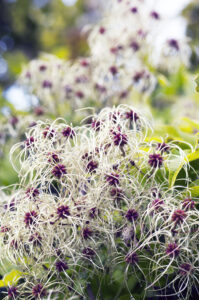
The generic name is derived from Ancient Greek helleboros, which was the word used for the Lenten rose (H. orientalis), possibly constructed from the words helein (‘to injure’) and bora (‘food’), presumably referring to the toxicity of this plant, which is described on the page Plants: Flora in Turkey
It is native to the Alps, the Apennines, and the Dinaric Alps in the northern part of the Balkan Peninsula, but is widely cultivated elsewhere. In the Alps it grows up to elevations around 1,850 m.
It is among the earliest flowering plants of the Alps, sometimes appearing as early as January, hence the popular German name Schneerose (‘snow rose’). It is not even distantly related to roses, but in the old days many plants with beautiful flowers were referred to as ‘roses’.
The specific name is derived from the Latin niger (‘black’), referring to the colour of the root.
The role of this plant in folklore and traditional medicine is described on the page Plants: Plants in folklore and poetry.
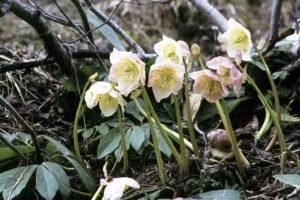
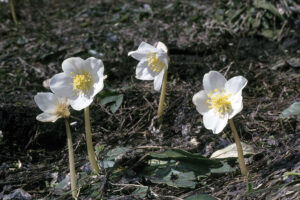
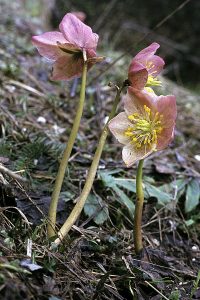
These plants are widely distributed in subalpine and temperate regions of the Northern Hemisphere, southwards to southern United States, the Mediterranean, Pakistan, southern China, and Japan.
The generic name is derived from the Latin pulsare (’to beat’), probably referring to the seed hairs, which are easily moved back and forth by the wind. The epithet pasque is derived from the Latin pascha, a corruption of the Ancient Greek paskh, which was ultimately borrowed from the Hebrew pesakh (‘Passover’). This one-day feast begins on the 14th day of the first month, followed by the Seven-day Feast of Unleavened Bread. In Christianity, pasque is an old expression for Easter. The name pasque flower refers to the early flowering of several species, often coinciding with Easter.
The role of these plants in traditional medicine and folklore is described on the page Plants: Anemones and pasque flowers.
It is usually below 30 cm tall, occasionally growing to 50 cm. The entire plant is densely hairy. Most leaves are basal, long-stalked, with a whorl of short-stalked leaves about a third of the way up the stem, all leaves pinnately divided into numerous segments. Flowers are solitary, terminal, to 6 cm across, petals 6, ovate, usually white in the white subspecies, sometimes flushed purple below, sulfur-yellow in the yellow subspecies.
It is widely distributed, from central Spain, the Pyrenees, and the French Massif Central across the Jura, the Alps, and the Apennines to the Carpathians and the northern part of the Balkans, and also on Corsica and in the Harz, northern Germany. In the Alps, it is found at elevations between 1,100 and 2,800 m.
It grows on a wide variety of soils, the white subspecies usually found on limestone, the yellow subspecies on acid soils.
In the Alps, its flowers were formerly often adorning hats.
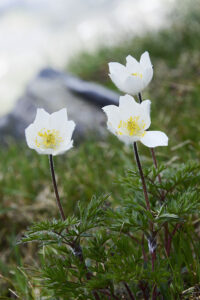
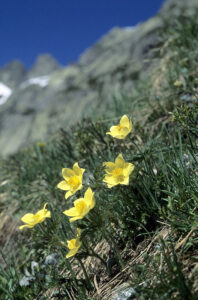
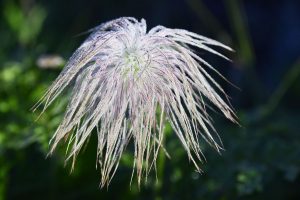
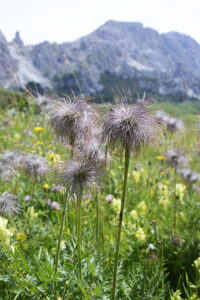
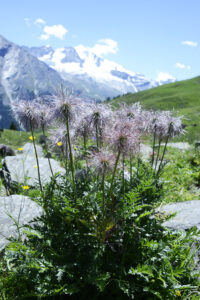
It is distributed from the western Alps eastwards to the Carpathians and mountains on the Balkan Peninsula, growing on dry calcareous soils, from the lower valleys up to altitudes around 2,000 m, in the western Alps occasionally up to 2,150 m.
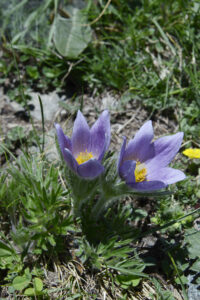
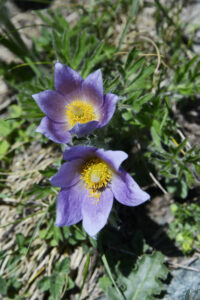
The generic name is a diminutive of rana (’frog’), thus ’little frog’, referring to the fact that many buttercup species grow in wet areas, where frogs live. The English name refers to the butter-yellow flowers of many species, and the tiny ‘cup’, formed by the petals. The alternative name crowfoot was given in allusion to the tripartite leaves of some species, which somewhat resemble a bird’s foot, whereas spearwort alludes to species with long, undivided leaves.
When left unharmed, many buttercup species may cover huge areas. Grazing animals avoid them, as they contain the toxic anemonol. However, when dried as hay, the toxicity disappears.
According to an old belief, cows grazing on buttercups would produce the sweetest and most flavourful milk, rich in cream. Of course this is pure superstition, as cows avoid these plants due to their toxicity. Rather, the richness of the milk would stem from the succulent grass in the meadows.
The role of these plants in folklore and traditional medicine is described on the page Plants: Plants in folklore and poetry.
It is a central and southern European mountain plant, occurring in the central Spain, the Pyrenees, the Cevennes, the French Massif Central, the Jura, the Alps, the northern Apennines, the Carpathians, and in the northern Balkans. In the Alps, it is found up to elevations around 2,100 m.
The specific name is Latin, meaning ‘with leaves like aconite’.
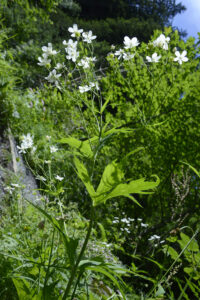
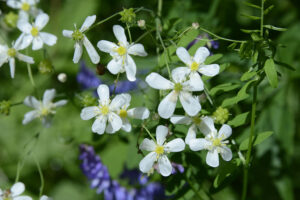
This species is partial to calcareous areas with a long snow-cover, leaves developing under the snow and appearing as soon as the snow melts. It is very common in the Alps, and is also found in the Pyrenees, the Apennines, and the Carpathians, growing in grasslands and stony areas at altitudes between 1,300 and 3,000 m, occasionally occurring as low as 600 m.
A popular German name of the plant is Gamskress (‘chamois cress’), as the chamois (Rupicapra rupicapra) is fond of eating the sharp-tasting leaves.
It was formerly believed that it would protect the chamois hunter against dizziness.
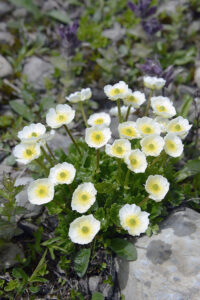
It is found in high mountains of central and southern Europe, in the Spanish Sierra Nevada, the Pyrenees, the Alps, and the Carpathians, and also in Scandinavia, north-western Russia, Svalbard, Iceland, and eastern Greenland. One variety, camissonis, is distributed across Arctic Siberia to Alaska.
In the Alps, this plant grows in moraine, among boulders, and on bare rock at altitudes above 2,300 m. It is among the highest-growing plants in the Alps, encountered at elevations around 4,275 m on Finsteraarhorn, Switzerland, and in the Grossglockner area in Austria (see also Saxifraga oppositifolia).
The glacier buttercup was first described by Swiss physician Felix Plater (1536-1614), professor of medicine in Basel.
At an early stage, it was used as a remedy to cure colds.
The specific name is Latin, meaning ‘living in ice’, derived from glacies (‘ice’).
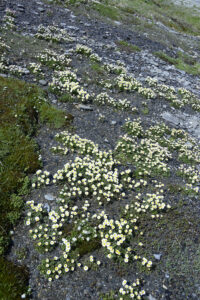
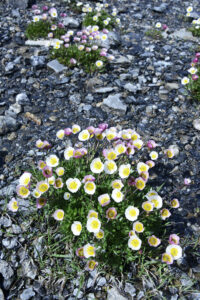
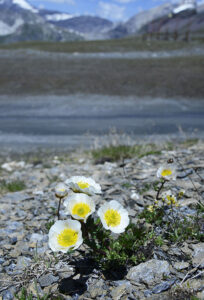
It occurs in central and southern Europe, from Denmark and the Baltic States southwards to Sicily and Greece, and thence eastwards to Ukraine and the Caucasus. It grows in deciduous forests, especially beech forests, preferably on nutrient-rich and calcareous soils, from the lowlands up to altitudes around 2,100 m.
The specific name is Latin, meaning ‘densely woolly’, referring to the stem.
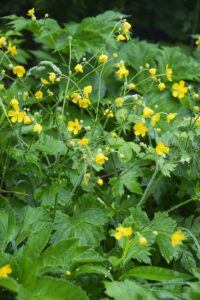
This species is widely distributed in European mountains, from the Pyrenees across the Jura Mountains and the Black Hills to the Alps and the Apennines, growing in humid grassy and rocky areas at altitudes from 600 to 2,800 m. It is very common in the Alps.
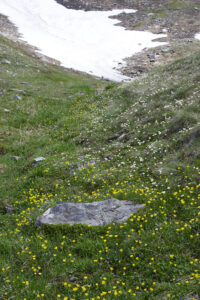
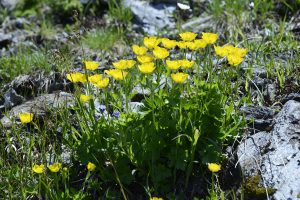
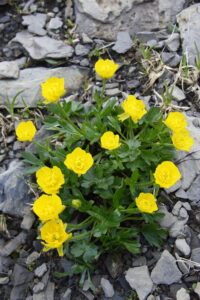
A stout plant, sometimes growing to more than 1 m tall, stem much-branched, usually smooth, lower stem leaves to 15 cm across, deeply cleft into 5-7 toothed segments, upper leaves alternate, gradually reduced in size up the stem, segments lanceolate-linear, to 5 cm long and 1 cm wide. Inflorescences are terminal and axillary, much-branched, flowers solitary, long-stalked, to 2.5 cm across, petals white, stamens yellow.
This plant very much resembles R. aconitifolius (above), but the leaf segments are usually much broader and less serrated.
The specific name refers to the leaves, which resemble those of plane trees (Platanus).
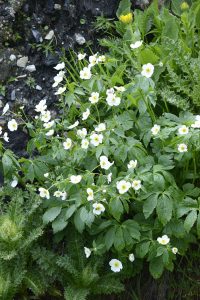
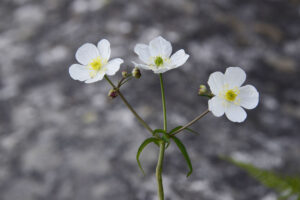
This species grows in open areas of low vegetation, from central Germany southwards to the southern Alps. It is restricted to the lower parts of the mountains.
The specific name is Latin, meaning ‘serpent’, but in a botanical context ‘creeping’.
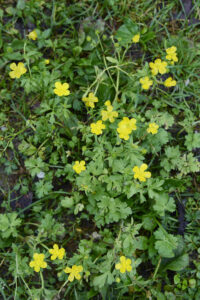
The leaves of these plants are large and divided two or three times, and the flowers are arranged in many-branched clusters, in which the numerous, often brightly coloured stamens have taken over the role as display apparatus instead of the petals, which are often small or absent.
The generic name is a Latinized form of the Ancient Greek name of these plants, thaliktron. The popular name stems from the similarity of the leaves to those of the genuine rues (Ruta).
This species is widespread in Europe, except the north-western parts, and across the European part of Russia to western Siberia and Kazakhstan. It is quite common in the Alps, growing on nitrogen-rich, alkaline soils, in forests and shrubberies at lower elevations, and in meadows at higher altitudes. It has been encountered up to about 2,300 m.
A yellow dye was previously extracted from the leaves, utilized to dye wool. The German folk names Brusttee (‘breast tea’) and Lungenkraut (‘lungwort’) attest to its usage in traditional medicine, where it was also used against malaria.
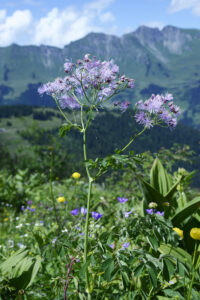
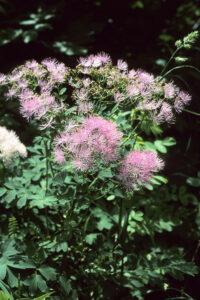
The generic name is derived from Old High German troll (‘globular’), ultimately from the Latin trulleum (‘a round washbasin’), like the common name referring to the flower shape of common globe-flower (below).
Due to the firmly compressed petals, pollination of the flowers can neither be done by the wind, nor by larger insects, but is solely carried out by 4 species of small flies of the genus Chiastocheta, family Anthomyiidae, which mate in the flowers, eat pollen and nectar, and complete their larval development in the seeds.
Common globe-flower thrives in nutritious wet meadows, distributed in almost all of Europe, eastwards to western Siberia. It is declining drastically in almost the entire area, but is still rather common in the Alps, up to altitudes around 3,000 m.
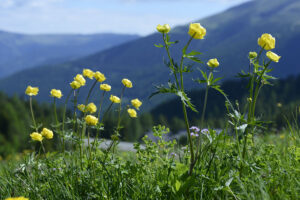
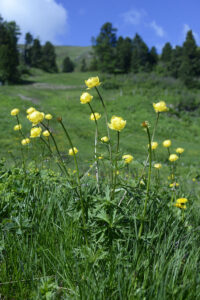
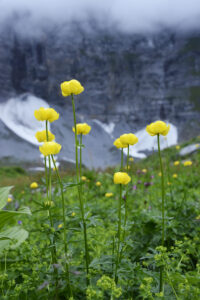
According to Roman naturalist Pliny the Elder (23-79 A.D.), the name is derived from resedo (‘I soothe’), presumably referring to some medicinal usage of the genus.
The common name is derived from French mignonnette, from mignon (‘dainty’, i.e. ‘elegant’ or ‘pretty’), and the diminutive suffix ette. The name was applied to Reseda odorata, a plant with greyish-green flowers, which emit a delicious fragrance.
This species is widespread, ranging from the British Isles and Denmark southwards to the Canary Islands, Western Sahara, and the Arabian Peninsula, eastwards to Kazakhstan and Kyrgyzstan, with an isolated occurrence in South Africa. It has been widely introduced elsewhere, especially in North America and Australia. In the latter country, it has been declared a noxious weed and a pest in agricultural crops.
It often grows in nutritious grasslands, but is also a colonizer of wastelands, stony slopes, roadsides, railway gravel, and quarries, from sea level to elevations around 2,000 m.
Since the first millennium B.C., its leaves and flowers have been used to make a yellow dye called weld, although its close relative R. luteola was more commonly used for this purpose.
The specific name is Latin, meaning ‘yellow’, referring to the flowers.
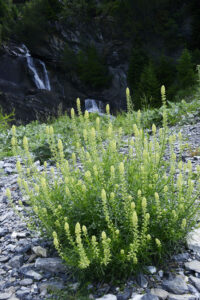
Subfamily Amygdaloideae contains about 55 genera, including tribes Amygdaleae (plum-like species of the genus Prunus), Maleae (apple-like species of the genera Malus, Sorbus, Crataegus, Cotoneaster etc.), and Spiraeeae (Spiraea-like plants, including the genera Spiraea and Aruncus).
Subfamily Dryadoideae contains a single tribe, Dryadeae, with 4 genera.
Subfamily Rosoideae contains 6 tribes with about 43 genera.
The generic name is derived from the Arabic alkemelych (‘alchemy’), applied to the plant in allusion to its reputation as a magical herb. The popular name stems from the shape of the leaves, resembling the scalloped edges of a lady’s mantle. In Germany, the name Unser Frauwen Mantel (‘Our Lady’s Mantle) first appeared in herbal books in the 1500s.
The leaf shape also resembles the imprint of a lion’s paw or a bear’s paw, giving rise to the folk names lion’s foot and bear’s foot. The name nine hooks refers to the margin of the leaf, which has often 9 lobes, with finely toothed margins.
It is a prostrate plant, usually below 10 cm tall, occasionally to 30 cm. The silky-hairy stems grow from a basal rosette, leaves palmate with up to 7 lanceolate leaflets, smooth above and densely hairy below, tip toothed. Stem leaves similar, alternate. Inflorescences are terminal or axillary panicles, flowers greenish-yellow, to 4 mm across, with 4 sepals and no petals.
Benedikt Marti (1505-1574), Latinized Benedictus Aretius, was a Swiss theologian, philosopher, and botanist, based in Bern. In 1561, he published the result of an investigation of the flora on two mountains in Berner Oberland, Stockhorn and Niesen. One of the described plants was alpine lady’s mantle, which he called Heptaphyllum montanum (‘mountain seven-leaf’). He also mentioned a German folk name of the plant, Schafsuppen (‘sheep’s soup’), indicating that it was highly esteemed as fodder for sheep. Marti’s major theological works were Examen theologicum (1557), and Theologiæ problemata (1573).
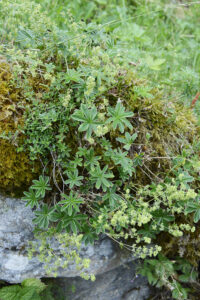
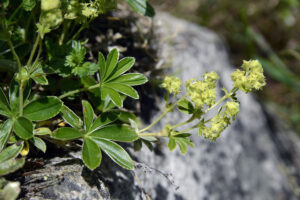
The generic name is the classical Greek word for these plants.
The distribution of this plant is given above. It grows in nutritious alkaline soils in shadowy forests and shrubberies, often along strems. In the Alps, it occurs from the lowlands up to altitudes around 1,500 m.
Formerly, native peoples of north-western North America used the plant medicinally as a diuretic, as a poultice, and to treat blood diseases, smallpox, and sore throat.
The specific name is derived from Ancient Greek dis (‘twice’) and oikos (‘house’), thus ‘two houses’, referring to the fact that the plant has male and female flowers on separate plants.
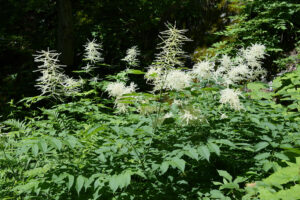
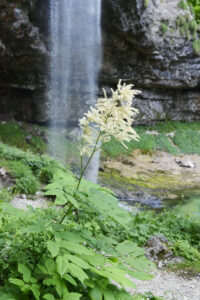
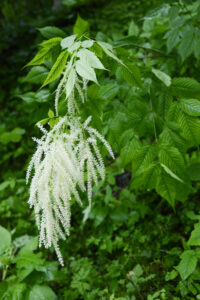
Most species have white flowers, some pink or red. The fruit is a pome, berry-like, with a swollen receptacle, enclosing 2-5 carpels.
The generic name is derived from the Latin cotonium, a corruption of cydonium malum, which means ‘the apple (or quince) from Kydonia’ (a town in Ancient Greece, situated on the northern coast of Crete, near present-day Chania), combined with the suffix aster (‘resembling’), thus ‘the fruit which resembles cotonium’.
A number of species are described on the page Plants: Himalayan flora 3.
Inflorescences are small, axillary panicles with 2-7 stalked, bell-shaped flowers, to 8 mm across, bracts lanceolate, downy, sepals broadly triangular, blunt, to 1.5 mm long, petals white or pink, rounded, to 3 mm across. The fruits are dark red, smooth, rounded, to 8 mm in diameter. The seeds are spread in bird droppings, or by rodents burying the fruits as a food cache.
The native range of this plant is temperate areas of Europe, and from Turkey eastwards via the Caucasus and the Himalaya to Korea. It grows in forests, shrubberies, and open areas, on various substrates. In the European mountains, it may be encountered up to elevations around 2,500 m.
The specific name is Latin, meaning ‘most complete’, which may refer to the entire leaves.
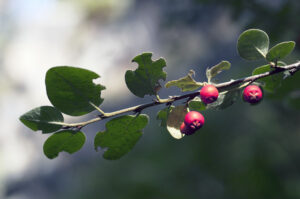
The generic name is derived from Ancient Greek drys (‘oak’), alluding to the leaves, which, with a bit of imagination, resemble oak leaves. The dryads were nymphs in Greek mythology, who lived in the sacred oak trees.
It is quite common in the Alps, growing at elevations between 1,200 and 2,500 m, occasionally down to 500 m and up to 3,000 m.
The leaves are very characteristic, elliptic, dark green and smooth above, with numerous lateral veins, white-felted below, to 4 cm long and 2 cm wide, margin down-curved, with very many blunt teeth. The flowers are to 4 cm across, petals elliptic, snow-white, to 1.8 cm long and 1.2 cm broad, stamens numerous, bright yellow. At maturity, the styles develop white, feathery hairs – an adaptation to wind dispersal.
The geological Dryas periods are named after this species due to great quantities of its pollen found in cores, dating from these periods, when it was much more widely distributed than today.
Formerly, in the Alps, tea made from the leaves was used medicinally.
The specific name is derived from Ancient Greek octo (‘eight’) and petalon (‘petal’), referring to the flower, which usually has 8 petals.
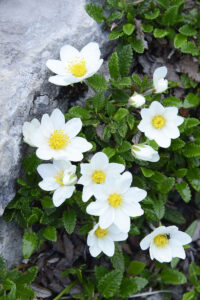
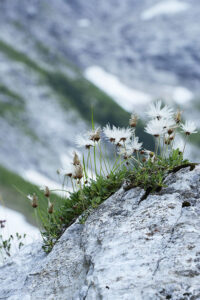
At maturity, a silky tuft of brownish hairs grows from the styles, which has given rise to a popular German name of these plants, Petersbart (‘Peter’s beard’), probably referring to St. Peter.
German Dominican friar, philosopher, scientist, and bishop Albertus Magnus (c. 1200-1280) says: “Wo diss wurtz in dem huse ist, da mag der tufel nicht schaffen, und fluhet sie, und darumb ist sie gebenedeyt für alle anderen wurtzeln.” (‘If you have this herb in your house, the Devil does not want to be there and flees from it, and this is why this herb is better than all other herbs’).
The generic name is the classical Latin name for avens. The English name is derived from the Latin avencia, which was the name of a kind of clover. Why it was applied to these plants is not known.
Initially, this plant is prostrate, below 10 cm tall, later, at fruiting time, up to 40 cm. Basal leaves are stalked, lyre-shaped, pinnate, with a large, rounded-toothed, terminal leaflet, to 6 cm long and 5 cm wide, much larger than the lateral leaflets. Stem leaves are small, tripartite, like the stem densely silky-hairy. Flowers are terminal, solitary or 2 together, to 4 cm across, petals 6-8, golden-yellow. The hairs growing out from the style remain on the plant for a long time.
The root of this species was formerly used in traditional Austrian medicine as tea for treatment of rheumatism, gout, infections, and fever.
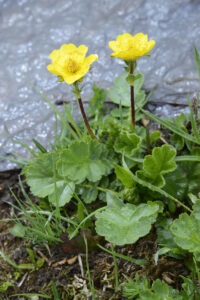

It is distributed in the Alps, the Carpathians, and in mountains on the Balkan Peninsula. In the Alps, it is most common at altitudes between 2,500 and 3,200 m, but may be encountered down to 1,500 m and up to 3,800 m.
The specific name is Latin, meaning ‘creeping’.
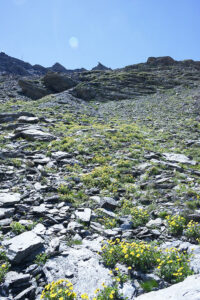
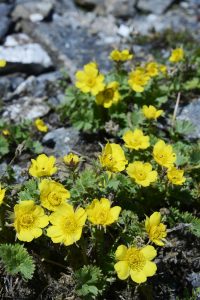
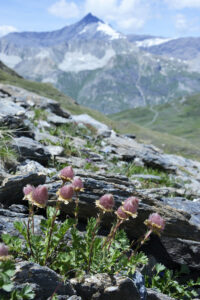
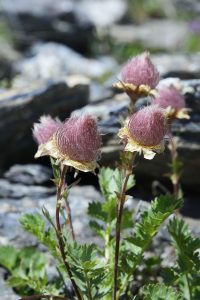
Members are found almost worldwide, although they tend to avoid most tropical areas and deserts. About 25 species occur in the Alps.
The generic name is derived from the Latin potens (‘strong’ or ‘powerful’) and illa, a diminutive suffix. It alludes to the alleged powerful tonic and astringent properties of these plants.
The popular name is an Anglicization of the Latin quinque (‘five’) and folium (‘leaf’), thus ‘five-leaf’ – a name, which was originally referring to those species of the genus, which have 5 finger-like leaflets. Today, however, the name refers to the entire genus, and also to marsh-cinquefoils, genus Comarum.
The specific name is Latin, meaning ‘resembling Alchemilla‘, referring to the leaves, which resemble those of Alpine lady’s mantle (Alchemilla alpina), see above.
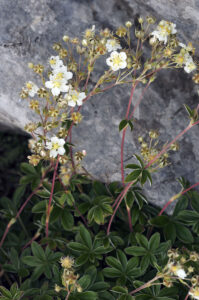
The specific name is Latin, meaning ‘shining’. It is not clear what it refers to.
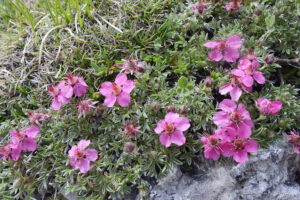
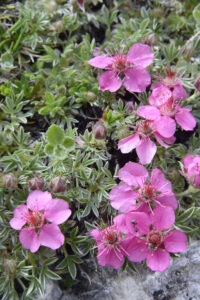
These plants are widely distributed in temperate and subtropical regions of the Northern Hemisphere, with a few tropical species in eastern Africa and southern and south-eastern Asia. Elsewhere, numerous species and cultivars are grown as ornamentals.
The generic name is the classical Latin name of these plants, derived from Ancient Greek rhodon (‘rose’), probably of Persian origin.
It occurs in mountains of central and southern Europe, eastwards across Ukraine to Kazakhstan, but is absent in the Caucasus. It favours humid areas of open forests, shrubberies and grasslands, in the Alps found from the lower valleys up to elevations around 2,500 m – the only rose in the Alps growing at such high altitudes.
The hips were formerly used in traditional folk medicine.
The specific name refers to the pendulous hips. A popular German name is Rose ohne Dornen (‘thorn-less rose’), naturally alluding to the few or absent prickles.
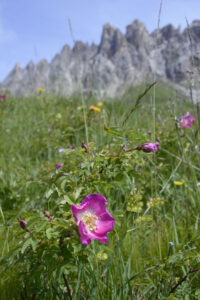
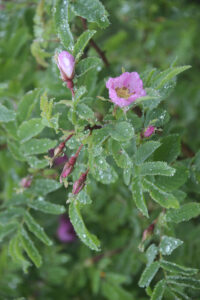
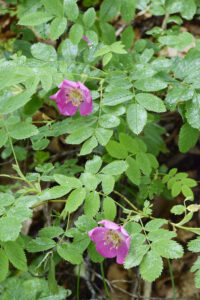
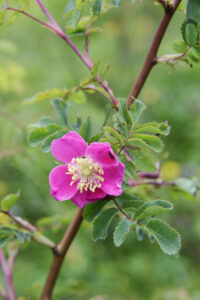
Leaves are simple, lobed, or pinnately divided. Flowers are in clusters, and the fruit is a pome, with a swollen receptacle, enclosing 2-5 carpels.
The name whitebeam is from Middle English witbeam (‘white tree’), alluding to the colour of the hairs on the underside of the leaves of some species. The alternative name mountain-ash refers to the leaves of some species, whose leaves resemble those of the common ash (Fraxinus excelsior).
The generic name is the classical Latin word for whitebeams, rooted in the Indo-European sor (‘red’), alluding to the fruits of most species.
The common name whitebeam is derived from Middle English witbeam (‘white tree’), alluding to the colour of the hairs on the underside of the leaves of some species. The alternative name mountain-ash refers to the leaves of some species, whose leaves resemble those of the common ash (Fraxinus excelsior).
A medium-sized tree, reaching a height of about 10 m, occasionally to 20 m, bark blackish-grey with white spots, smooth for many years, eventually furrowed. Leaves are short-stalked, alternate, dark green above, white-felted below, shape variable, mostly ovate or elliptic, but sometimes oblong or lanceolate, to 12 cm long and 9 cm wide, widest below the middle, with 10-15 lateral pairs of veins, tip blunt or pointed, margin finely serrated.
The inflorescence is a hemispherical umbel, to 12 cm in diameter, the individual flower to 1,5 cm across, sepals triangular, fleshy, densely white-hairy, petals 5, white or pink, anthers cream-colored or brown. The fruit is scarlet or yellowish-red, ellipsoid or globular, resembling a tiny apple.
In former days, the fruits were sometimes ground and mixed with flour, to make a sweet-tasting bread, and they were also used to make brandy or vinegar. In traditional medicine they were utilized for cough, diarrhoea, and catarrh. They were also used as pig feed.
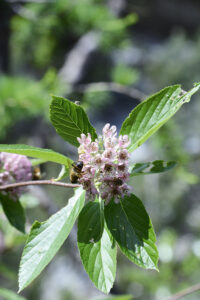
A red dying agent was formerly obtained from the root of dyer’s woodruff (A. tinctoria).
The generic name is derived from the Latin asper (‘rough’), and the suffix ulus, which denotes something diminutive, thus ‘the litte rough one’, referring to the rough stems of some of these plants.
The strange names squinancywort and squinsywort, variants of quinsywort, were given in allusion to the usage of Asperula cynanchica against quinsy, a painful inflammation or abscess of the tonsils and surrounding tissues, caused by bacterial infection and often accompanied by fever.
This species is native from the Alps southwards to the Mediterranean and North Africa, and thence eastwards to the Caucasus. It is a steppe plant, partial to grasslands on warm, dry, calcareous soils.
The specific name is Latin, meaning ‘having awns’. It is not clear what it refers to.
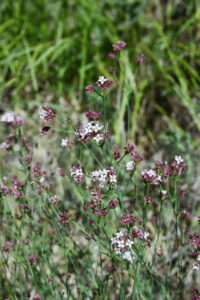
It closely resembles the former species, and hybrids are frequent between them. It may be identified by the pink or white flowers, whose petals are often recurved. It spreads vegetatively thorugh underground runners.
As explained above, this plant was formerly used medicinally to treat quinsy, hence its common names.
The specific name also refers to this treatment. It is derived from Ancient Greek kynankhe (‘a dog’s collar’ or ‘a bad kind of sore throat’), i.e. quinsy.
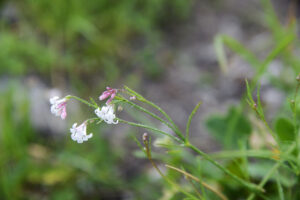
The generic name is derived from the Latin crux (‘cross’), like the English name referring to the leaves, which are often arranged cross-wise up the stem.
It is distributed in the major part of Europe and in northern Turkey, the Caucasus, Iran, and the western Himalaya, growing in meadows and shrubberies, and along roads and riverbanks, usually on calcareous soils, from sea level to elevations around 1,700 m.
Previously, this plant was much utilized in traditional medicine for ruptures, rheumatism, dropsy, and headache.
The specific name is derived from the Latin levis (‘light’) and pes (‘foot’). It might refer to the smooth base of the plant.
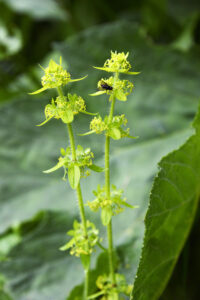
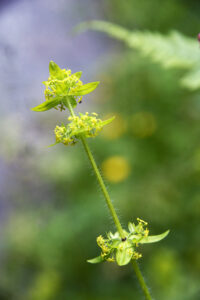
Inflorescences of the genera Salix and Populus are catkins, consisting of numerous tiny flowers, clustered around a central axis, each flower surrounded by papery bracts.
The catkins are erect, and the flowers are pollinated by bees and other insects.
The generic name is the classical Latin name of willows. It is related to sal, meaning ‘salt’, but the original meaning was ‘grey’ or ’dirty’. Formerly, salt was not as white, as we see it today, but dirty-grey – like the colour of the bark of grey willow (S. cinerea).
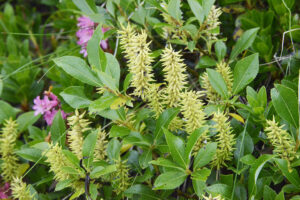
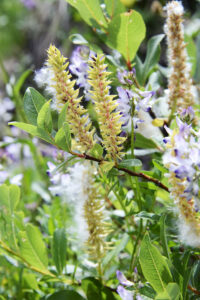
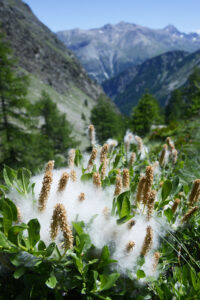
It grows among rocks or in areas of newly melted snow, on humid, nutritious soils. It is native to subarctic and temperate regions of the Northern Hemisphere, in the southern parts of the distribution area restricted to mountains, from the Pyrenees via the Jura Mountains, the Alps and the Apennines to the Carpathians. In the Alps, it occurs at altitudes between 1,300 and 3,200 m.
The specific name is Latin, meaning ‘with a small net’, referring to the nerves on the leaves.
A local name in the Salzburg area is Schneehünlweide (‘ptarmigan willow’), referring to the ptarmigan (Lagopus muta) often seeking shelter among these bushes.
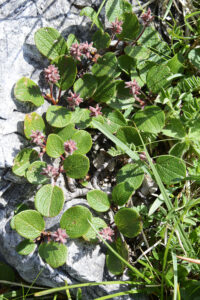
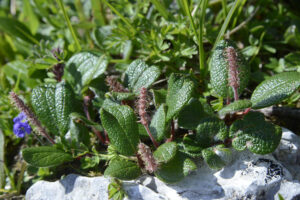
It is distributed in European mountains, including the Pyrenees, the Jura, the Alps, the Apennines, the Tatra, the Carpathians, and mountains in the northern part of the Balkan Peninsula. It grows among rocks and in scree at elevations between 2,000 and 2,700 m.
The specific name is Latin, meaning ‘blunt’, referring to the leaves.
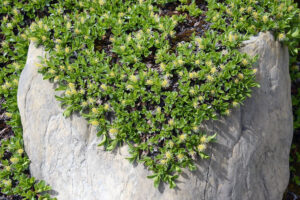
The generic name is probably the classical Latin name of these plants. The common name is derogative, meaning something like ‘inferior toadflax’, alluding to the leaves of some European members of Thesium, whose leaves resemble those of the true toadflax (Linaria).
Some authorities place this genus in the family Thesiaceae.
This plant is widespread in Europe, from Sweden and the Baltic countries southwards to the Mediterranean and Turkey, eastwards to Ukraine and northern Iran, growing in grassy and rocky areas on alkaline soils.
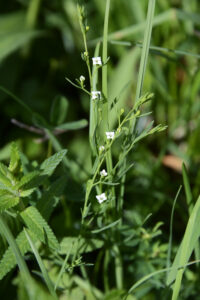
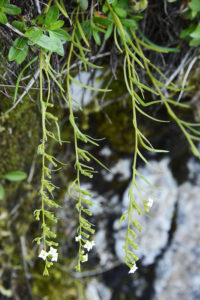
The generic name is derived from Ancient Greek mikros (‘small’) and anthos (‘flower’), thus ‘with small flowers’.
In the Arctic, star saxifrage is found down to sea level, whereas in the Alps it mainly grows at elevations between 1,200 and 3,000 m. It is partial to very wet places, mainly along streams and in springs, and also on wet rocks.
The leaves are clustered in a basal rosette, fleshy, shining, ovate, obovate, or wedge-shaped, to 5 cm long and 2 cm wide, margin toothed at the tip. Stems erect, reddish, often glandular-hairy, to 30 cm long. The inflorescence is a loose panicle with up to 15 star-shaped flowers, sepals lanceolate, reddish, reflexed, petals 5, white, lanceolate, to 7 mm long, with two yellow or red spots near the base. Style and anthers are red or yellow. The flowers are pollinated by flies.
The specific name is Latin, meaning ‘star-like’, referring to the flowers.
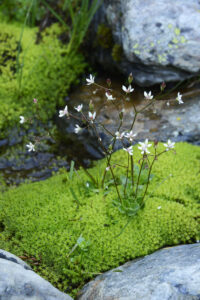
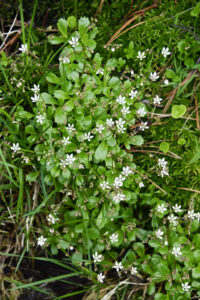
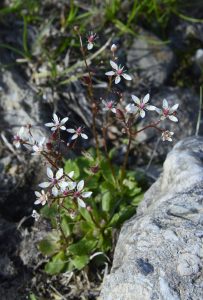
Literally, the generic name means ‘stone-breaker’, from the Latin saxum (‘rock’) and frangere (‘to break’). Rather than referring to the rocky habitat of many saxifrage species, it probably indicates the usage of one or more species for treatment of kidney stones and the like.
It has a circumpolar distribution, found in Alaska, Canada, Greenland, Iceland, Scandinavia, the British Isles, and northern Russia, and in mountains of central Europe, from the Pyrenees across the Alps to the Tatra Mountains and the Balkans. In the Alps, it grows at altitudes between 600 and 3,100 m.
A local name in Tyrol, Austria, is Warzenkraut (‘wart herb’), as it was formerly believed that its juice could remove warts.
The specific name is derived from Ancient Greek aei (‘forever’) and zoion (‘a living being’), thus ‘living forever’, which refers to the evergreen foliage, combined with the suffix oides (‘resembling’), alluding to S. paniculata (below), previously called S. aizoon, which also has evergreen leaves.
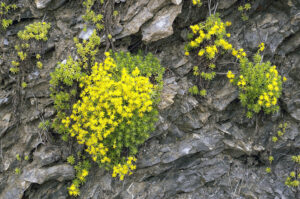
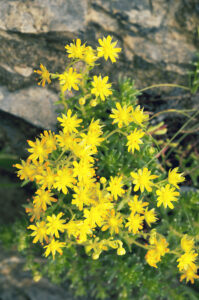
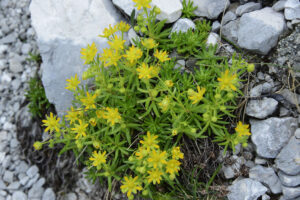
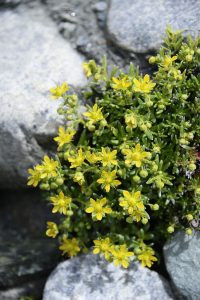
This species is restricted to the Alps, the northern Apennines, and the Pyrenees, growing at altitudes between 1,400 and 3,000 m. It mainly grows on damp rocks or in gravel along streams, only on acid soils.
The specific name, derived from the Latin asper (‘rough’ or ‘coarse’), refers to the bristly-haired leaves.
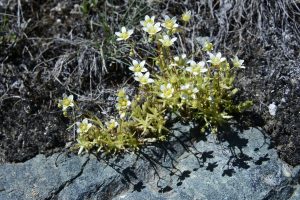
This plant grows in gravel and grasslands, and among rocks, mainly on calcareous soils, distributed in the Pyrenees, the Alps, the Apennines, the Carpathians, and in Balkan mountains. In the Alps, it has been encountered at altitudes between 500 and 3,050 m.
The specific name is Latin, meaning ‘blue-grey’, referring to the leaves.
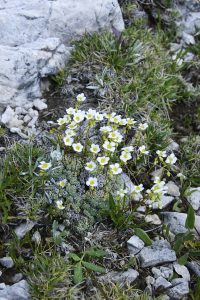
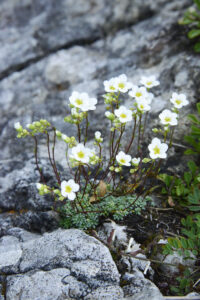
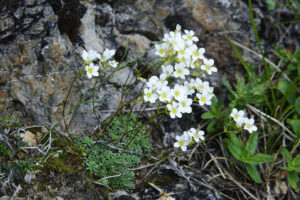
It forms loose mats with flowering stems to 12 cm tall, bearing panicles of 3-8 flowers, white, dull yellow, greenish, or sometimes reddish or purplish, petals about 5 mm long. The leaves are variable, glandular-hairy, mostly wedge-shaped, to 5 mm long, with 3-5 lobes, which are furrowed above.
It is widely distributed, found in the Pyrenees, Auvergne, the Alps, the Apennines, the Carpathians, the Tatra, the Sudetes, mountains of the Balkan Peninsula, Turkey, the Caucasus, and the Elburz Mountains of northern Iran. It grows in rocky areas, usually at altitudes between 500 and 3,000 m, occasionally higher.
The literal translation of the Latin specific name is ‘ploughed’, but in this context it means ‘furrowed’, alluding to the leaves.
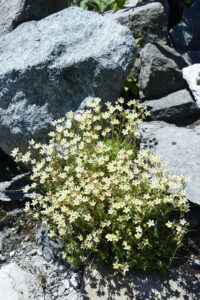
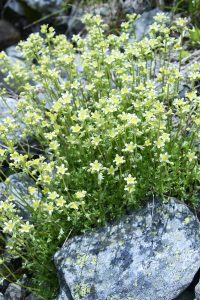
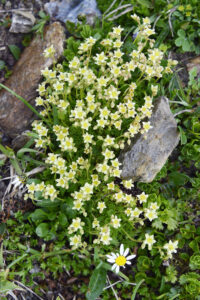
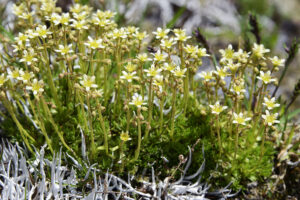
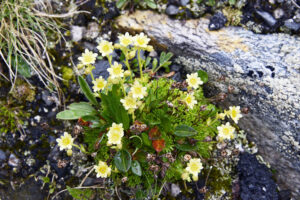
Basal leaves are in a rosette, blade strap-shaped, dark green, fleshy, shining, glandular-hairy, to 7 cm long and 1.2 cm wide, stem leaves smaller, spatulate. Inflorescences are loose panicles from the leaf axils, with numerous flowers, petals linear-lanceolate, lemon yellow or coppery-orange, to 8 mm long.
The specific name is Latin, with many meanings, including ‘changed’, ‘variegated’, ‘removed’, or ‘spoiled’. It is not known what it refers to.
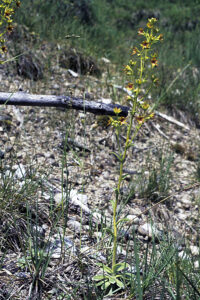
This species thrives in cold places and has been found at two extreme locations: the Kaffeklubben Island in northern Greenland (83°N), the most northerly plant locality in the world, and on the Dom Peak in Valais, Switzerland, at an altitude of 4,505 m, the highest elevation of any flowering plant in Europe.
It is very common in the Arctic, found from sea level up to elevations around 1,000 m. Further south, it occurs in numerous mountain areas, in North America in the Rocky Mountains, Washington State, and Oregon, and on some of the highest peaks in New England, in Europe in Scandinavia, the British Isles, the Pyrenees, the Alps, the Carpathians, and in Balkan mountains, in Asia in various mountain ranges southwards to Tibet and northern China. In Central Asia, it has been encountered up to altitudes around 5,600 m.
The Inuit pick the flowers for food, calling them aupilaktunnguat, which means something like ‘bold spot’, presumably alluding to the vivid colour of the flowers, compared to the surrounding, often rather bleak landscape. The petals are said to be bitter at first, but soon become sweet. In Iceland, a popular name of the plant is lambagras (‘lamb grass’), as it is often eaten by sheep and other domestic animals.
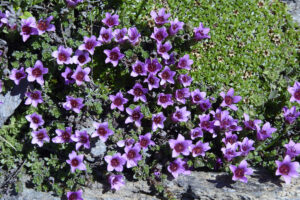
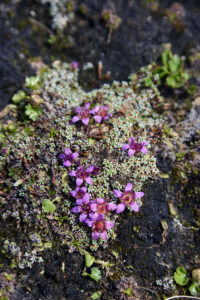
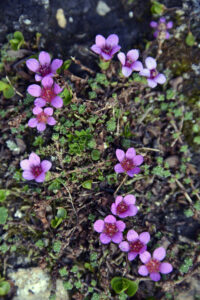
It has a very wide distribution, found in montane areas from the Pyrenees across the Alps and the Apennines to the Carpathians and mountains on the Balkan Peninsula, and thence eastwards to the Caucasus. It also occurs from Norway eastwards to western Siberia, and in Iceland, Greenland, and north-eastern North America. A very common plant in the Alps, growing in grassy areas and on rocks on calcareous soils, at altitudes between 1,000 and 3,400 m.
The specific name indicates that the inflorescences are panicles. The obsolete specific name is derived from Ancient Greek aei (‘forever’) and zoion (‘a living being’), thus ‘living forever’, alluding to the evergreen foliage.
A folk name in Pinzgau, Austria, is Silbermies (‘silver moss’), alluding to the lime-encrusted leaves, which may shine like silver.
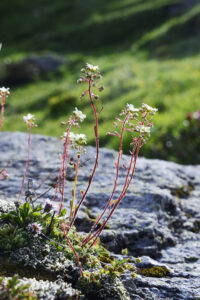
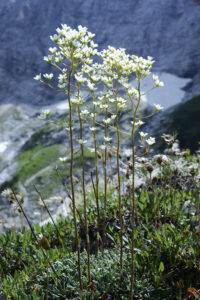
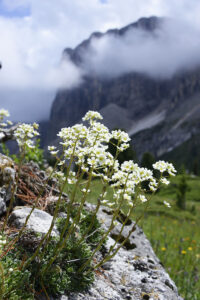
A plant of shady forests, damp rocks, and streamsides, growing at elevations between 700 and 2,500 m. It is indigenous to mountains of Europe, from central Spain and the Pyrenees via the French Massif Central to the Alps, the Apennines, and the Balkans, and further east across Turkey to the Caucasus.
In the Alps, this species was formerly utilized for lung diseases, and in Switzerland it is sometimes still known as Lungechrut (‘lung wort’).
The specific name is Latin, meaning ‘with round leaves’.
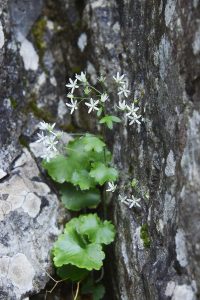
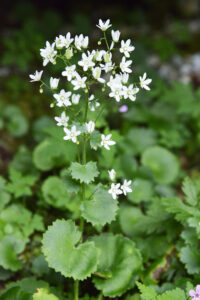
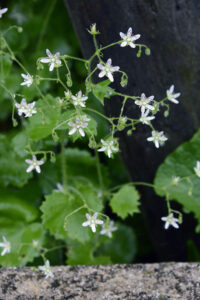
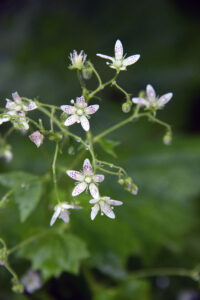
Previously, the family was much larger, comprising about 275 genera with more than 5,000 species. Following genetic research, the major part has been moved to other families, especially Plantaginaceae and Orobanchaceae.
These plants have large flowers with 5 petals and 4-5 stamens, the filaments usually dense woolly-haired and often brightly coloured.
The generic name is probably a corruption of barbascum, from the Latin barba (‘beard’), in allusion to the shaggy foliage of many of the species, or maybe to the often woolly filaments. In his book The Popular Names of British Plants, Richard Chandler Prior (1809-1902) states that the word mullein was moleyn in Anglo-Saxon, and malen in Old French, derived from the Latin malandrium, i.e. the malanders (leprosy). He continues: “The term malandre became also applied to diseases of cattle, to lung diseases among the rest, and the plant being used as a remedy, acquired its names of mullein and bullock’s lungwort.”
The role of these plants in folklore and traditional medicine is described on the page Plants: Plants in folklore and poetry.
This species is distributed from central and southern Europe eastwards to western Siberia, southwards to Morocco, the Caucasus, and Kazakhstan. In the Alps, it grows in shrubberies and on open dry slopes, mostly on calcareous soils, from the lower valleys up to altitudes around 1,400 m.
The specific name probably refers to leaves of the mealy mullein resembling those of the lampwick plant (Phlomis lychnitis), whose hairy leaves were used as lamp wicks.
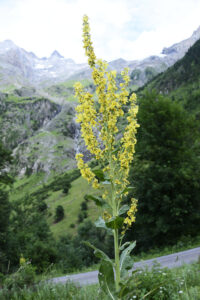
The generic name is the classical Greek name of the laurel tree (Laurus nobilis), given in allusion to the leaves of D. laureola, whose leaves resemble laurel leaves.
In Greek mythology, Daphne was a naiad, who was loved by the god Apollon. He pursued her until she grew exhausted and cried out to Gaia for help. The goddess transformed her into a laurel tree, which Apollon then adopted as his sacred plant.
In the Himalaya, paper is produced from the inner bark of a local species, D. bholua, named paper plant. This species is presented on the page Plants: Himalayan flora 3.
Flowers sprout directly on the branches near the tip, just below the new leaf buds, early in spring before the leaves unfold. This phenomenon, called cauliflori, usually only takes place in tropical plants. Flowers are strong-scented, pink, rose-coloured, or purple, rarely white, to 1.5 cm across, 4-lobed. They are much visited by insects early in spring.
The fruits are berry-like, bright red, rarely yellow, to 1 cm across. They are extremely toxic to humans, as they contain the alkaloids mezerein and daphnin. Certain fruit-eating birds, including thrushes, are immune to the poison, dispersing the seeds in their droppings. Handling the fresh twigs can cause rashes and eczema in some people.
This species occurs from the major part of Europe eastwards to central Siberia and Kazakhstan, southwards to the Mediterranean, Turkey, and northern Iran, usually growing on calcareous soils. In the southern parts of its distribution area, it is confined to mountains, in the Alps found up to altitudes around 2,600 m.
Dried bark of root and branches was formerly used in an ointment to induce discharge in ulcers, and for rheumatism. The plant was also utilized for chronic skin problems, toothache, and as chewing gum to cure a paralysed tongue.
An Austrian legend relates that when Jesus entered Jerusalem, riding on a donkey, people not only strewed palm leaves in front of him, but also branches of February daphne.
The specific name is derived from the classical Persian name of the plant, mazaryun. The common name alludes to the early flowering of the plant, which may take place already in February-March.
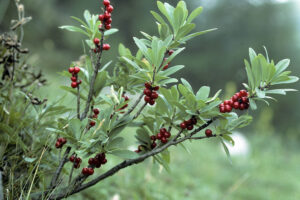
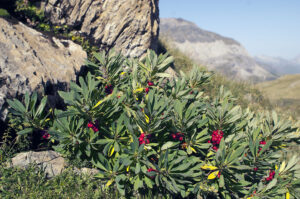
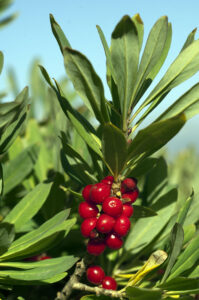
This plant is restricted to the Alps, from the France eastwards to northern Slovenia, growing in open forests, shrubberies, and grassy areas, preferably on calcareous soils, at altitudes between 1,000 and 3,000 m.
The specific name is Latin, meaning ‘striped’, alluding to the finely striped corolla tube.
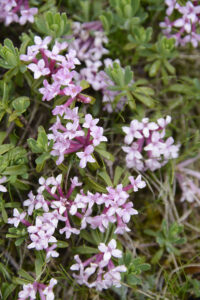
Previously, these plants had been placed in the families Liliaceae, Melanthiaceae, and Nartheciaceae.
The generic name was given in honour of British engineer and botanist Thomas Tofield (1730-1779), who contributed significantly to the work Flora Anglica (1762), written by British botanist and apothecary William Hudson (1730-1793).
It is distributed from Germany, Estonia, and European Russia southwards to Spain, Italy, the northern Balkans, and Ukraine. There is also a population on the Swedish island Gotland. It grows in humid areas, in meadows and among rocks, on calcareous soils. In the Alps it may be found up to elevations around 2,100 m.
The specific name refers to a row of small bracts at the base of the calyx.
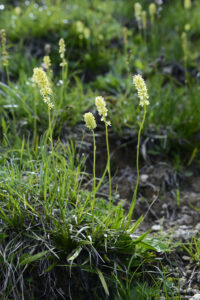
Previously, many more plants were placed in this family, but following genetic research they have been moved to other families, especially Lamiaceae.
The origin of the generic name, and with that the English name, is explained in various ways. According to one authority, it is derived from the Latin verber (‘rod’ or ‘stick’). It seems that Swedish naturalist Carl Linnaeus (1707-1778) applied the name to the plant in allusion to its stiff, rod-like branches and stem. Others claim that it stems from verbena, the Roman name of altar plants. A third source says that it is derived from the Celtic word ferfaen, meaning ‘to drive away stones’, alluding to the belief that the plant was an effective remedy for kidney stones.
Stem erect, stiff, angular, branched, to 75 cm tall, downy-hairy or smooth, leaves opposite, short-stalked, elliptic or ovate, toothed, lobed, or sometimes deeply pinnate, to 8 cm long and 5 cm wide, hairy along the veins on the underside. Inflorescences are terminal spikes on the branches, sepals greenish-purple, fused, glandular-hairy, to 4 mm long, corolla variously coloured, whitish, reddish, pale purple, or bluish, downy-hairy, petals fused into a tube, to 8 mm long, lobes notched.
It grows in sunny areas, along trails, in hedges, in fallow fields, and around villages, preferably on slightly acidic, sandy or clayey soils. In the Alps, it may be found up to altitudes around 1,100 m.
The specific name is derived from the Latin officina (‘workshop’ or ‘office’), and the suffix alis, thus ‘made in a workshop’. However, in a botanical context, the word denotes plants species that were sold in pharmacies due to their medicinal properties.
Vervain tea is taken for headache, migraine, nausea, urinary tract infection, and menstrual irregularities, and also for anxiety and nervous tension. It is an excellent remedy for poor appetite and has been used successfully to treat anorexia nervosa. It is also an effective diuretic, and it is said to improve liver and gall bladder functions.
The role of this species in folklore and traditional medicine is described on the page Plants: Plants in folklore and poetry.
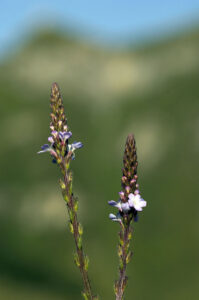
In the past, the genera Sambucus and Viburnum constituted the family Sambucaceae, but were then transferred to the honeysuckle family (Caprifoliaceae), and later to the moschatel family (Adoxaceae), which is today called Viburnaceae. The previously accepted genera Sinadoxa and Tetradoxa have been merged with Adoxa.
The generic name is derived from Ancient Greek sambuca, the classical name of an ancient instrument of Asian origin. Presumably, the soft pith was removed from the twigs to make flutes. The common name is derived from Anglo-Saxon aeld, meaning ’fire’ – the hollow stems were used to kindle a fire.
The popular names pipe tree and bore tree stem from the habit of removing the pith of elder branches to produce pipes. The same procedure would make pop-guns, which were popular among small boys. English herbalist Nicholas Culpeper (1616-1654) writes: ”It is needless to write any description of this, since every boy that plays with a pop-gun will not mistake another tree for the elder.”
Elders in folklore, and their usage in folk medicine, is described on the page Plants: Plants in folklore and poetry.
This species, encompassing 5-7 subspecies, is easily identified by its bright red berries. It is very widely distributed, found in Europe, northern Temperate Asia, eastwards to Japan, and across Canada and northern United States, growing in various habitats, including open forests, along rivers, and in other open areas, generally in moist conditions. It is found up to elevations around 2,000 m.
Red-berried elder is a shrub, growing to 6 m tall, the stems having a soft, pithy centre. The leaves are compound, with 5-7 leaflets, to 16 cm long, lanceolate or narrowly ovate, the margin irregularly toothed. When crushed, they emit an unpleasant smell. Inflorescences are flat-topped or slightly conical, terminal clusters of tiny flowers, pink when in bud, white, cream, or yellowish when opened. They are fragrant, much visited by butterflies, and in America by hummingbirds.
The entire plant, including raw berries, is poisonous, but the berries are eaten by birds, which disperse the seeds in their droppings. The berries are edible after being cooked, and they were formerly much consumed by American native peoples, who also utilized it medicinally for a variety of ailments, including diarrhoea, colds, cough, and skin problems, and also as an emetic.
The specific name indicates that the inflorescences are racemes.
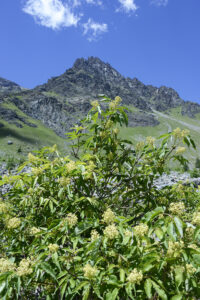
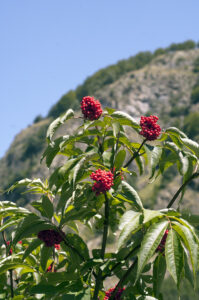
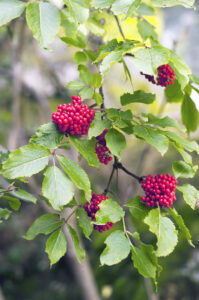
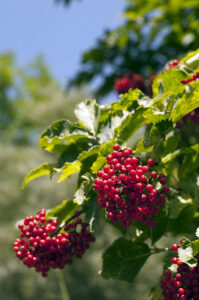
In 1991, the well-preserved body of a Stone Age hunter was discovered in a glacier in the Alps. Ötzi the Iceman, as he was dubbed, died about 5,300 years ago, presumably caught in a snowstorm. His arrow shafts were made from wood of viburnum and dogwood (Cornaceae, see below). (Source: K. Spindler 1994. The Man in the Ice)
The generic name is the classical Latin name of V. lantana (below).
The specific name is the classical Italian name of the wayfaring tree.
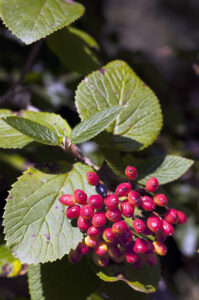
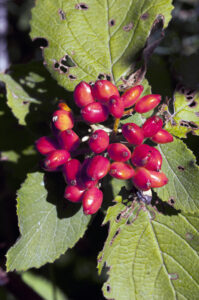
The flowers have 5 very unequal petals, the lower one larger, spurred. The fruit is a capsule, splitting along 3 seams.
The generic name is the classical Latin term for violets. The name pansy is explained on the page Plants: Plants in folklore and poetry.
It is widespread in subarctic and temperate regions of the Northern Hemisphere, in Europe, Asia, Alaska, and north-western Canada, with isolated occurrence in Colorado and northern Sumatra. In southern regions of the distribution area, it is restricted to mountains, where it thrives on nutritious, calcareous soils, at altitudes between 2,000 and 3,000 m.
Hieronymus Harder (1523-1607) was a German botanist and teacher, who collected plants in the Swabian Alps and around Lake Constance. From 1562 he produced about 12 volumes of plant collections, known as Herbarium vivum. In these volumes, missing parts of the specimens were represented by coloured drawings. One of the presented plants was Viola biflora, which he called Gel Berg Violen (‘yellow mountain violet’).
The specific name is Latin, meaning ‘two-flowered’, although the flowers are mostly single, only occasionally two together.
Formerly, a local Austrian name of the plant was Milchkraut (‘milkwort’), as the farmers believed that if the cows had eaten it they would yield more milk.
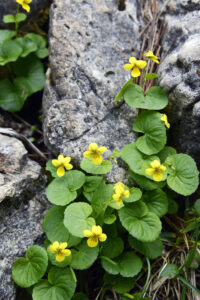
This plant is found in the Alps, from France eastwards to Slovenia, and also in the Balkan Peninsula, southwards to Macedonia. It grows in grassy areas, mostly at altitudes between 1,600 and 2,400 m, but may occasionally be encountered down to 500 m and up to 3,000 m.
The specific name is Latin, meaning ‘having a spur’, alluding to the long spur of this species.
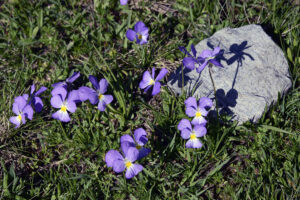
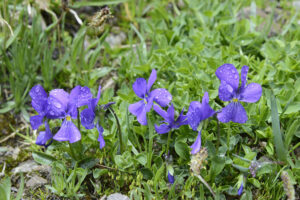
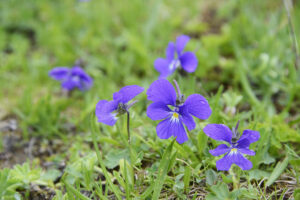
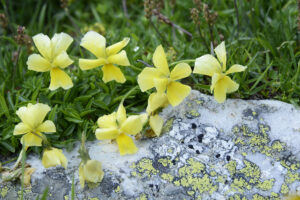
This plant is restricted to the Pyrenees and the Cordillera Cantábrica of northern Spain, growing in meadows and rocky areas, at altitudes between 1,000 and 2,500 m.
The specific name is Latin, meaning ‘having a horn’, alluding to the shape of the spur.
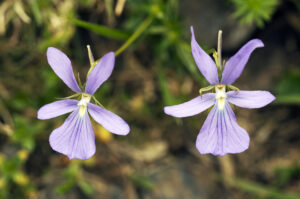
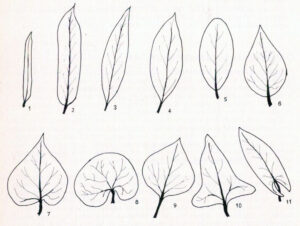
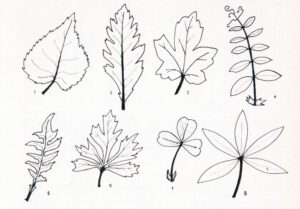
Male organs in a flower are called stamens, divided into a long, thread-like filament and a terminal anther, from which the pollen, tiny grains containing the male cells, is spread.
The female organ is called a carpel, comprising the egg-producing ovary, an often long, columnar style, on the end of which sits the stigma, which receives the pollen during fertilization.
